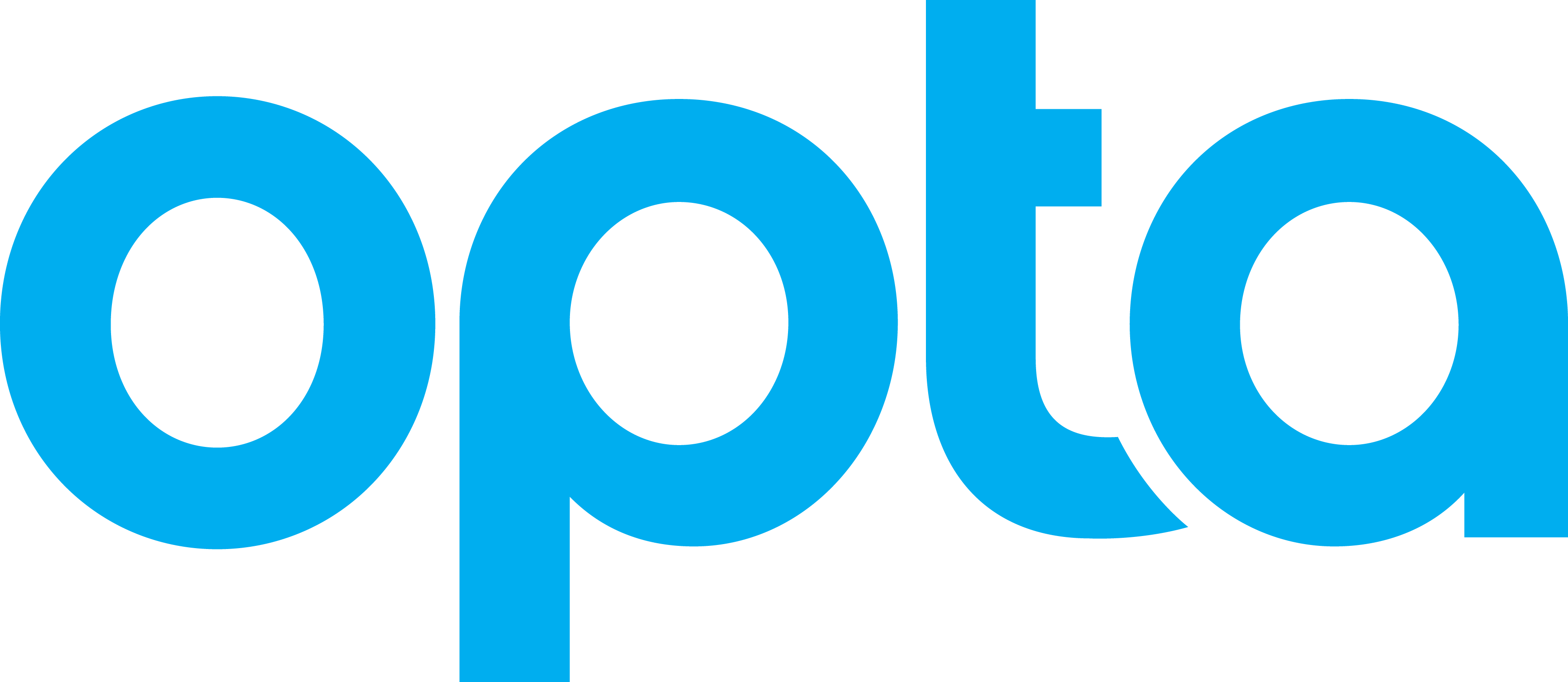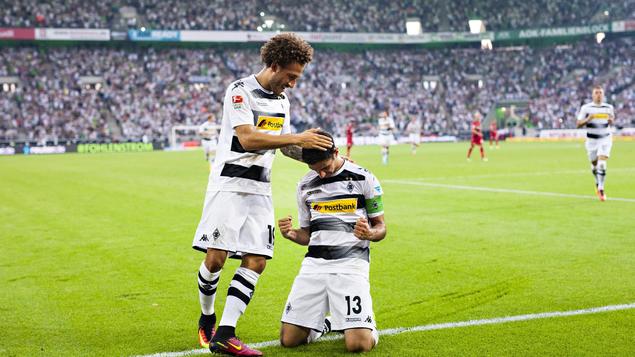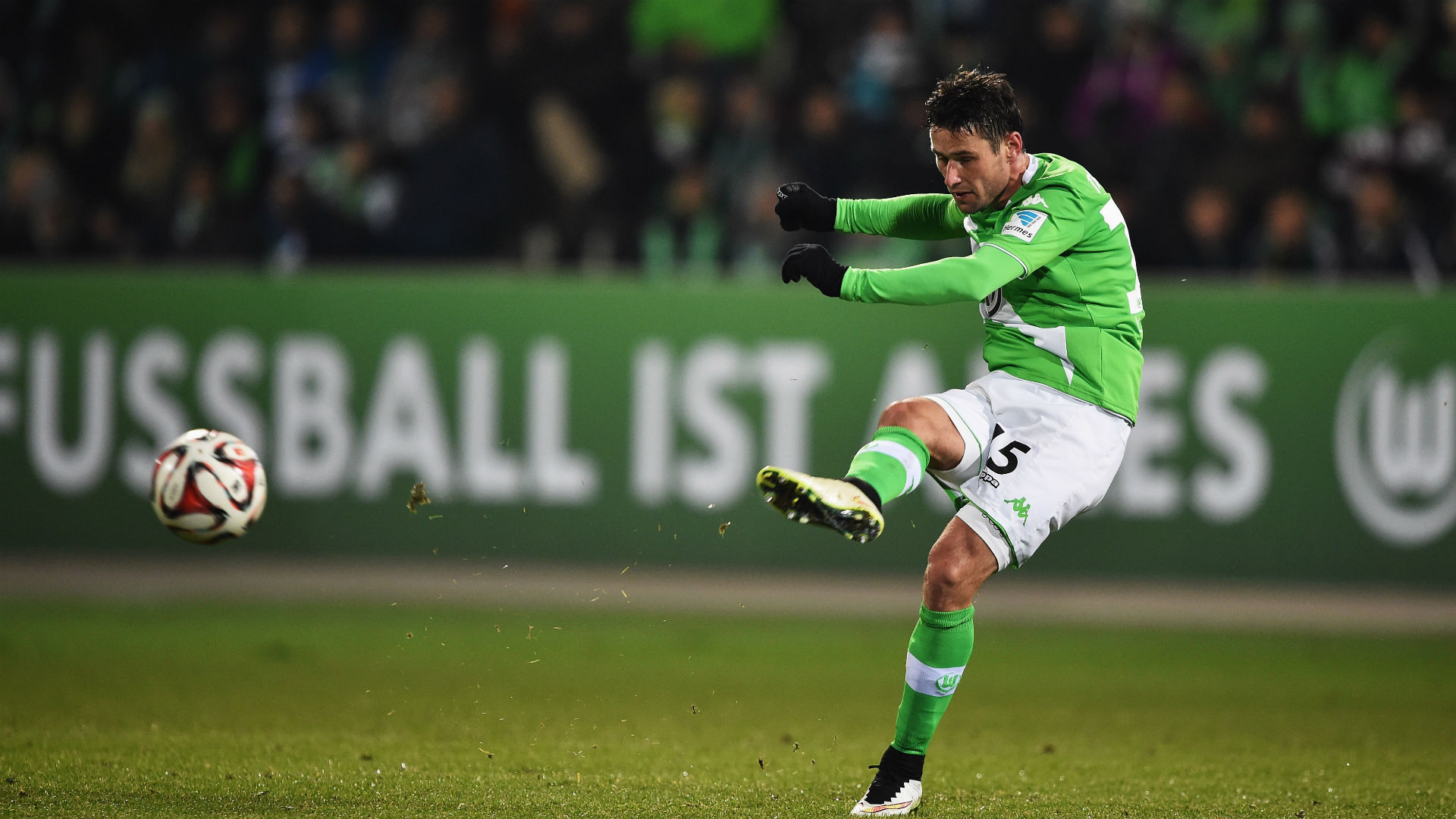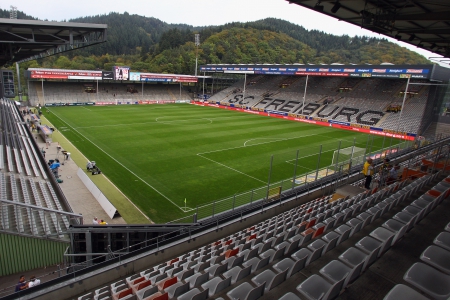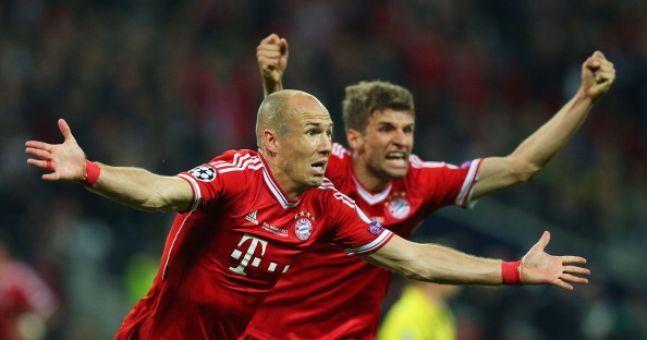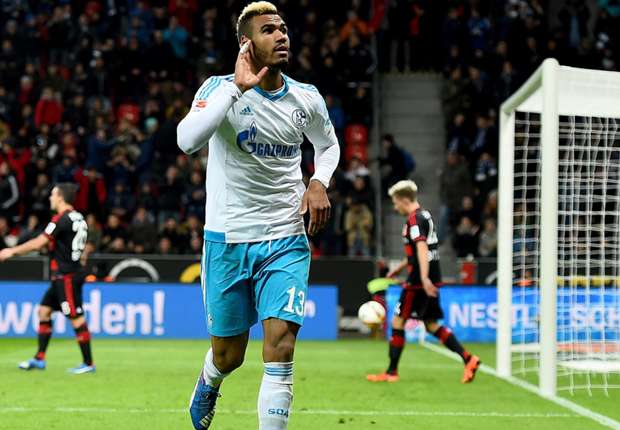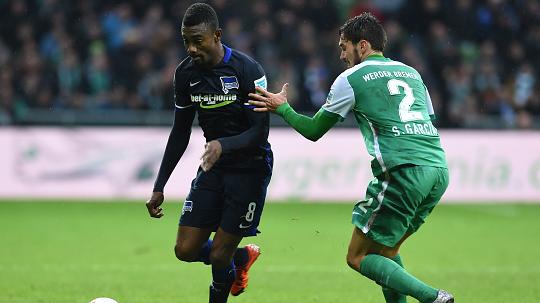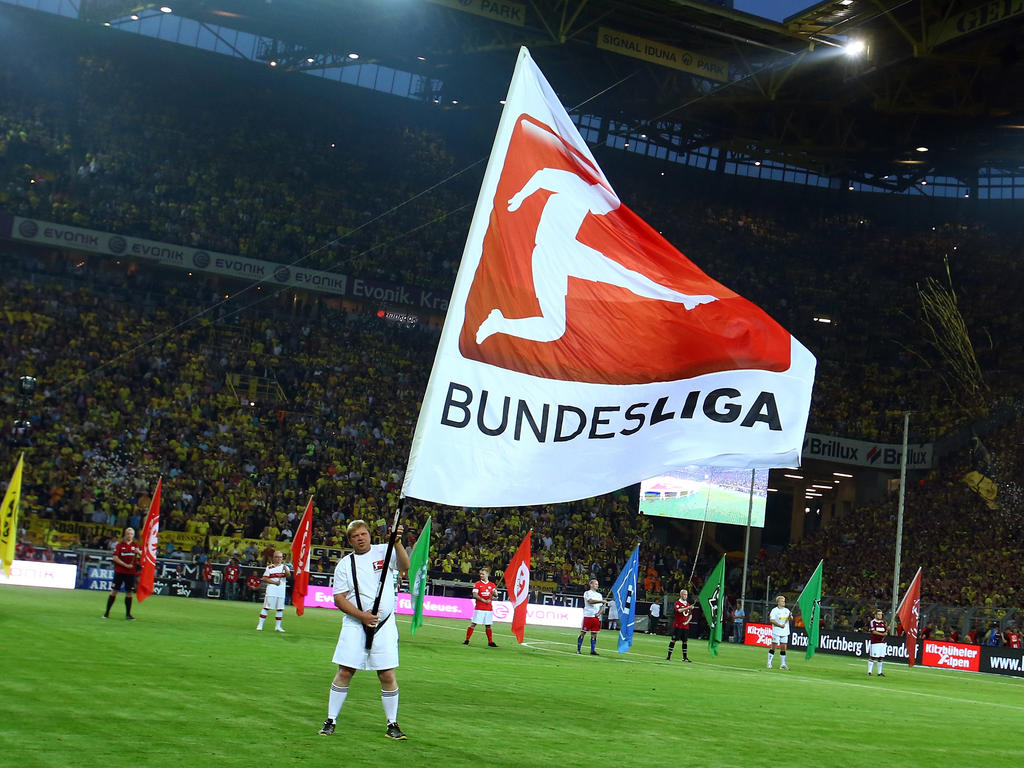Yo. Mailbag time, ya'll. You guys ask the questions, I answer. I'm short on time this week though, so no lengthy stories or rants or screeds. Unlike every other mailbag, I aim to keep this one tight. Here we go!  Whu...? Let me see that. Ah, I see what happened. You want Spielverlagerung, not Statsbomb. They are a few doors back up the S block. Buncha German and Austrian lookin' dudes, you can't miss 'em. *waves*
Whu...? Let me see that. Ah, I see what happened. You want Spielverlagerung, not Statsbomb. They are a few doors back up the S block. Buncha German and Austrian lookin' dudes, you can't miss 'em. *waves*  Nope. There should be, but thus far we have absolutely nothing. Nada. Bupkiss. It's time for the Premier League, the data companies, and the websites who pay to publish this stuff to sort it out and be more fan friendly, because interest is higher than it's ever been and continues to grow. Whether that will actually happen any time soon... not my department.
Nope. There should be, but thus far we have absolutely nothing. Nada. Bupkiss. It's time for the Premier League, the data companies, and the websites who pay to publish this stuff to sort it out and be more fan friendly, because interest is higher than it's ever been and continues to grow. Whether that will actually happen any time soon... not my department.  Burke looks like a huge talent. Red Bull as an organization are exceptional at developing talent, and have one of the best youth pipelines in world football. I think it's a great move and look forward to seeing how he does in the future.
Burke looks like a huge talent. Red Bull as an organization are exceptional at developing talent, and have one of the best youth pipelines in world football. I think it's a great move and look forward to seeing how he does in the future.  Menace at the moment. I know people are trying to increase their follower count and graphical work is one of the best ways to do this, but we've crossed a bombardment threshold this season. It would be better if specific Twitter accounts were setup to host the bulk of the graphics and people just highlight the really interesting stuff on their own accounts, where they add the insight I started following them for in the first place. And yes, I say this as someone with a noisy Twitter account already who is fully aware that I probably drive some people away when I tweet too much. In a related note, you'll see a new StatsBomb account in the coming months strictly to host radar images. Pot, kettle, STFU. Anyway, that's just my opinion. YMMV.
Menace at the moment. I know people are trying to increase their follower count and graphical work is one of the best ways to do this, but we've crossed a bombardment threshold this season. It would be better if specific Twitter accounts were setup to host the bulk of the graphics and people just highlight the really interesting stuff on their own accounts, where they add the insight I started following them for in the first place. And yes, I say this as someone with a noisy Twitter account already who is fully aware that I probably drive some people away when I tweet too much. In a related note, you'll see a new StatsBomb account in the coming months strictly to host radar images. Pot, kettle, STFU. Anyway, that's just my opinion. YMMV.  Reading between the lines, someone has been less than impressed with Vincent Janssen's Premier League start. Give him a season and see how he does. Since it was Daniel Levy doing the negotiating, Janssen should actually be easy to shift somewhere else at the end of the season if he doesn't work out. Remember though, Janssen just turned 22 in June, meaning he still has a couple of years of development time before he hits his peak and now has to adjust to a much tougher defensive league. Spurs didn't buy a finished product here and it's a bit harsh to expect him to perform like that right from the start.
Reading between the lines, someone has been less than impressed with Vincent Janssen's Premier League start. Give him a season and see how he does. Since it was Daniel Levy doing the negotiating, Janssen should actually be easy to shift somewhere else at the end of the season if he doesn't work out. Remember though, Janssen just turned 22 in June, meaning he still has a couple of years of development time before he hits his peak and now has to adjust to a much tougher defensive league. Spurs didn't buy a finished product here and it's a bit harsh to expect him to perform like that right from the start.  He is a legitimately great dribbler. So was Bolasie. Neither of them managed to translate that particular attribute into much scoring while at Crystal Palace. Whether that is the fault of Pardew's system or some hole in their games, I do not know. We'll find out more from watching how Bolasie does at Everton. I thought Zaha's move to Manchester United would be good for him, as it would give him a great teacher to add the final polish to his game in Alex Ferguson. That never happened and I honestly think Zaha's development has suffered for it.
He is a legitimately great dribbler. So was Bolasie. Neither of them managed to translate that particular attribute into much scoring while at Crystal Palace. Whether that is the fault of Pardew's system or some hole in their games, I do not know. We'll find out more from watching how Bolasie does at Everton. I thought Zaha's move to Manchester United would be good for him, as it would give him a great teacher to add the final polish to his game in Alex Ferguson. That never happened and I honestly think Zaha's development has suffered for it. 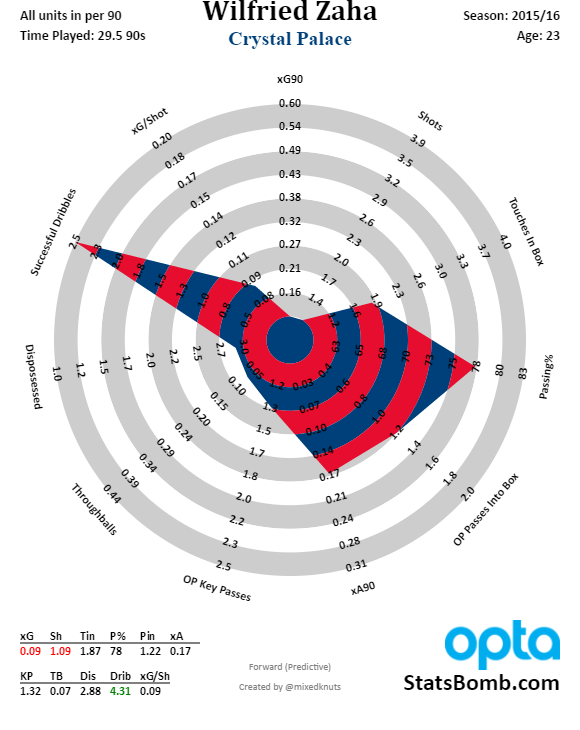
 This is practically a follow-up question on Zaha's development. The first part of it, I don't know the answer to, but we know for certain that elite managers have huge influence on player stats and development. Picture it like this. Clone a smart person. Now send one of your clones to Oxford and the other to local community college. Which one do you think is going to have the better development trajectory? The same thing happens with footballers. If you listen to what they say, time and again you hear how incredible it is to work with top coaches because they teach you so much. Important realization: Most of football is community college at best. I keep reading articles by allegedly smart people saying the impact of top coaches will shrink in the Premier League. In reality, it is THE EXACT OPPOSITE. As talent levels equalize, the marginal impact of top coaches increases dramatically. However, it's all relative to the level of talent inside of a league. If everyone has a great coach, then you might barely notice. But if half the league has top coaching talent and the other half does not, the bad coaches and their team performance will stick out like sore thumbs. Coach influence actually looks like this:
This is practically a follow-up question on Zaha's development. The first part of it, I don't know the answer to, but we know for certain that elite managers have huge influence on player stats and development. Picture it like this. Clone a smart person. Now send one of your clones to Oxford and the other to local community college. Which one do you think is going to have the better development trajectory? The same thing happens with footballers. If you listen to what they say, time and again you hear how incredible it is to work with top coaches because they teach you so much. Important realization: Most of football is community college at best. I keep reading articles by allegedly smart people saying the impact of top coaches will shrink in the Premier League. In reality, it is THE EXACT OPPOSITE. As talent levels equalize, the marginal impact of top coaches increases dramatically. However, it's all relative to the level of talent inside of a league. If everyone has a great coach, then you might barely notice. But if half the league has top coaching talent and the other half does not, the bad coaches and their team performance will stick out like sore thumbs. Coach influence actually looks like this: 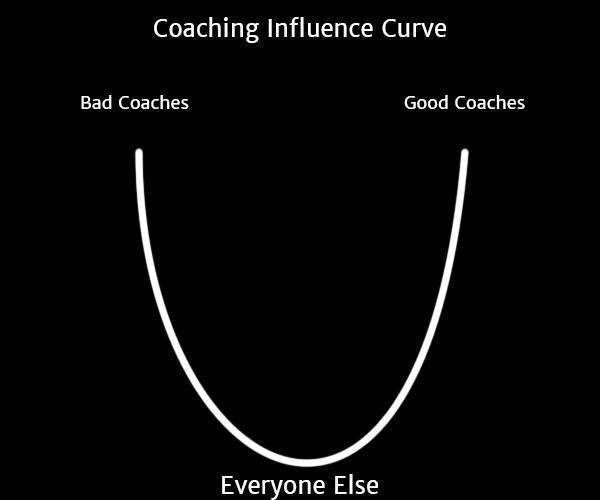 Most of the population exists in the center of the curve, so it's hard to notice what they do. If you change out one average coach with another average coach, you end up with similar performance. However, as you move along to either side of the curve, you get massive effects. Particularly bad coaches will send good players and teams spiraling into awful performance, while top coaches can turn average players into league winners. ('Sup Claudio.) Systems matter. Styles of play matter. Communication matters. Attention to detail matters. The problem with most statistical analysis is that it tends to view outliers in populations as something to be discarded, whereas in elite sports you really really care about outliers as long as you can explain why they are outliers in the first place.
Most of the population exists in the center of the curve, so it's hard to notice what they do. If you change out one average coach with another average coach, you end up with similar performance. However, as you move along to either side of the curve, you get massive effects. Particularly bad coaches will send good players and teams spiraling into awful performance, while top coaches can turn average players into league winners. ('Sup Claudio.) Systems matter. Styles of play matter. Communication matters. Attention to detail matters. The problem with most statistical analysis is that it tends to view outliers in populations as something to be discarded, whereas in elite sports you really really care about outliers as long as you can explain why they are outliers in the first place.  Center backs and goalkeepers.
Center backs and goalkeepers.  A tremendous young creative player who is already very good in the world's toughest league.. He's actually one of the first guys I flagged up at Brentford when I got access to Segunda data as a top young player we should be interested in. A week later Real Madrid bought him for 4M euros. A season and a half later, and he doesn't look out of place around Bale and Ronaldo, which tells you exactly how good he is already at age 20.
A tremendous young creative player who is already very good in the world's toughest league.. He's actually one of the first guys I flagged up at Brentford when I got access to Segunda data as a top young player we should be interested in. A week later Real Madrid bought him for 4M euros. A season and a half later, and he doesn't look out of place around Bale and Ronaldo, which tells you exactly how good he is already at age 20. 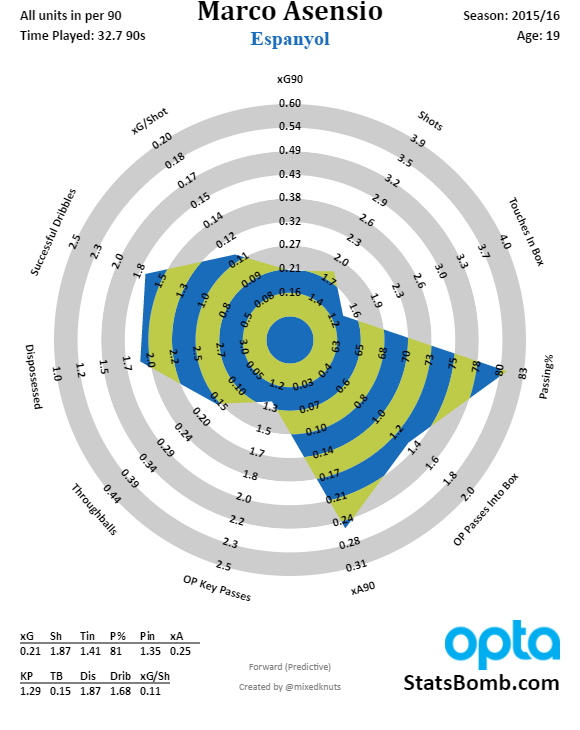
 From a personal perspective, I would love to see both Yoann Barbet and Maxime Colin from Brentford play in the Premier League. Colin was the best right back in that league last year and ready right now. Barbet is still developing, but has pace, is left-footed and might be the best passing center back in the Championship.
From a personal perspective, I would love to see both Yoann Barbet and Maxime Colin from Brentford play in the Premier League. Colin was the best right back in that league last year and ready right now. Barbet is still developing, but has pace, is left-footed and might be the best passing center back in the Championship.  I think the quality striker list went: Morata, Lacazette, Draxler, ... Perez. We got to Perez because Vardy chose not to move, Morata was never really available and Lacazette and Drax both look like they will cost over £60M each. That's just not Wenger's style. Maybe Asano is amazing, we'll see a lot of that at Stuttgart this season. The market for center forwards turned completely stupid this season and it might stay that way forever, which means undervalued guys will be few and far between. My view is that Wenger has misread the transfer market for years now. First he was wrong about FFP. Then he was wrong about player price inflation, meaning assets bought one or two years ago even at what he thought were inflated prices were actually tremendous value because all the new PL TV deal money had not been pumped into a system with an extremely limited supply of elite forwards. On the other hand, we know Wenger is stubborn enough to just keep at it and eventually - JUST MAYBE - he'll end up being right in his contrarian stance. At that point he'll sit back, give you that coy smile, and wait for everyone to acknowledge that he's always been a genius. Meanwhile, a decade will have passed since Arsenal actually had an elite center forward in the lineup, and fans will still feel like they live in perpetual Arsenal groundhog day. [Edit: People are taking this a bit more literally than I meant. Assume RVP was the last one and Wenger remains unwilling to ever stump up enough to buy a top CF.] Or more likely, he'll retire, having continued to read the market wrong, and also having missed his window where the league was soft enough to win if he would have JUST Mustafi I like, but don't love. Solid passer, good game reader, and very good in the air. Last year at Valencia was one of his worst seasons and he was still decent, but Valencia were a bit of a catastrophe overall. I'm not sure he's a better outright defender than Gabriel Paulista, but he's far more likely to be able to start play from center back, which eases the burden on Xhaka and Cazorla in bigger games. Speaking of Arsenal players, I watched a lot of Alex Iwobi last year. Like a lot a lot, including a ton of academy games for [reasons]. I liked what I saw, but even I did not think he would be quite this good at his age.
I think the quality striker list went: Morata, Lacazette, Draxler, ... Perez. We got to Perez because Vardy chose not to move, Morata was never really available and Lacazette and Drax both look like they will cost over £60M each. That's just not Wenger's style. Maybe Asano is amazing, we'll see a lot of that at Stuttgart this season. The market for center forwards turned completely stupid this season and it might stay that way forever, which means undervalued guys will be few and far between. My view is that Wenger has misread the transfer market for years now. First he was wrong about FFP. Then he was wrong about player price inflation, meaning assets bought one or two years ago even at what he thought were inflated prices were actually tremendous value because all the new PL TV deal money had not been pumped into a system with an extremely limited supply of elite forwards. On the other hand, we know Wenger is stubborn enough to just keep at it and eventually - JUST MAYBE - he'll end up being right in his contrarian stance. At that point he'll sit back, give you that coy smile, and wait for everyone to acknowledge that he's always been a genius. Meanwhile, a decade will have passed since Arsenal actually had an elite center forward in the lineup, and fans will still feel like they live in perpetual Arsenal groundhog day. [Edit: People are taking this a bit more literally than I meant. Assume RVP was the last one and Wenger remains unwilling to ever stump up enough to buy a top CF.] Or more likely, he'll retire, having continued to read the market wrong, and also having missed his window where the league was soft enough to win if he would have JUST Mustafi I like, but don't love. Solid passer, good game reader, and very good in the air. Last year at Valencia was one of his worst seasons and he was still decent, but Valencia were a bit of a catastrophe overall. I'm not sure he's a better outright defender than Gabriel Paulista, but he's far more likely to be able to start play from center back, which eases the burden on Xhaka and Cazorla in bigger games. Speaking of Arsenal players, I watched a lot of Alex Iwobi last year. Like a lot a lot, including a ton of academy games for [reasons]. I liked what I saw, but even I did not think he would be quite this good at his age. 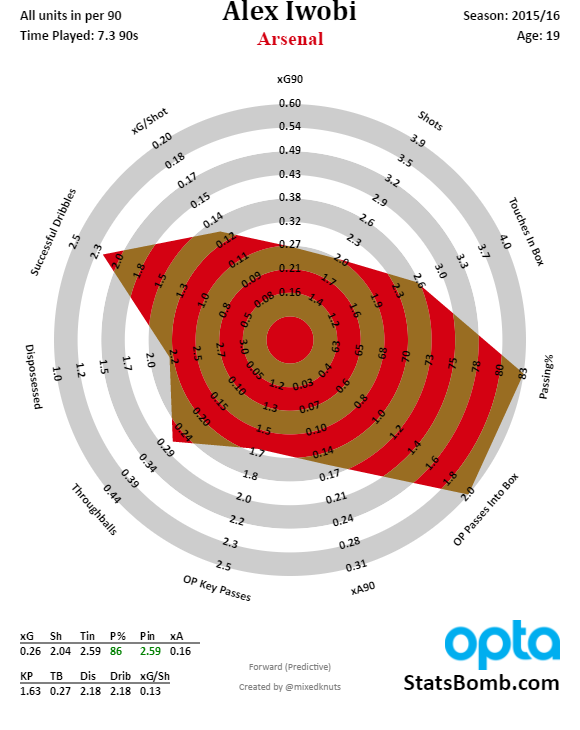
 Kieron Gillen's Darth Vader stuff (SO GOOD) Teach Like a Champion 2.0 by Doug Lemov The Long Way to a Small, Angry Planet by Becky Chambers Recently Finished Prince of Fools by Mark Lawrence A Darker Shade of Magic by V.E. Schwab Brubaker's Velvet (really good) Brian K. Vaughan's Paper Girls (really weird) Rat Queens (also really good) Rick Rememder's Deadly Class (both weird and good) Next to Start The Inner Game of Tennis
Kieron Gillen's Darth Vader stuff (SO GOOD) Teach Like a Champion 2.0 by Doug Lemov The Long Way to a Small, Angry Planet by Becky Chambers Recently Finished Prince of Fools by Mark Lawrence A Darker Shade of Magic by V.E. Schwab Brubaker's Velvet (really good) Brian K. Vaughan's Paper Girls (really weird) Rat Queens (also really good) Rick Rememder's Deadly Class (both weird and good) Next to Start The Inner Game of Tennis  Dusan Tadic would have been fairly high on the list. I'm not sure either guy fully fits with Pochettino's philosophy though, nor am I sure Spurs actually get the most out of Eriksen. Abdel Barrada looked really interesting statistically at Marseille last year. He somehow ended up at Al-Nasr this summer for a pittance. After that, maybe Alexandru Maxim? The short answer is that elite creative passers are hard to find, and that goes doubly for those who know how to press and are willing to work as hard as Poch wants.
Dusan Tadic would have been fairly high on the list. I'm not sure either guy fully fits with Pochettino's philosophy though, nor am I sure Spurs actually get the most out of Eriksen. Abdel Barrada looked really interesting statistically at Marseille last year. He somehow ended up at Al-Nasr this summer for a pittance. After that, maybe Alexandru Maxim? The short answer is that elite creative passers are hard to find, and that goes doubly for those who know how to press and are willing to work as hard as Poch wants.  Does this center back have a good injury history? If yes, then I overpay. If not, things get awkward.
Does this center back have a good injury history? If yes, then I overpay. If not, things get awkward.  He was decent at Malaga, decent at Vitesse, and couldn't get on the pitch at Everton. Somewhere along the way his development seems to have stalled. Should still be pretty good against Championship opposition, but no longer has the profile of a guy who is good enough for the Champions League.
He was decent at Malaga, decent at Vitesse, and couldn't get on the pitch at Everton. Somewhere along the way his development seems to have stalled. Should still be pretty good against Championship opposition, but no longer has the profile of a guy who is good enough for the Champions League.  For those of you who have never seen GPB, stop reading this right now and go watch the movie. It is in my top 10 favorite movies of all time, and your life is worse for not having seen the movie. Strangely, it is also one of the most underrated comedies of all time. I don't know if that's because the concept of a comedy centered around an aging assassin who heads back to his home town for his high school reunion is difficult for people to engage with or what. Is it Cusack's best movie? Man, that's hard. He's had an awesome career, studded with medium and low profile gems (Better Off Dead, The Grifters, Eight Men Out, Say Anything, Bullets Over Broadway, Being John Malkovich, High Fidelity, etc). It's almost certainly Minnie Driver's best role, and she's basically perfect here. It also deserves noting that she was Debi Newberry before she was Skylar in Good Will Hunting (also released in 1997), and she stole my heart here before I ever knew she was born with a fancy English accent. ANYWAY... I guess it never had a sequel because they couldn't figure out a good way to continue the story, and John Cusack has definitely aged past the point where he's a believable 30-something. Or maybe Cusack simply felt it was a perfectly self-contained movie (it is) that didn't need a continuance. Plus main screenwriter Tom Jankiewicz died in 2013, which is just sad. While on this topic, Con Air is another Cusack movie (also from 1997, oddly enough) that absolutely, positively should have had a sequel, and certainly would have if it had been made in this decade.
For those of you who have never seen GPB, stop reading this right now and go watch the movie. It is in my top 10 favorite movies of all time, and your life is worse for not having seen the movie. Strangely, it is also one of the most underrated comedies of all time. I don't know if that's because the concept of a comedy centered around an aging assassin who heads back to his home town for his high school reunion is difficult for people to engage with or what. Is it Cusack's best movie? Man, that's hard. He's had an awesome career, studded with medium and low profile gems (Better Off Dead, The Grifters, Eight Men Out, Say Anything, Bullets Over Broadway, Being John Malkovich, High Fidelity, etc). It's almost certainly Minnie Driver's best role, and she's basically perfect here. It also deserves noting that she was Debi Newberry before she was Skylar in Good Will Hunting (also released in 1997), and she stole my heart here before I ever knew she was born with a fancy English accent. ANYWAY... I guess it never had a sequel because they couldn't figure out a good way to continue the story, and John Cusack has definitely aged past the point where he's a believable 30-something. Or maybe Cusack simply felt it was a perfectly self-contained movie (it is) that didn't need a continuance. Plus main screenwriter Tom Jankiewicz died in 2013, which is just sad. While on this topic, Con Air is another Cusack movie (also from 1997, oddly enough) that absolutely, positively should have had a sequel, and certainly would have if it had been made in this decade.  Gayle, Yedlin, and Isaac Hayden I liked. Everything else... bleh. Rafa was a lot better when he was plucking underpriced Spanish gems out of La Liga than this motley collection of Championship retreads. He's still a good enough coach to easily get them up, but their recruitment is probably a C at best, especially given the wages a lot of these guys are going to be on. And with that, I am out of time. Check for a podcast from James and myself on Friday. Until then, I hope your transfer window is filled with players that fit your team's needs.
Gayle, Yedlin, and Isaac Hayden I liked. Everything else... bleh. Rafa was a lot better when he was plucking underpriced Spanish gems out of La Liga than this motley collection of Championship retreads. He's still a good enough coach to easily get them up, but their recruitment is probably a C at best, especially given the wages a lot of these guys are going to be on. And with that, I am out of time. Check for a podcast from James and myself on Friday. Until then, I hope your transfer window is filled with players that fit your team's needs.
Month: August 2016
Bayern Relaxes, Dortmund Look Backward And Other Week One Impressions
It’s one game. Never get too bold about season long team qualities on one game. But it’s the first game. The first actual games we’ve seen in months means there’s a lot to learn. We can at least start to sniff some stylistic choices from a few teams, see some potential problems for others, and can confirm that Andre Schürrle might lead Europe in both shots and key passes. Again this is week one so we are going with light impressions, no firm conclusions, but here are some things that caught my eye.
Dortmund's Backward Looking Midfield and A New Distributor? For Dortmund there was a lot of passing among the CB’s. The 2 most popular passing combos in the whole league were Sokratis and Bartra to each other. The starting midfield was completely ineffective at moving forward: both Rode and Castro’s average pass travelled about 2.5 yards on average away from goal, a number that is terrifying and well worse than any player across the league put up season-long last year.
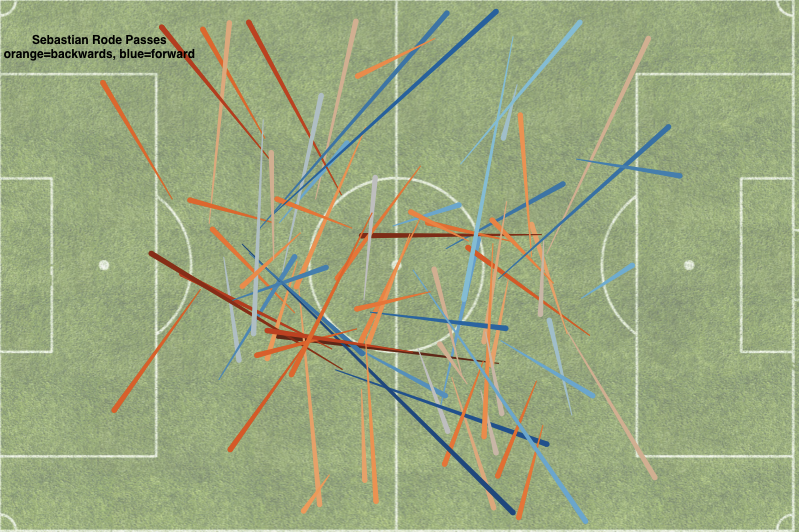
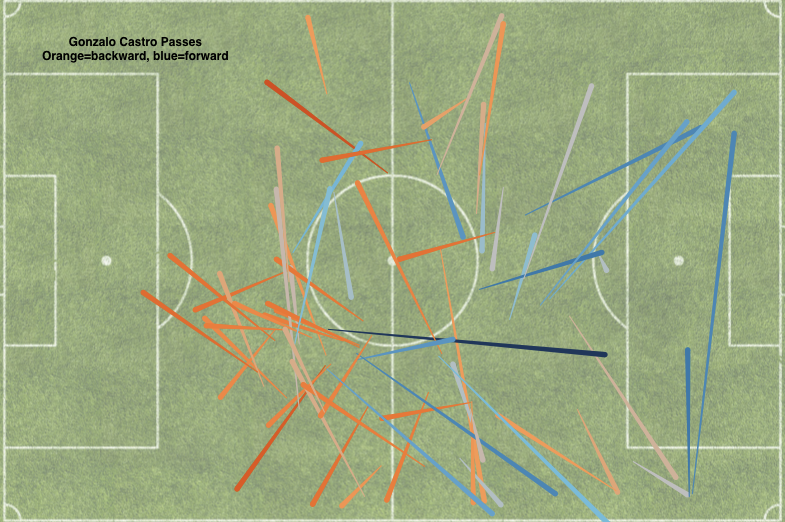
Things got better when Weigl came on but this is certainly a worry, especially when you know that advancing the ball was not something Rode did at Bayern. Schürrle and Dembélé stayed on their flanks while Kagawa was significantly advanced compared to last year (~9 yards closer to goal) so there's probably some blame to be given to the front 4 for not being fantastic options at all times but no matter how you apportion the blame, there are seeds of a problem here.
Ousmane Dembélé showed all kinds of 1-on-1 skills (and a willingness to seek out opportunities to use them) and an aggressive tendency to hoist the ball toward goal, somewhat reminiscent of Filip Kostic or Douglas Costa type player. Andre Schürrle surprisingly played the role of the eyes down distributor, with 6! key passes and a conservative passing style to go with his 7 shots. He had just 26 KP's in his entire time at Wolfsburg, averaging under 1 per game. 3 of his key passes went to Aubameyang, the highest # of key passes for any connection in the league. I thought we'd take a look at them to see if we can learn anything further in a new segment where we try to blend a bit of stats and video.
As you'd expect, hard to learn too much from just 4 passes but I will say it's maybe too soon to crown him Mkhitaryan. An excellent header mixed with 2 quality crosses toward a crowded box make for a great day but we'll need more to believe his transition from shot-happy striker to creator is full.
Bayern's More Relaxed Way To Thrash Bremen
Bayern steamrolled Bremen 6-0 and things were just carrying on exactly as before without Pep, right? Well, not really. The fact that Bremen managed a 76% completion rate (72% in first half) indicates a major shift in how Bayern will play. Bremen had a higher completion rate than 10 other teams on the opening weekend and had a huge increase from last years 63% (52% in first half) at the Allianz. Bayern allowed Dortmund to complete 87% of their passes in the Super Cup this year after 69% in the Cup final last year. Carlo seems to be drastically shifting the team away from Pep’s pressure to a team that could conceivably be below average in the Bundesliga at contesting passes. Doesn’t mean they will be knocked off the top or anything but is fascinating to see such a stark change.
For Bremen, yes they were without Pizarro, Junuzovic, Kruse, and Bargfrede, but it was a pathetic effort and I mean effort as in trying hard. Clemens Fritz basically admitted the team was terrified. Playing Sambou Yatabaré as an advanced right-sided midfielder might be the worst personnel move consistently made by any manager in the league. He offers nothing defensively, is a horrific passer and his output is very low (1 shot and 1 KP per 90 at Bremen and .08 G and .12 A/90 over 7000 minutes in his career). The “pressure” on the Ribéry for the 2nd goal sums up a lot of what went wrong not just with Yatabare, but the entire team.
Most Entertaining Game
Great signs from the fans, open space, and a furious tempo made Hoffenheim-RB Leipzig the most entertaining game of the week, just over Gladbach-Leverkusen.
RB Leipzig attacked at an absolutely lightning pace. They took 23 shots while completing 235 passes, a ratio of 10 per shot that would have comfortably led Europe last season. Leipzig had 38% of their completions in the attacking third (nearly twice the league average of 20%) and ~9% in the final 25 yards (comfortably over twice the average). Dominik Kaiser, a midfielder, scored a great goal and took 6 shots.
This is horrible news for Hoffenheim, who last year were horrendous at slowing down opponents and constantly got overrun. The heralded youngster Julian Nagelsmann improved the team overall but they still gave up 7 SOT per game during his time. This year started out with all of the offseason’s worries immediately turned up to the max and they look to be a team that will have some huge goals against numbers barring a quick correction.
The Loss Of Something Unique?
Darmstadt were disappointingly reasonable with their ball as they got routed by Köln. Last year they lapped the league twice with 68% of their midfield passes being played forward. This year just 53% did, behind a handful of teams. Their old manager Dirk Schuster didn’t take his forward bombing style to Augsburg either, at least not on opening day. Against Wolfsburg, Augsburg were the same patient, probing team as they always were under Marcus Weinzierl. They played 53 passes into the danger zone, only Bayern and Dortmund played more, while Wolfsburg played just 23 only Gladbach and Bremen played fewer. But…Augsburg completed just 11 of those 53 while Wolfsburg were 13/23 the respective worst and best rates in the league. Wolfsburg’s attacking efficiency was atrocious last year so any signs no matter how small have to cheer even Dieter Hecking.
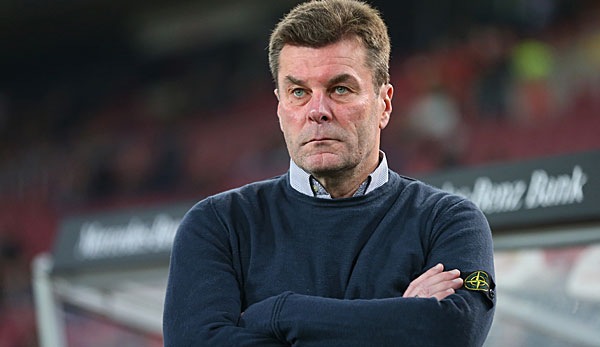
Ok, maybe not.
Hamburg didn’t start Alen Halilovic, though viewers were treated to a long tracking shot of him on the bench before kickoff and then a 7-minute look at his halftime warmup. They might want to because their attack needs a right side (though I’d love to see him in the center). Nicolai Müller started on the right and completed a whopping 7! passes in 66 minutes as Hamburg completed 60 passes on the left (Kostic’s side) and 18 on the right. The attack struggled badly with American Bobby Wood getting their only shot on target and goal on a pass that came from the goalkeeper.
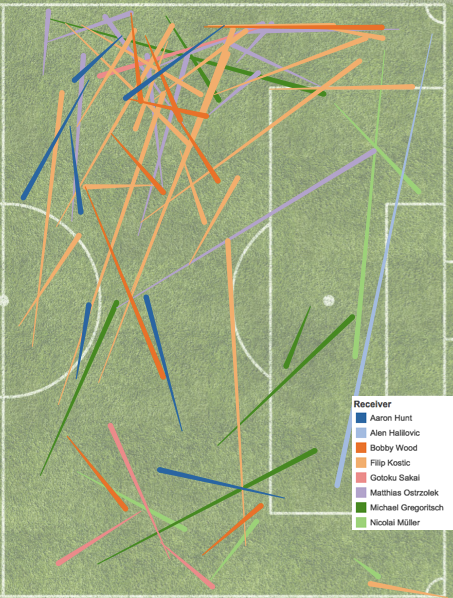
Gladbach Making It Count
Only Werder Bremen completed fewer passes in the danger zone than Gladbach's 5 but no one who watched the game would conclude they were lucky to score 2 goals. They took 12 of their 14 shots in the box because the space they found behind Leverkusen's press was gaping time after time. Strobl has started all 3 games over Dahoud and that means that where most teams have 2 players who start their passes 65+ yards from goal, Gladbach have 5 with Kramer/Strobl hanging very deep in front of a 3-man backline. It worked very well against Leverkusen, but it will be interesting to see how it looks against Freiburg who will have plenty of defenders back. The Stindl-Raffael axis is fantastic, no one loves Raffael more than me, but if you have Andre Hahn starting doing his only goals thing with 5 hanging deep there will be games that it's really tough to supply those two in good position.
It was heartbreaking to see Aránguiz limp off as I thought he had torn his knee up again. It's hard to come back from a devastating injury like he had last year, it takes a ton of work to do and mentally facing a serious re-injury so quickly after that can make your whole life look grey. Glad to hear reports it's not so bad. His performance on the pitch didn't scream out impact player however. He didn't get the ball to Calhanoglu, Bellarabi, or Volland (5 completions combined with only 3 in any sort of advanced territory) and his overall passing map looked a bit Rode-ish in how he passed backwards a lot.
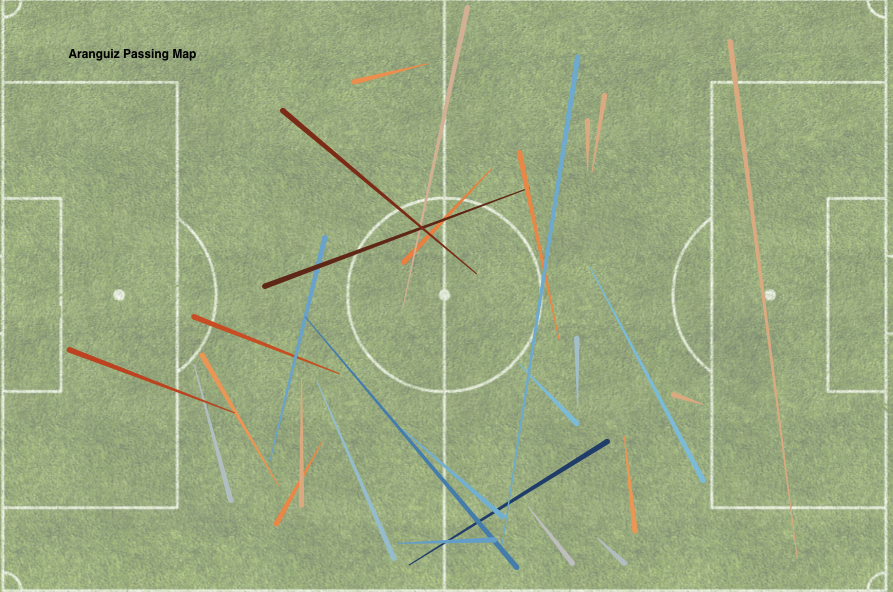
That's very un-Leverkusen. A big reason I thought they had a real chance to push Dortmund or Bayern for at least a while was a very dynamic midfield with Kampl and Aránguiz involved. Kampl was electric, completing 20 passes to forward players in very good position, but Aránguiz has not shown that dynamism yet. But then again, it's 78 measly minutes and a handful of preseason games, plenty of time to get things fixed starting with his knee.
Way Out Wide With Wolfsburg
 Heading into December 2015, everything seemed to be cruising along fine for Wolfsburg. Their point total was lagging from their excellent 2nd-place season the year before, but that was fine because they had greatly over-performed their underlying performance to reach those heights. The loss of Kevin de Bruyne didn't seem to have harmed their performances. Then it all fell apart. They won 1 out of 10 matches, broke that slump with back-to-back wins, and then cratered with another 7-match winless streak. They played like a mid-table team down the stretch and had no claim to deserve a top 4 spot. That sets up this year as a huge season in the Wolfsburg story. Another finish outside the top 4, a Draxler exit, a Volkswagen pullback and it could be a serious dry spell.
Heading into December 2015, everything seemed to be cruising along fine for Wolfsburg. Their point total was lagging from their excellent 2nd-place season the year before, but that was fine because they had greatly over-performed their underlying performance to reach those heights. The loss of Kevin de Bruyne didn't seem to have harmed their performances. Then it all fell apart. They won 1 out of 10 matches, broke that slump with back-to-back wins, and then cratered with another 7-match winless streak. They played like a mid-table team down the stretch and had no claim to deserve a top 4 spot. That sets up this year as a huge season in the Wolfsburg story. Another finish outside the top 4, a Draxler exit, a Volkswagen pullback and it could be a serious dry spell. 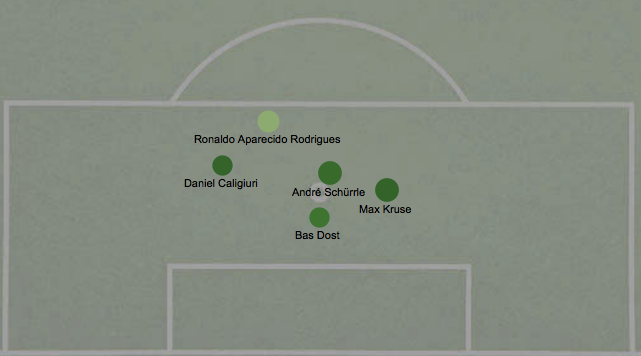 In: Yannick Gerhardt 13m (Köln), Jeffrey Bruma 11.5m (PSV), Josip Brekalo 6m (Dinamo Zagreb), Jakub Blaszczykowski 5m (Dortmund), Victor Osimhen 3.5m (Ultimate Strikers-Nigeria), Daniel Didavi free (Stuttgart) Out: André Schürrle, Max Kruse, Naldo Key Passing Combinations Naldo-Guilavogui Träsch-Vierinha Draxler-Kruse Rodriguez-Draxler Arnold-Schürrle
In: Yannick Gerhardt 13m (Köln), Jeffrey Bruma 11.5m (PSV), Josip Brekalo 6m (Dinamo Zagreb), Jakub Blaszczykowski 5m (Dortmund), Victor Osimhen 3.5m (Ultimate Strikers-Nigeria), Daniel Didavi free (Stuttgart) Out: André Schürrle, Max Kruse, Naldo Key Passing Combinations Naldo-Guilavogui Träsch-Vierinha Draxler-Kruse Rodriguez-Draxler Arnold-Schürrle 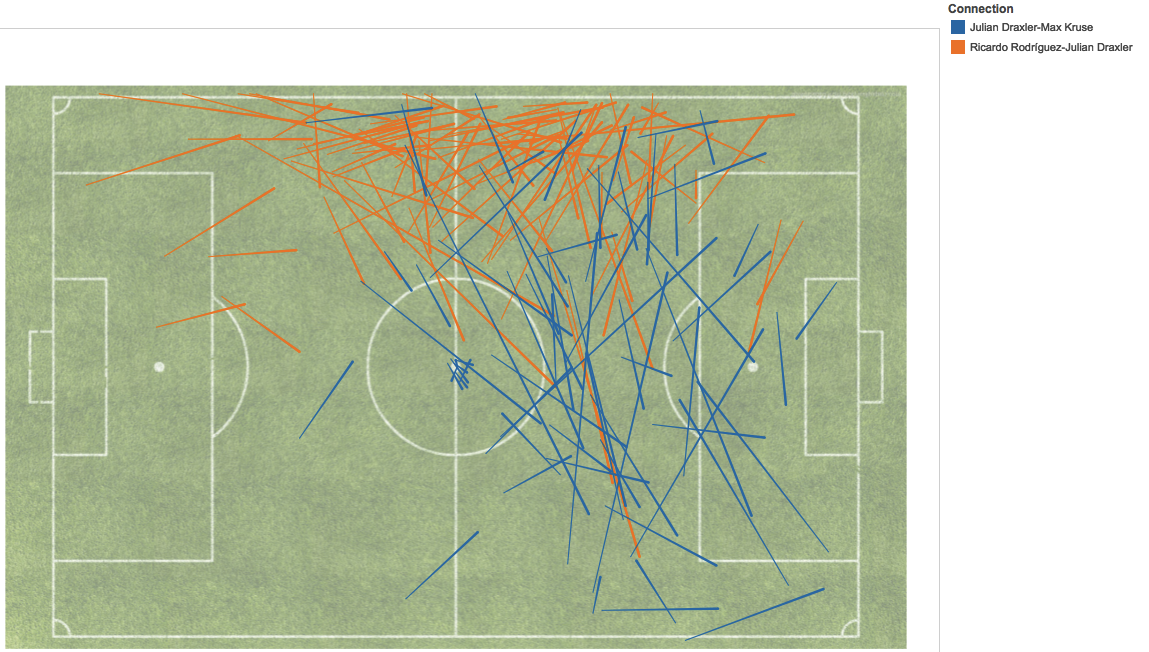 One Big Strength: Avoiding tap-ins allowed. No team allowed a lower share of shots inside 10 yards than Wolfsburg at 13%. They did this somehow without having an above average shot distance allowed, which is kind of bizarre when you think about it. Compare their shot chart allowed to Ingolstadt's, who allowed similar shot total with similar shot distance allowed, and focus on the six yard box.
One Big Strength: Avoiding tap-ins allowed. No team allowed a lower share of shots inside 10 yards than Wolfsburg at 13%. They did this somehow without having an above average shot distance allowed, which is kind of bizarre when you think about it. Compare their shot chart allowed to Ingolstadt's, who allowed similar shot total with similar shot distance allowed, and focus on the six yard box. 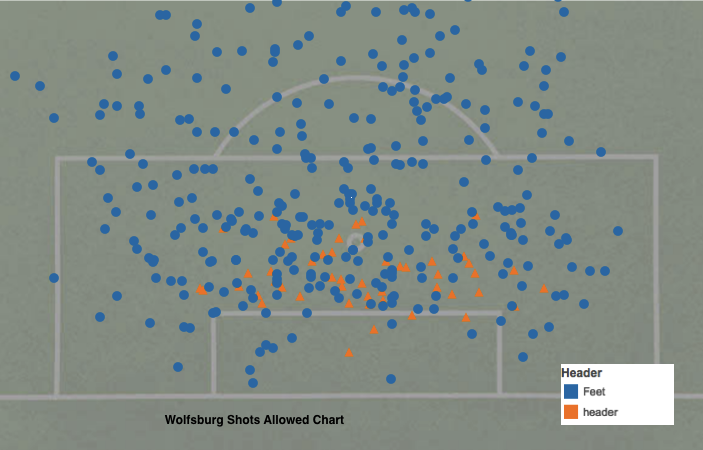
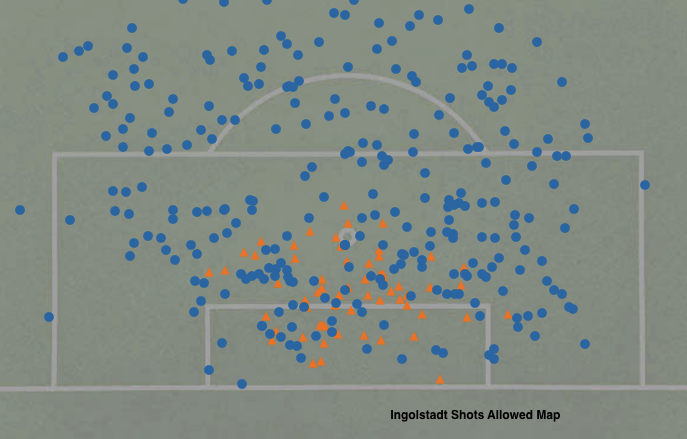 Ingolstadt allowed 21 shots from the foot and 19 headers in the box while Wolfsburg were at 10 via foot and 4 on the head. All this despite an average shot distance of 18.5 vs Ingolstadt's 18.2. So I admit I cheated a bit. Maybe this is a strength or maybe it's be a warning sign that next year a chunk of those 15 yard shots edge 6 yards closer. One Big Weakness: Wolfsburg are like your friend with the good job, great girlfriend, new car, and a pack-a-day smoking problem. Most of their life looks good on the surface, but there is one glaring problem that is flashing DANGER. For Wolfsburg it's not the tempting coolness of a camel with sunglasses but the ease of playing a ball out wide and having someone whip in a long cross.
Ingolstadt allowed 21 shots from the foot and 19 headers in the box while Wolfsburg were at 10 via foot and 4 on the head. All this despite an average shot distance of 18.5 vs Ingolstadt's 18.2. So I admit I cheated a bit. Maybe this is a strength or maybe it's be a warning sign that next year a chunk of those 15 yard shots edge 6 yards closer. One Big Weakness: Wolfsburg are like your friend with the good job, great girlfriend, new car, and a pack-a-day smoking problem. Most of their life looks good on the surface, but there is one glaring problem that is flashing DANGER. For Wolfsburg it's not the tempting coolness of a camel with sunglasses but the ease of playing a ball out wide and having someone whip in a long cross. 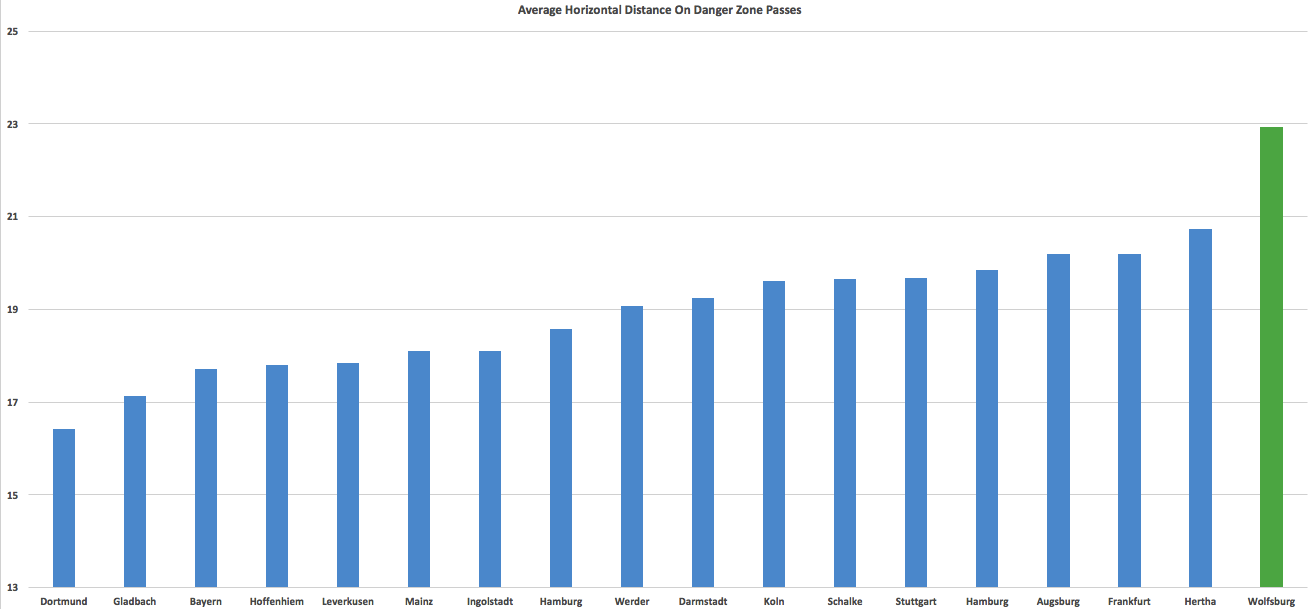
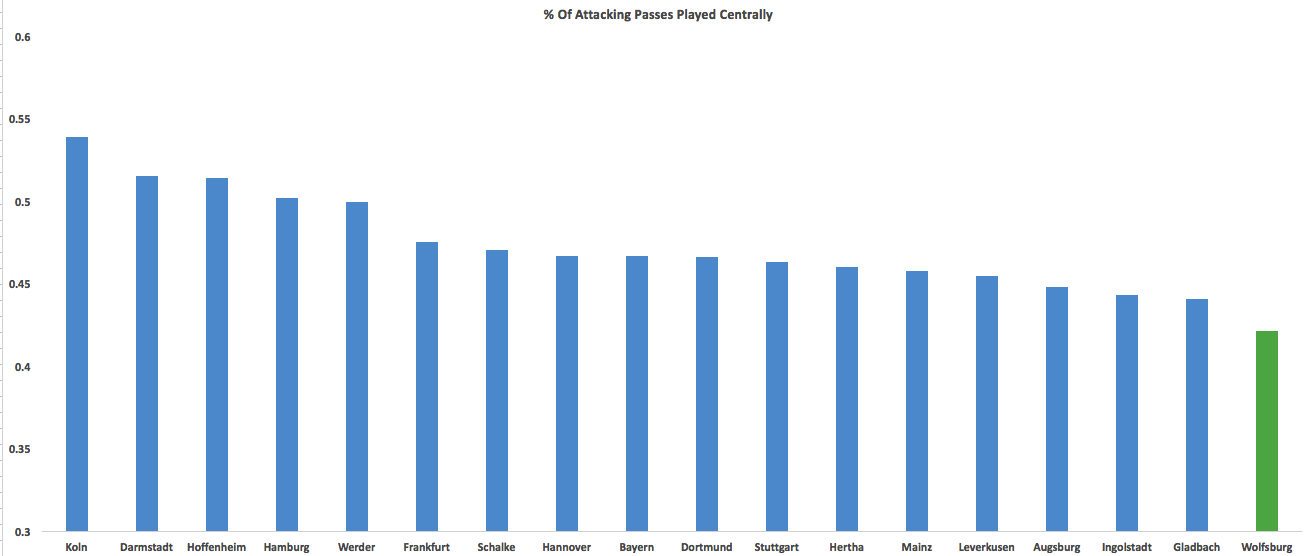 They have super-attacking fullbacks in Ricardo Rodriguez and especially Christian Träsch but as you can see from the first graph, great scoring teams generally do not just throw it out to the sidelines and say try to pick out our guys head in the center. Wolfsburg (in a sampling of shots) had 2.8 men in the box for their shots, while the 4 UCL teams all had 3+ on average with Leverkusen and Bayern at 3.5. Only Werder Bremen and Hannover had a lower ratio of attacking players to defenders in the box. All this to say, Wolfsburg have a glaring flaw that spraying a bit of air freshener isn't going to conceal. This became more and more frustrating to watch with superstar Julian Draxler alongside Max Kruse, who was key in Gladbach's short-passing approach in previous years. Kruse ate his way out of Wolfsburg and Draxler is clamoring for a move (though Wolfsburg have said he will play with them this year). They had the talent to quit cold turkey but just couldn't do it. The bad habits start back in the midfield where Gustavo and Guilavogui were right at the top when it comes to share of passes played to the flanks.
They have super-attacking fullbacks in Ricardo Rodriguez and especially Christian Träsch but as you can see from the first graph, great scoring teams generally do not just throw it out to the sidelines and say try to pick out our guys head in the center. Wolfsburg (in a sampling of shots) had 2.8 men in the box for their shots, while the 4 UCL teams all had 3+ on average with Leverkusen and Bayern at 3.5. Only Werder Bremen and Hannover had a lower ratio of attacking players to defenders in the box. All this to say, Wolfsburg have a glaring flaw that spraying a bit of air freshener isn't going to conceal. This became more and more frustrating to watch with superstar Julian Draxler alongside Max Kruse, who was key in Gladbach's short-passing approach in previous years. Kruse ate his way out of Wolfsburg and Draxler is clamoring for a move (though Wolfsburg have said he will play with them this year). They had the talent to quit cold turkey but just couldn't do it. The bad habits start back in the midfield where Gustavo and Guilavogui were right at the top when it comes to share of passes played to the flanks. 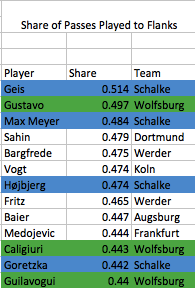 Somehow these guys played nearly 1200 minutes together, when they are suited to only play in the final minutes when you are trying to see out a win. They simply don't handle the ball that often when you look at teams with similar possession. Alonso and Vidal made 198 passes per game, Gündogan and Weigl made 185, Dahoud and Xhaka made 144, but Guilavogui and Gustavo made just 110 per game. 4 center backs or fullbacks (Dante, Naldo, Träsch, RicRod) made more than any midfielders. Wolfsburg midfielders not only rarely touch the ball and mainly play it wide, but when they are handling the ball there is no forward thrust. Guilavogui's passes ended on average 57.5 yards from goal and Gustavo's 59.9. Gustavo was last in this category among midfielders and Hertha's Per Skjelbred was the only player behind Guilavogui. To have 2 of the "top" 3 midfielders that leave you with the most work to do after the ball leaves their hands means your attacks are off to a terrible start. Maximilian Arnold was an improvement when he got into the lineup and Wolfsburg need more of Arnold and new signing Yannick Gerhardt, who both can push the ball forward centrally at least a little more, and should never play Guilavogui and Gustavo together again. Gerhardt had 62% of his receptions come in the opposition half, compared to Gustavo and Guilavogui's 42 and 45% but he's not a Kampl-esque driver forward. Koln were a rather conservative team last season and he wasn't an exception to the rule. He's not such a transcendent talent or so different from Wolfsburg that he's not at risk of being Dietered and start playing passes out to the wings. And, finally, in what might be the best addition of the year. https://www.youtube.com/watch?v=qHf53kLqoLs Gomez put up huge numbers at Besiktas after a lull at Fiorentina and was still good enough to lead the German attack in the Euros. 25% of his shots the past 4 years have come from headers, a more normal number after Dost has basically been at 50/50. Good Season: Didavi plays off Draxler well and a little less selfishly than he did last season. Gerhardt makes runs into the box. Using the fullbacks becomes a dangerous plan B instead of plan A and B. Gomez gets a variety of service and Wolfsburg makes the Champions League. Bad Season: All the nice new toys get Dieterized and Rodriguez and Träsch continue to carry the ball into the final third and Gomez is used basically like Bas Dost. Didavi keeps taking long shots and Draxler's mind wanders toward greener pastures and they hover well off Schalke and Gladbach's pace.
Somehow these guys played nearly 1200 minutes together, when they are suited to only play in the final minutes when you are trying to see out a win. They simply don't handle the ball that often when you look at teams with similar possession. Alonso and Vidal made 198 passes per game, Gündogan and Weigl made 185, Dahoud and Xhaka made 144, but Guilavogui and Gustavo made just 110 per game. 4 center backs or fullbacks (Dante, Naldo, Träsch, RicRod) made more than any midfielders. Wolfsburg midfielders not only rarely touch the ball and mainly play it wide, but when they are handling the ball there is no forward thrust. Guilavogui's passes ended on average 57.5 yards from goal and Gustavo's 59.9. Gustavo was last in this category among midfielders and Hertha's Per Skjelbred was the only player behind Guilavogui. To have 2 of the "top" 3 midfielders that leave you with the most work to do after the ball leaves their hands means your attacks are off to a terrible start. Maximilian Arnold was an improvement when he got into the lineup and Wolfsburg need more of Arnold and new signing Yannick Gerhardt, who both can push the ball forward centrally at least a little more, and should never play Guilavogui and Gustavo together again. Gerhardt had 62% of his receptions come in the opposition half, compared to Gustavo and Guilavogui's 42 and 45% but he's not a Kampl-esque driver forward. Koln were a rather conservative team last season and he wasn't an exception to the rule. He's not such a transcendent talent or so different from Wolfsburg that he's not at risk of being Dietered and start playing passes out to the wings. And, finally, in what might be the best addition of the year. https://www.youtube.com/watch?v=qHf53kLqoLs Gomez put up huge numbers at Besiktas after a lull at Fiorentina and was still good enough to lead the German attack in the Euros. 25% of his shots the past 4 years have come from headers, a more normal number after Dost has basically been at 50/50. Good Season: Didavi plays off Draxler well and a little less selfishly than he did last season. Gerhardt makes runs into the box. Using the fullbacks becomes a dangerous plan B instead of plan A and B. Gomez gets a variety of service and Wolfsburg makes the Champions League. Bad Season: All the nice new toys get Dieterized and Rodriguez and Träsch continue to carry the ball into the final third and Gomez is used basically like Bas Dost. Didavi keeps taking long shots and Draxler's mind wanders toward greener pastures and they hover well off Schalke and Gladbach's pace.
Risers and Fallers? Augsburg, Köln, Frankfurt and the New Boys
The New Guys Freiburg won the 2. Bundesliga with 75 goals last season while RB Leipzig averaged just 46 goals in their 2-season stay. Looking a bit deeper, we see the gap was not as large as Freiburg's extra 14 GD showed. Leipzig had a better SOTR with 5.7 for to 3.1 against with Freiburg at 6.0 for and 3.8 against. Of course Leipzig have shelled out on some very eye-catching transfers so have earned the higher expectations but Freiburg come up as the champs. Freiburg  Two names to watch that had enormous numbers last season. The first is Vincenzo Grifo, the 23-year old who had .5 goals and .4 assists per 90. In his only previous Bundesliga action back in 2013 for Hoffenheim as a 20-year old he had 6 shots and 8 key passes in 3 90s played while going 101/124 passing. The second is Nils Peterson who has consistently put up around .5 goals per 90 throughout his career at Werder Bremen and now Freiburg. Their 75 goals last season, those two players track record, and their teams solid attacking numbers 2 years ago in the Bundesliga make me think they will score plenty. No team had a higher SOT% in 2014-15 than Freiburg (something that has some repeatability)
Two names to watch that had enormous numbers last season. The first is Vincenzo Grifo, the 23-year old who had .5 goals and .4 assists per 90. In his only previous Bundesliga action back in 2013 for Hoffenheim as a 20-year old he had 6 shots and 8 key passes in 3 90s played while going 101/124 passing. The second is Nils Peterson who has consistently put up around .5 goals per 90 throughout his career at Werder Bremen and now Freiburg. Their 75 goals last season, those two players track record, and their teams solid attacking numbers 2 years ago in the Bundesliga make me think they will score plenty. No team had a higher SOT% in 2014-15 than Freiburg (something that has some repeatability) 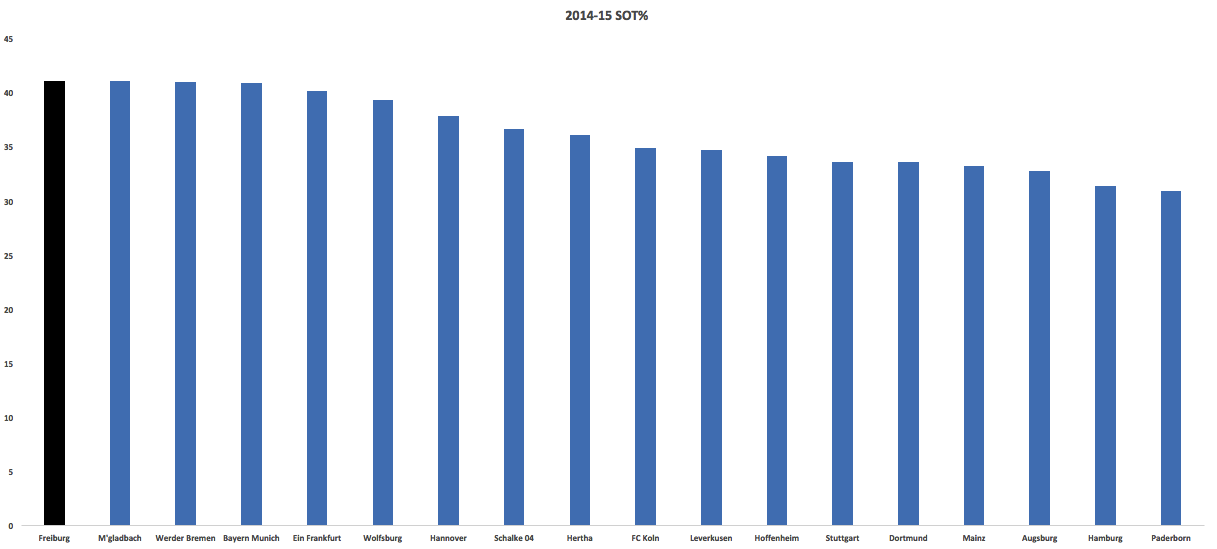 and they had the 7th most deep completions in the league, suggesting an engine capable of creating chances even if they didn't pile up the shots at a commensurate rate. The problem was the defense, which allowed 200 shots on target, more than anyone else in the league. They actually bowed up respectably around goal, but couldn't stop opponents from coming down the center and reaching the box. I have no idea if they have fixed that but it is #1 on early-season checklist for Freiburg, if they can play well defensively in midfield I like them to surprise by earning safety somewhat easily. RB Leipzig
and they had the 7th most deep completions in the league, suggesting an engine capable of creating chances even if they didn't pile up the shots at a commensurate rate. The problem was the defense, which allowed 200 shots on target, more than anyone else in the league. They actually bowed up respectably around goal, but couldn't stop opponents from coming down the center and reaching the box. I have no idea if they have fixed that but it is #1 on early-season checklist for Freiburg, if they can play well defensively in midfield I like them to surprise by earning safety somewhat easily. RB Leipzig 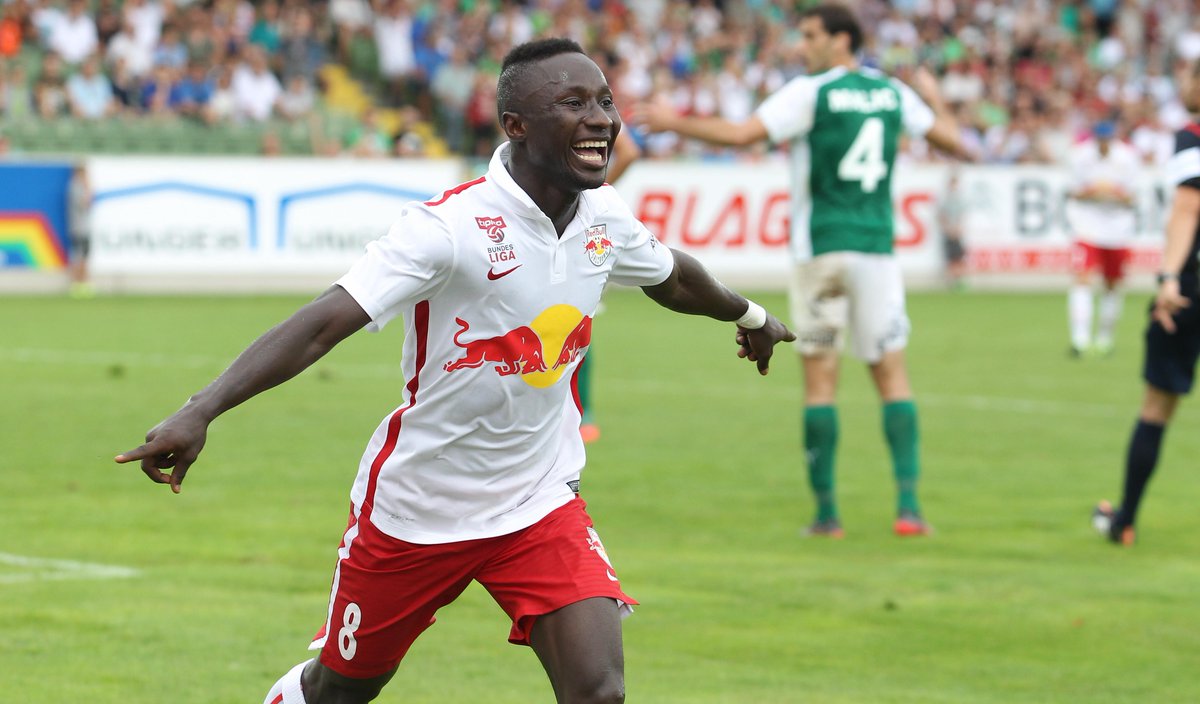 The reason they are comfortably mid-table and a Europa challenger in the odds are the 3 big additions. The biggest player addition is Naby Keita for 15m from RB Salzburg. He's been written about here in very, very glowing terms and now it turns out he probably turned down Arsenal to come to Leipzig. The other player addition was Timo Werner for 10m. Werner was a shot-quality king last year for Stuttgart and is just 20 years old. He took 2.6 shots per 90 at an average of 13.2 yards, good for 6th in the league, while only taking 28% headers.
The reason they are comfortably mid-table and a Europa challenger in the odds are the 3 big additions. The biggest player addition is Naby Keita for 15m from RB Salzburg. He's been written about here in very, very glowing terms and now it turns out he probably turned down Arsenal to come to Leipzig. The other player addition was Timo Werner for 10m. Werner was a shot-quality king last year for Stuttgart and is just 20 years old. He took 2.6 shots per 90 at an average of 13.2 yards, good for 6th in the league, while only taking 28% headers.  He's struggled to finish the consistent good shots he's generated but you'd rather have that than a 20-year old striker who converted a few long shots and is hoping to add gets good shots to his resume. The third addition is Ralph Hasenhüttl, who was my Coach of the Year last season at Ingolstadt. He fits in nicely with the Rangnick philosophy and should ensure Leipzig won't go down because of too many goals conceded. Hasenhüttl's defense was enough to have Ingolstadt hang around the Europa League spots for a while last year, that alongside some dazzling talent means it would be disappointing for Leipzig to not at least do the same this year. Köln
He's struggled to finish the consistent good shots he's generated but you'd rather have that than a 20-year old striker who converted a few long shots and is hoping to add gets good shots to his resume. The third addition is Ralph Hasenhüttl, who was my Coach of the Year last season at Ingolstadt. He fits in nicely with the Rangnick philosophy and should ensure Leipzig won't go down because of too many goals conceded. Hasenhüttl's defense was enough to have Ingolstadt hang around the Europa League spots for a while last year, that alongside some dazzling talent means it would be disappointing for Leipzig to not at least do the same this year. Köln  In: Sehrou Guirassy 3.8m (Lille), Marco Höger 1.3m (Schalke), Konstantin Rausch Free (Darmstadt), Artjoms Rudnevs Free (Hamburg) Out: Yannick Gerhardt, Kevin Vogt A little bit of Italy mixed into the Bundesliga. The lowest-pressing team in the league sits off opponents, invites them on and blocked more a lot more shots than any other team bar Augsburg. They have finished 12th and 9th in the table the last two seasons despite real bad (17th and 14th) territory numbers. The shot numbers are more positive as they climbed to about even in shots on target. The last 14 games Köln went on a tear, with a +15 SOT difference that would have been good enough for 5th in the league if they ran that over 34 games. One Big Imbalance Have we been praising the wrong fullback? Jonas Hector played for Germany in the Euros but his left side gets targeted to an extent no other side of the pitch in the Bundesliga gets targeted.
In: Sehrou Guirassy 3.8m (Lille), Marco Höger 1.3m (Schalke), Konstantin Rausch Free (Darmstadt), Artjoms Rudnevs Free (Hamburg) Out: Yannick Gerhardt, Kevin Vogt A little bit of Italy mixed into the Bundesliga. The lowest-pressing team in the league sits off opponents, invites them on and blocked more a lot more shots than any other team bar Augsburg. They have finished 12th and 9th in the table the last two seasons despite real bad (17th and 14th) territory numbers. The shot numbers are more positive as they climbed to about even in shots on target. The last 14 games Köln went on a tear, with a +15 SOT difference that would have been good enough for 5th in the league if they ran that over 34 games. One Big Imbalance Have we been praising the wrong fullback? Jonas Hector played for Germany in the Euros but his left side gets targeted to an extent no other side of the pitch in the Bundesliga gets targeted. 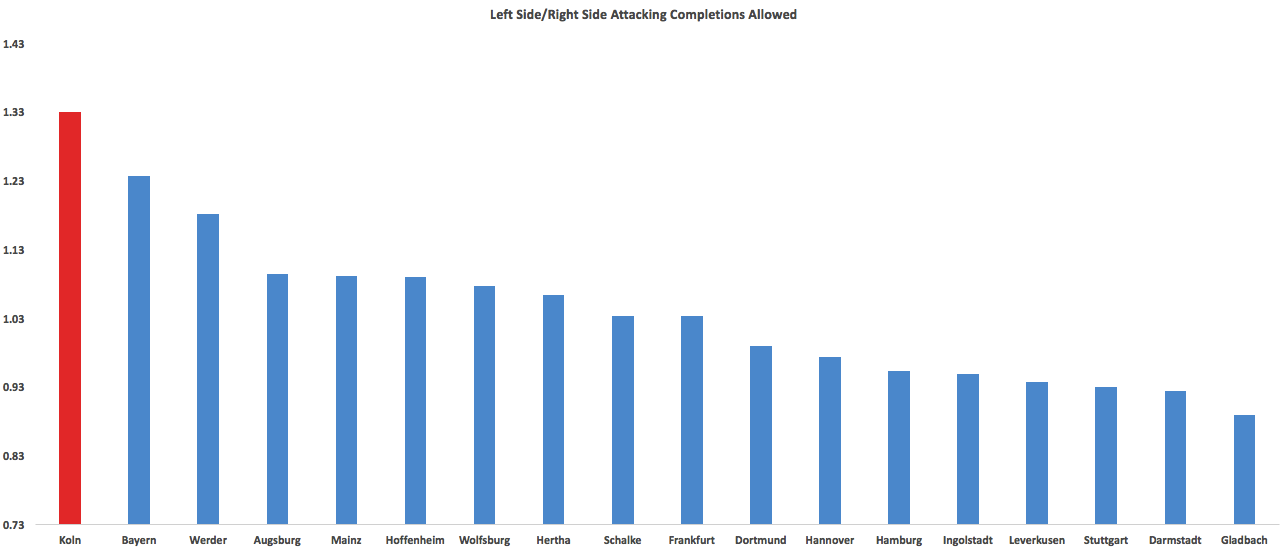 Nearly 600 more attacking completions came down Hector's side than the right side, manned by Olkowski or Sorenson most commonly. An average game sees 17 more completions on Hector's side in the Köln half and 12 in the Köln final 3rd where the trend goes even more extreme up to 1.5x the right. And it's not just volume. No other team has a larger gap in completion % between their left and right sides than Köln (74% on their left and 68% down the right). My next thought was maybe the build-up in the opposition half happens on Hector's side, so we can't blame him for the onslaught that starts higher up the pitch. I checked that, and sadly, no, that does not get our man Jonas off the hook. It's basically even as far as build-up is concerned and the opposite side even sees a bit more volume with a slightly higher completion %. I looked at it a couple other ways: completion % on passes that started and stayed wide, which presumably would isolate fullbacks defensive contributions a little more. Köln still had the highest disparity between left and right. I then looked at how often the opposition passed to the left compared to the right from the center. Bayern were far and away first interestingly, but Köln were right there in 3rd. They had a large gap in key pass origin as well, with more coming from their left side. The obvious explanation is Hector contributes a lot more on offense and that's true, he had 1.8 key passes per game while Olkowski was at 0.2. Hector's average pass attempt originated 5 yards closer to goal than Olkowski and he made 13 more passes per 90. Köln as a whole had 13% more attacking completions on the left than right but essentially no difference in completion % or key pass origin. So while Hector was fantastic with the ball and Olkowski was horrible, there probably was no team with a bigger mismatch in terms of offensive talent there, I'm not sure Hector deserves all the praise he was given (by me included). The massive disparity in how Köln get attacked cannot be what they want, every team knows it and every team exploits it. Hector needs more defensive support, it's too easy right now. Key Passing Connection Risse-Modeste. Risse played as a mix of right back, wingback and right wing, but his protection on the right when playing a more advanced role could be another reason teams relentlessly attacked the left side. With the ball Risse to Modeste is the play you should have in mind when you think of Köln. No connection created more shots: 24 and no other non-GK connection gained more yardage for their team toward goal.
Nearly 600 more attacking completions came down Hector's side than the right side, manned by Olkowski or Sorenson most commonly. An average game sees 17 more completions on Hector's side in the Köln half and 12 in the Köln final 3rd where the trend goes even more extreme up to 1.5x the right. And it's not just volume. No other team has a larger gap in completion % between their left and right sides than Köln (74% on their left and 68% down the right). My next thought was maybe the build-up in the opposition half happens on Hector's side, so we can't blame him for the onslaught that starts higher up the pitch. I checked that, and sadly, no, that does not get our man Jonas off the hook. It's basically even as far as build-up is concerned and the opposite side even sees a bit more volume with a slightly higher completion %. I looked at it a couple other ways: completion % on passes that started and stayed wide, which presumably would isolate fullbacks defensive contributions a little more. Köln still had the highest disparity between left and right. I then looked at how often the opposition passed to the left compared to the right from the center. Bayern were far and away first interestingly, but Köln were right there in 3rd. They had a large gap in key pass origin as well, with more coming from their left side. The obvious explanation is Hector contributes a lot more on offense and that's true, he had 1.8 key passes per game while Olkowski was at 0.2. Hector's average pass attempt originated 5 yards closer to goal than Olkowski and he made 13 more passes per 90. Köln as a whole had 13% more attacking completions on the left than right but essentially no difference in completion % or key pass origin. So while Hector was fantastic with the ball and Olkowski was horrible, there probably was no team with a bigger mismatch in terms of offensive talent there, I'm not sure Hector deserves all the praise he was given (by me included). The massive disparity in how Köln get attacked cannot be what they want, every team knows it and every team exploits it. Hector needs more defensive support, it's too easy right now. Key Passing Connection Risse-Modeste. Risse played as a mix of right back, wingback and right wing, but his protection on the right when playing a more advanced role could be another reason teams relentlessly attacked the left side. With the ball Risse to Modeste is the play you should have in mind when you think of Köln. No connection created more shots: 24 and no other non-GK connection gained more yardage for their team toward goal. 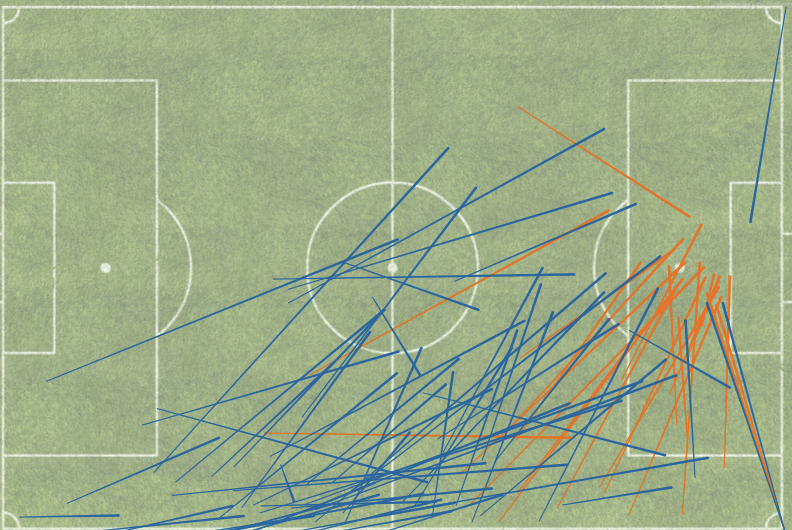 The average Risse-Modeste sweep moved Köln 26 yards closer toward goal. Those 24 key passes were a big step for Modeste, who was near the elite in Europe by taking over 3 shots per game inside the box. Good Season: Left side gets a little more support and the center backs who had to work so hard facing the 3rd most passes into the box get a breather. The best crossing team in the league keeps on clicking as Modeste keeps heading them in, comfortable mid-table finish. Bad Season: The territory deficit gets steeper with the midfield weakened after Vogt and Gerhardt's departure. Defenders don't cope as well and the goals match up with one of league's worst territory numbers and we see relegation. This feels more likely than the good season scenario. Augsburg
The average Risse-Modeste sweep moved Köln 26 yards closer toward goal. Those 24 key passes were a big step for Modeste, who was near the elite in Europe by taking over 3 shots per game inside the box. Good Season: Left side gets a little more support and the center backs who had to work so hard facing the 3rd most passes into the box get a breather. The best crossing team in the league keeps on clicking as Modeste keeps heading them in, comfortable mid-table finish. Bad Season: The territory deficit gets steeper with the midfield weakened after Vogt and Gerhardt's departure. Defenders don't cope as well and the goals match up with one of league's worst territory numbers and we see relegation. This feels more likely than the good season scenario. Augsburg 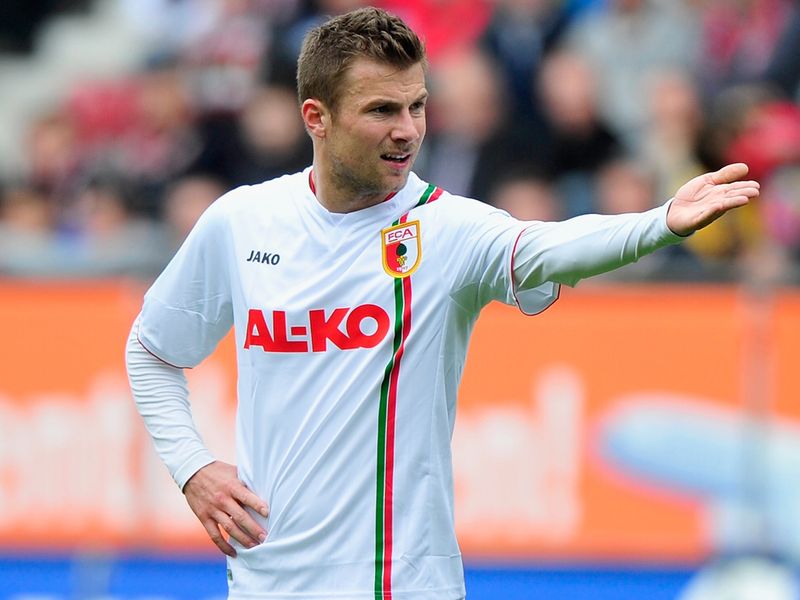 In: Takashi Umami 1.5m (Gamba Osaka), Marvin Friedrich 1m (Schalke), Gojko Kacar Free (Hamburg) Out: Jeong-Ho Hong to China for 6 mil! That Asian player bonus. Ragnar Klavan, Tobias Werner One Standout Offensive Number
In: Takashi Umami 1.5m (Gamba Osaka), Marvin Friedrich 1m (Schalke), Gojko Kacar Free (Hamburg) Out: Jeong-Ho Hong to China for 6 mil! That Asian player bonus. Ragnar Klavan, Tobias Werner One Standout Offensive Number 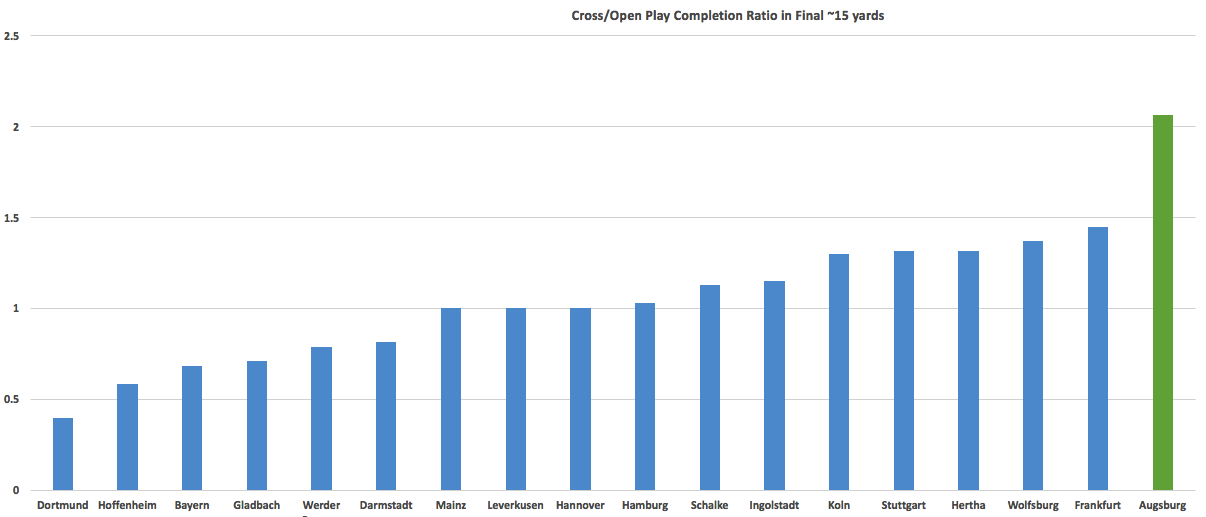 Marcus Weinzierl their old coach is off to Schalke but he leaves behind a team that struggled to get the ball extremely deep without a cross. Fullbacks wide was a distinctive tic of Weinzierl's reign. The crossing stat is really interesting because outside the last 15 yards, Augsburg were fine at creating shots from open play passes and relied on crosses less than average. They just couldn't find a way to actually attempt passes into the most dangerous area of the pitch:
Marcus Weinzierl their old coach is off to Schalke but he leaves behind a team that struggled to get the ball extremely deep without a cross. Fullbacks wide was a distinctive tic of Weinzierl's reign. The crossing stat is really interesting because outside the last 15 yards, Augsburg were fine at creating shots from open play passes and relied on crosses less than average. They just couldn't find a way to actually attempt passes into the most dangerous area of the pitch: 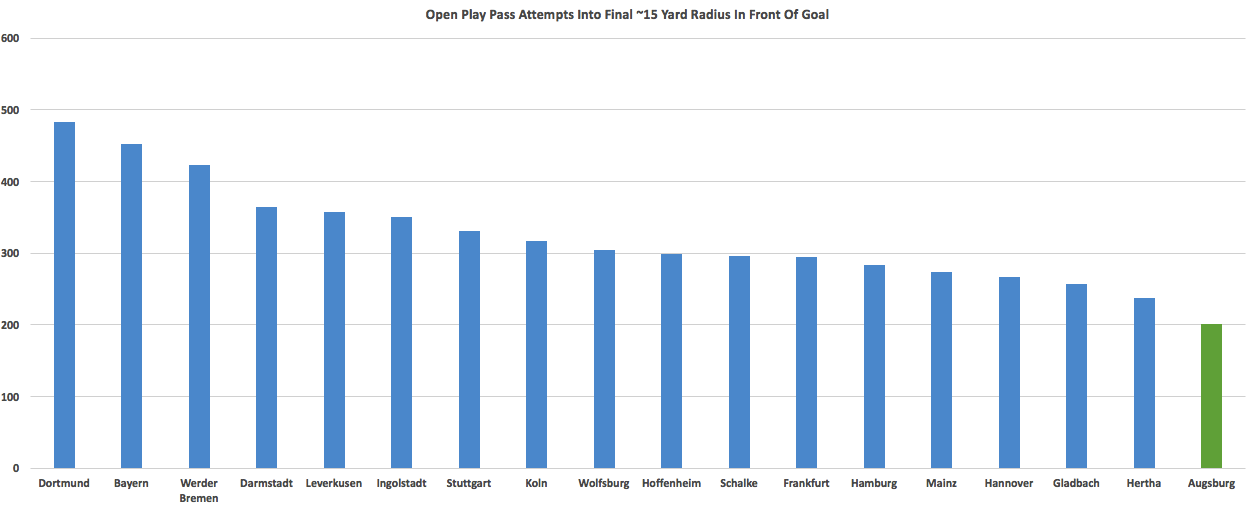 It's weird because for passes ending from 15-30 yards Augsburg attempted more than Schalke/Wolfsburg and 10 other teams. It will be up to new coach Dirk Schuster, in from Darmstadt, to fix this. I suspect his first order of business will be working set pieces because 1: Darmstadt were amazing at them (47% of shots from set pieces and led league with 16 goals) and 2: his opening statement said he wanted to toughen up Augsburg which somehow is conflated with set pieces in my mind. Roberto Martinez I think we can all agree is the ultimate soft manager and his teams simply don't practice set pieces. Augsburg have 4 players who stand out as quality with the ball in Paul Verhaegh at fullback, Daniel Baier in midfield, and Ja-Cheol Koo and Raul Bobadilla as attackers. Last year they were all heavily involved in their attacking play and more of the same is the recipe this year as the fall-off is one of the steepest in the league. Koo had the shortest key passes in the league, in general that's a great thing but when we see how Augsburg never try the most dangerous passes maybe there is also a case that he's too conservative?
It's weird because for passes ending from 15-30 yards Augsburg attempted more than Schalke/Wolfsburg and 10 other teams. It will be up to new coach Dirk Schuster, in from Darmstadt, to fix this. I suspect his first order of business will be working set pieces because 1: Darmstadt were amazing at them (47% of shots from set pieces and led league with 16 goals) and 2: his opening statement said he wanted to toughen up Augsburg which somehow is conflated with set pieces in my mind. Roberto Martinez I think we can all agree is the ultimate soft manager and his teams simply don't practice set pieces. Augsburg have 4 players who stand out as quality with the ball in Paul Verhaegh at fullback, Daniel Baier in midfield, and Ja-Cheol Koo and Raul Bobadilla as attackers. Last year they were all heavily involved in their attacking play and more of the same is the recipe this year as the fall-off is one of the steepest in the league. Koo had the shortest key passes in the league, in general that's a great thing but when we see how Augsburg never try the most dangerous passes maybe there is also a case that he's too conservative? 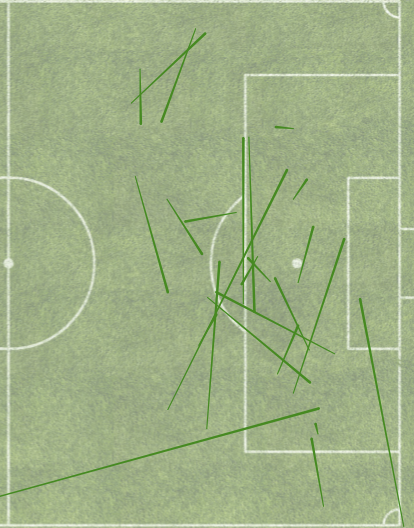
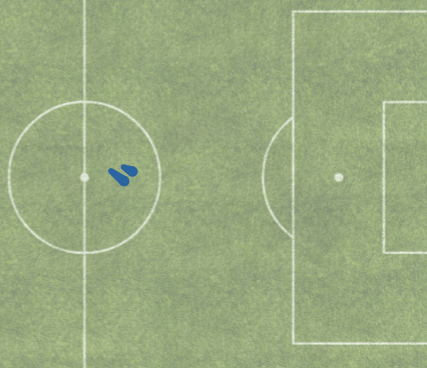 No matter which one you chose, the only loser here is Frankfurt. Alex Meier is the one on the left side but when your leading goal scorer and striker is playing his passes from where midfielders on other teams do, you are in serious trouble. Only Seferovic and Castaignos were further forward than Meier. Frankfurt were basically a par team in territory and shots 2 seasons ago but both trended badly last year and picked up speed in the wrong direction as the year ended. Season-long Frankfurt were 15th in SOT rate and over the final 15 games they were dead last. Decent territory numbers and fantastic shot locations helped them avoid relegation but there were serious warning signs. One Big Strength
No matter which one you chose, the only loser here is Frankfurt. Alex Meier is the one on the left side but when your leading goal scorer and striker is playing his passes from where midfielders on other teams do, you are in serious trouble. Only Seferovic and Castaignos were further forward than Meier. Frankfurt were basically a par team in territory and shots 2 seasons ago but both trended badly last year and picked up speed in the wrong direction as the year ended. Season-long Frankfurt were 15th in SOT rate and over the final 15 games they were dead last. Decent territory numbers and fantastic shot locations helped them avoid relegation but there were serious warning signs. One Big Strength 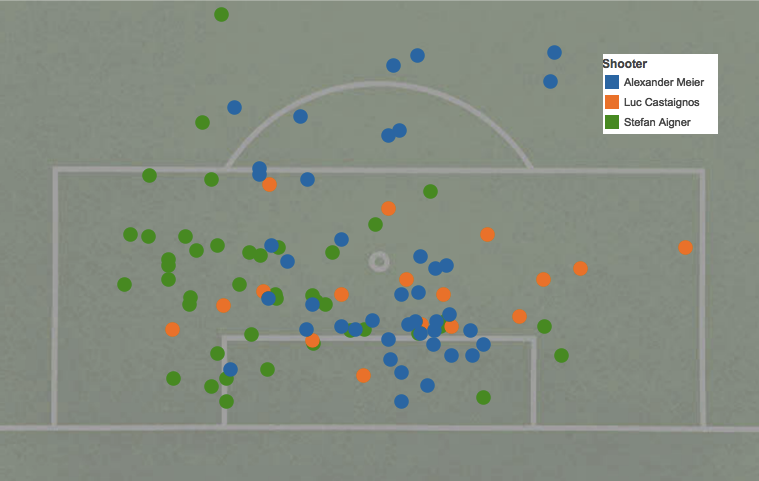 3rd closest average shot distance in the league. One Big Weakness The opposite, 4th best average shot distance allowed. Stefan Reinartz retired and created a passing stat that I suspect would have rated him by far the best player on Frankfurt last season. If you've made it this far looking for more in-depth Frankfurt content I apologize. I tried, I really did, but Frankfurt are incredibly boring. Just a bad team in many, many ways but not horrible at anything. Alex Meier heads in a lot of goals. There you go.
3rd closest average shot distance in the league. One Big Weakness The opposite, 4th best average shot distance allowed. Stefan Reinartz retired and created a passing stat that I suspect would have rated him by far the best player on Frankfurt last season. If you've made it this far looking for more in-depth Frankfurt content I apologize. I tried, I really did, but Frankfurt are incredibly boring. Just a bad team in many, many ways but not horrible at anything. Alex Meier heads in a lot of goals. There you go.
Leverkusen's Big Chance
This is Leverkusen’s chance for something special. A stunning 3 goal comeback to draw against Augsburg kick-started an incredible run to end the year saw them grab 24 points in their final 9 games to finish in 3rd place, 18 points behind Dortmund and 28 behind Bayern. There are reasons to believe that gap can shrink by a lot this season. Last year saw a serious funk from October through February, where the team often looked a bit ragged and happened to overlap a big chunk of time when Kevin Kampl was out along with other big midfield signing Charles Aranguiz (who missed almost the entire season). Both of those return healthy, adding much-needed power and dynamism to the midfield which could help Leverkusen crank up the press once more (it slipped a bit last season from it’s insane levels the year before) and provide a lot more support for their talented frontmen. They’ve returned all their key players (Christoph Kramer never really fit), added depth at several positions and big-money man Kevin Volland slides in up front. For anyone who has caught Leverkusen at their best, they can absolutely line up with Bayern or Barcelona and play with them. Last year they stepped forward a bit at generating a more productive, calmer attack. A bigger step in that direction and a bit of Bayern slippage without Pep and Dortmund slippage without Mkhitaryan, Hummels, and Gündogan and it’s very conceivable to see Leverkusen in this race well into 2017.
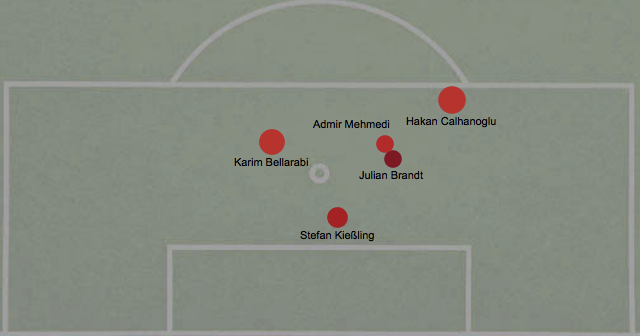
Offense Passing Map
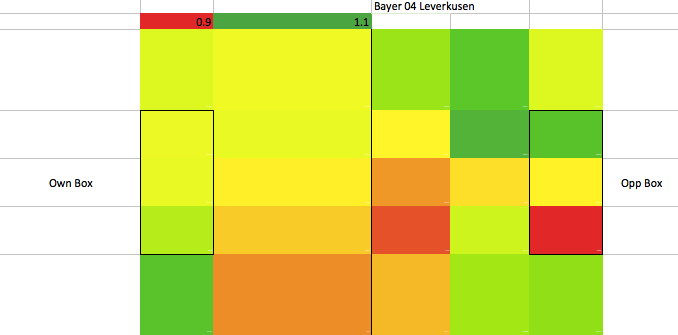
Defense Passing Map
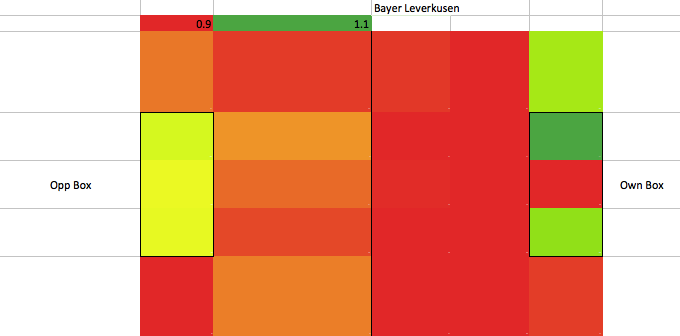
Key Passing Connections: Wendell-Calhanoglu
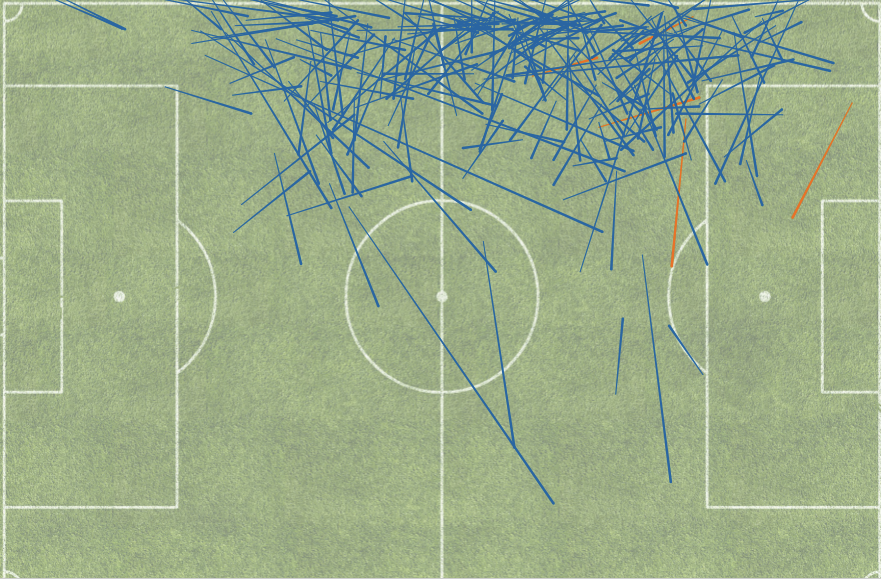
Calhanoglu-Kießling
Bellarabi-Calhanoglu
In: Kevin Volland 20m (Hoffenheim), Julian Baumgartlinger 4m (Mainz), Danny da Costa 0.5m (Ingolstadt)
Out: Christoph Kramer
Last year Leverkusen rebalanced a bit. By that I mean for a while their defense had raced out way ahead of their attack where the defense was elite but attack just above average. Last year the attack rose and the defense slacked a bit (hopefully because of the midfield injuries). The most important thing for this year is to keep the attack rising, I don't think this will be a Leicester type season where both Dortmund and Bayern drop huge amounts of points so Leverkusen need a huge haul of goals to really challenge for top two. The #1 man who will be involved with that is Karim Bellarabi. He's one of the most aggressive players with the ball in the league. Most players in his position move the ball forward 1-2 yards at a time but Bellarabi averages 6 at a time, only Volland and Kostic were higher. He’s eased off his insane dribbling pace from the year before (9.2 per 90 dropped to 5.6) but remained one of the best at making his key passes count (6th shortest KP on average in the league and racked up 11 assists on 44 KP’s).
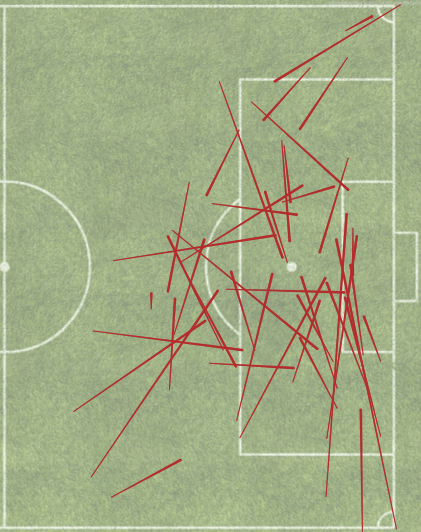
In his final 7 games he had 3 goals and 8 assists and Leverkusen won all of them. His partner in crime is Hakan Calhanoglu. Calhanoglu led the entire Bundesliga in shots + key passes/90 but certainly subscribed to quantity over quality. 71% of his 3.5 shots p90 came from outside the box (4th longest shot distance in the league) and 38% of his 3.2 KP/90 came on long crosses or corners. Passing wise he’s nearly as aggressive as Bellarabi, just a lot more involved (50 passes per game to Bellarabi’s 28) and coming from further back on the pitch. Both are relatively successful considering how high-risk they play, but should lose the ball less if Leverkusen are going to make the jump.
Stefan Kießling-Age has caught up with the long time Leverkusen striker. He’s 32 now and has been here since 2006. A new contract means he has 2 more years left but it’s hard to picture him being more than a sparingly used substitute and fan favorite if Leverkusen are to take steps forward. His shot volume is slipping, his passing fell off a cliff last season which leaves him as a hard worker but with little end product (though he still led the league by taking shots from just 9.6 yards away on average). This probably is known to the staff at Leverkusen as when he renewed their managing director mentioned he will stay with the club after his playing days and that “Stefan is a personality with whom we and our fans identify. He simply belongs with Bayer 04.” One thing he still has is shot quality, no one in the league took shots from closer on average than Kießling. He seems like a goal-chasing striker or possibly an option in rare games where they want to go over the top with Leno using long balls, which he did often when Kießling was on the pitch last year. Chicharito and his yearly consistent production across Europe will basically play as much as he can.
Kevin Kampl (MC): Found a home in the Schmidt midfield. Hyperactive playmaker whose skills were a much better fit here instead of on the wing in Dortmund. His hair is still looking for a place and time to fit in, 2004 Los Angeles remains his best bet. Leverkusen struggled badly without him as they never really found another player to be the slightly more advanced midfielder.
Charles Aranguiz (MC): He showed tentative signs of being comfortable at roaming forward a bit than either Kramer or Lars Bender in his cameos at the end of the year. A 3-man midfield with Bender deeper than Kampl and Aranguiz could be a tactical option if needed this season.
Aranguiz has a small sample size but bear with me here. Last year Christoph Kramer never really got comfortable in central midfield and didn't get the ball to Bellarabi or Calhanoglu as far forward or as commonly as Aranguiz and Kampl should be able to this year. Bellarabi received the ball 7 yards closer to goal on average when Kampl passed it to him compared to Kramer.
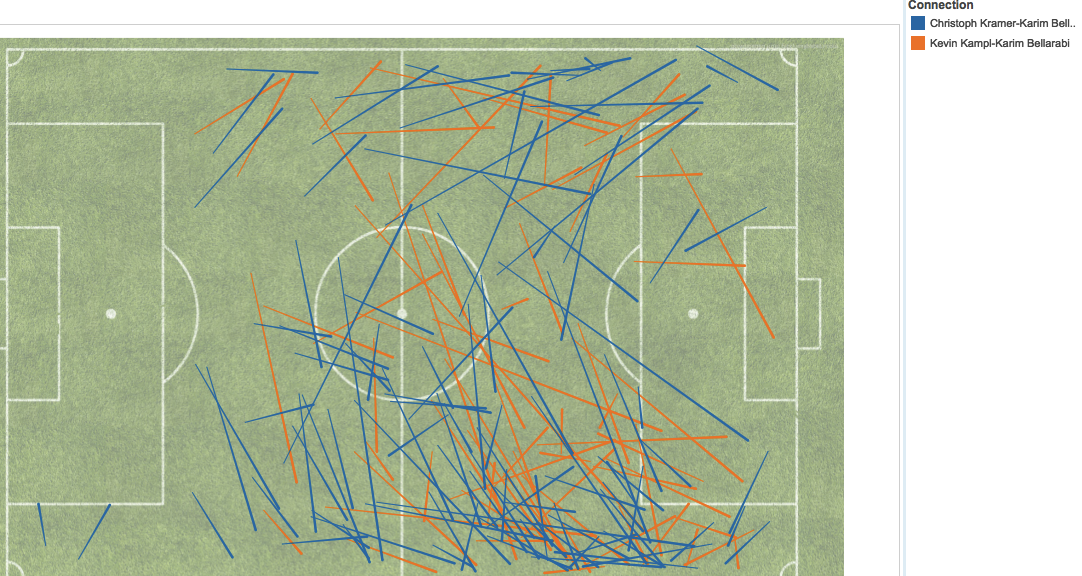
Aranguiz played very little after coming back from injury, but in his minor time was clearly a more advanced player than Kramer, Calhanoglu received the ball 6 yards closer on his handful of receptions from Aranguiz than he did from Kramer. Easier access to goal for the attacking players and more support from players behind is a recipe for more shots and goals. Both Aranguiz and Kampl can definitely do the defensive work needed making this 2-man midfield an all-around better fit. With Calhanoglu, Chicharito, Bellarabi and Brandt (who GoalImpact thinks is better than Neymar was at 20) in front of these two, Leverkusen have all the tools for their first truly elite attack in the Schmidt era.
If Aranguiz looks a little off the pace as he has at times in friendlies, or you need a little more defensive beef, Leverkusen have the two players who had the most tackles/90 last season in Lars Bender and Julian Baumgartlinger, in from Mainz.
Omer Toprak/Papadopoulous (CB)-The 2 narrowest center backs in the league. They were the only CBs on the list of top 10 players who had highest proportion of their passes from center of pitch alongside mainly immobile strikers like Bas Dost and Sven Schipplock. Papadopoulos rated as one of the worst passing centerbacks in the league.
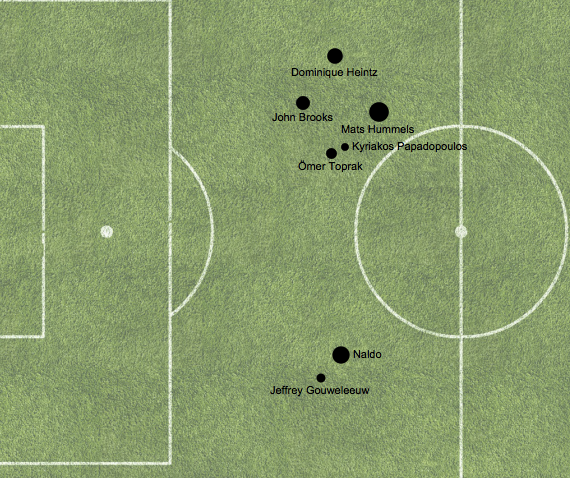
Average Pass Origin Location For Various CB's
As for why this true, my only guess is that Schmidt does not want his team open to through balls right up the gut so keeps his men central.
Fullback Talk
Wendell is a great fit at left back but right back was a weak link last year and could be another this year. Let's evaluate the candidates.
Roberto Hillbert and Tin Jedvaj are the returnees. Hillbert is getting old and was successful on just about half of his tackles and was rated as one of the poorest passers from his position in the league. In fact, Leverkusen fullbacks in total rate poorly outside of Wendell though this can be partially explained to the aggressive nature of their passing. Fullbacks on most of the other top-level teams advance the ball 4-6 yards on average while Leverkusen FB’s ranged from 8 (Wendell) to 12 yards (Boenisch) on average. Tin Jedvaj, a young prospect with a lot of hype, played at right back as well last year and was probably less convincing than Hillbert. Neither did well with the ball and the right side was Leverkusen’s significantly weaker side on defense. So unless Jedvaj makes a leap that I don't smell coming, looking elsewhere might be the best plan. Danny da Costa is a new signing from Ingolstadt that seems to be a nice fit at right back. His tackling stats were incredible: 8th most tackles per 90 and the highest success rate of any player in the top 75. He only came for 500k but should slide in defensively moving from a similar system. He seems more like a backup, which leaves just one more name: Benjamin Henrichs. The 19-year old showed very little ability with the ball but led the team in INT and tackles per 90 playing limited minutes as a defender. If you are ok with not using the right back as a key part of your buildup, which Leverkusen probably will be, Henrichs should get the first chance because he shows signs of being a defensive monster.
Leverkusen might be ok without involving right backs in buildup because of their sideline trap they look to to create quick chances. No team is near as tough to buildup along the sides against than Leverkusen, Schmidt might be looking first for someone who can keep these areas no-go for opponents. If he is, Jedvaj falls to the back of the line while Henrichs should get first chance.
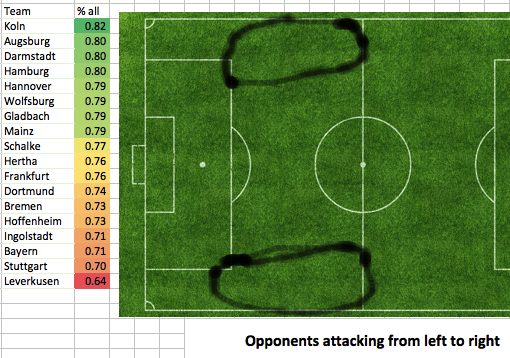
Good Season:
The midfield clicks back into place, press revs up to top speed and attack has some support from non-front 4 players. A title challenge follows.
Bad Season: The offense still can't generate quite enough to move close to the big 2, a Champions League scramble ensues.
Gladbach: Leaving Protectionism Behind
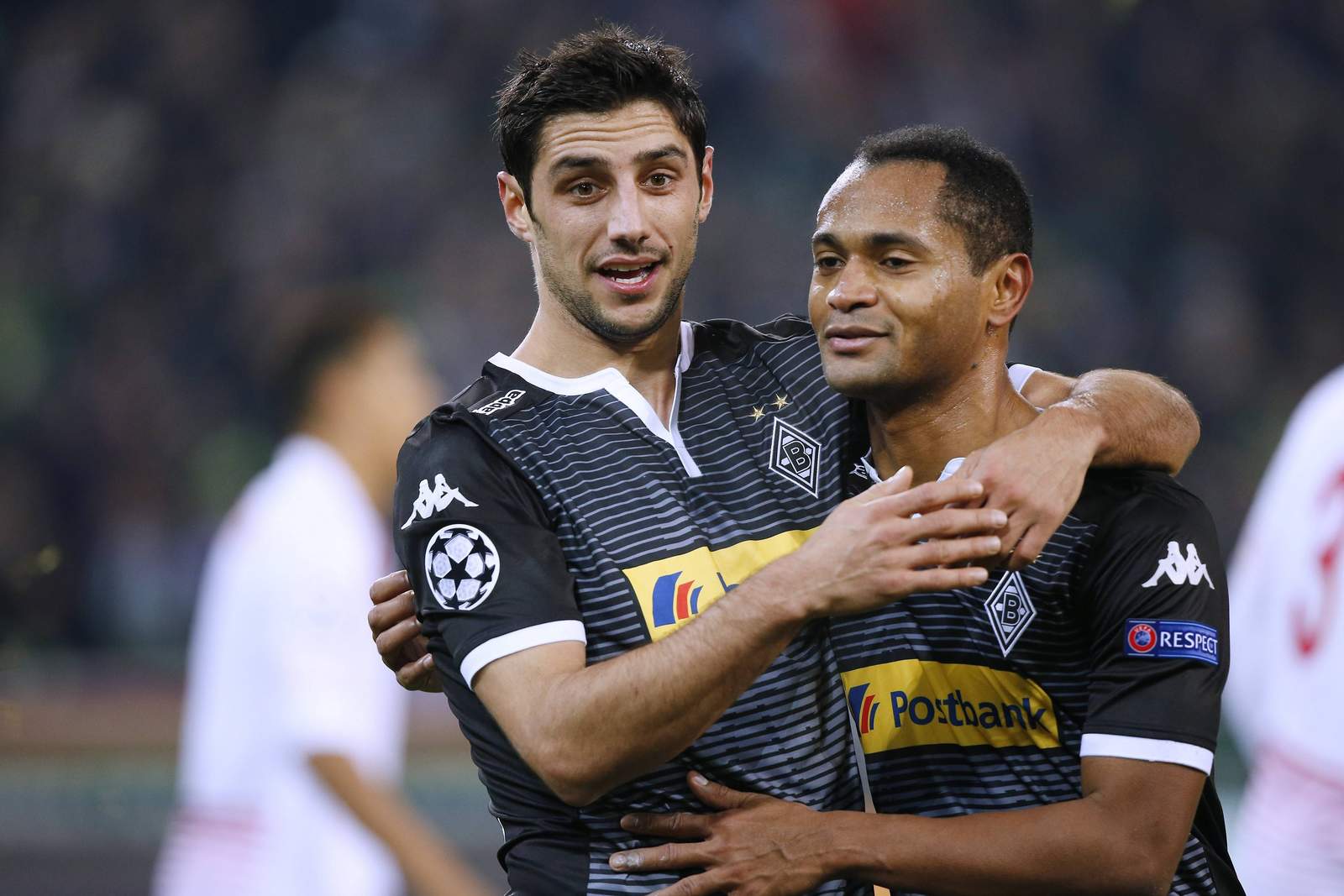
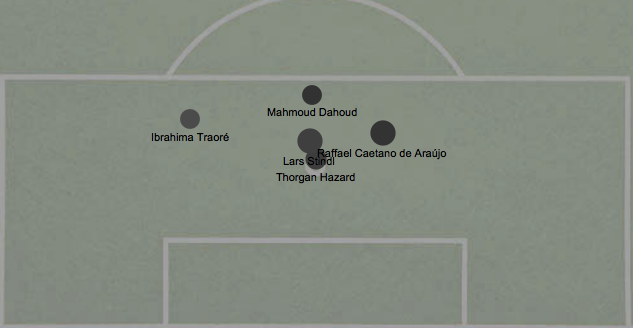 In: Christoph Kramer 15m (Leverkusen), Jannik Vestergaard 12.5m (Werder Bremen), Lászlo Bénes 2m (MSK Zilina), Tobias Strobl Free (Hoffenheim) Out: Granit Xhaka, Håvard Nordveit One Big Weakness? Andre Schubert pushed the team out into the world with an interventionist style and cast aside Lucien Favre's possibly outdated, protectionist strategy of conceding 90% of the field to defend your own box. The results were mixed. Promising in one big way: opponents simply got around the Gladbach goal a lot less (17% reduction) despite the press not quite clicking yet (opponents still played backwards on average in own half, indicating a high degree of comfortability). There are winners and losers when you make decisions like this (even if we don't like to admit it) and it comes in the new weakness around the box. Above 1=easier to pass against than league average on this chart.
In: Christoph Kramer 15m (Leverkusen), Jannik Vestergaard 12.5m (Werder Bremen), Lászlo Bénes 2m (MSK Zilina), Tobias Strobl Free (Hoffenheim) Out: Granit Xhaka, Håvard Nordveit One Big Weakness? Andre Schubert pushed the team out into the world with an interventionist style and cast aside Lucien Favre's possibly outdated, protectionist strategy of conceding 90% of the field to defend your own box. The results were mixed. Promising in one big way: opponents simply got around the Gladbach goal a lot less (17% reduction) despite the press not quite clicking yet (opponents still played backwards on average in own half, indicating a high degree of comfortability). There are winners and losers when you make decisions like this (even if we don't like to admit it) and it comes in the new weakness around the box. Above 1=easier to pass against than league average on this chart. 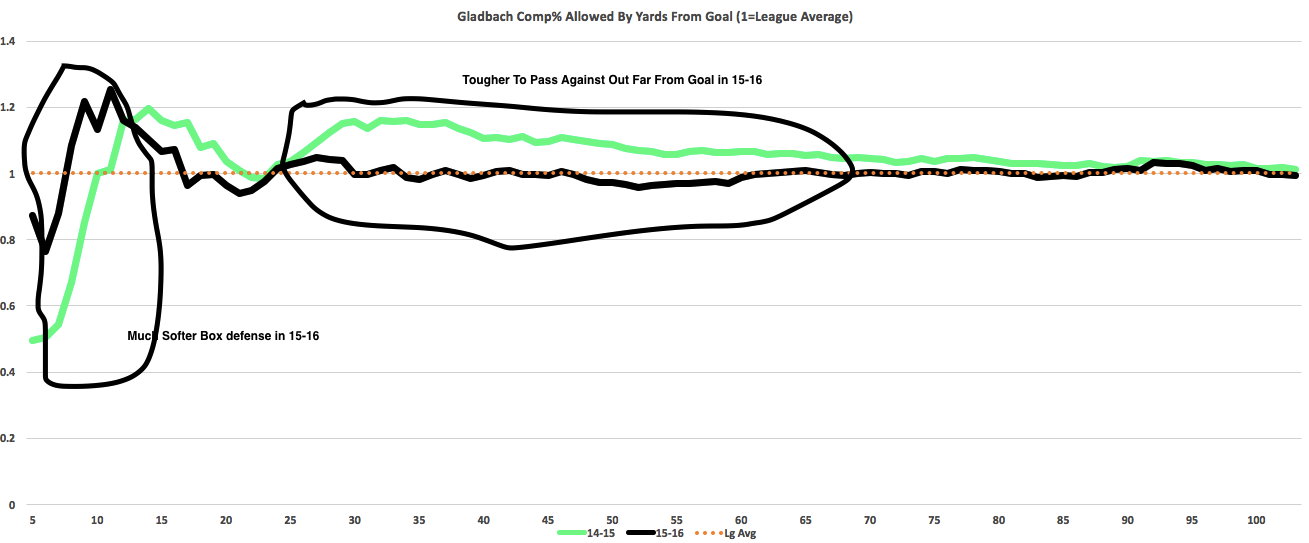 Favre excelled at getting numerical advantages in both boxes, with ratios at Bayern levels of Gladbach players to opposition on both sides. Schubert's gamble is that pushing out defensively will eventually let Gladbach play less of a high-wire act where every shot needs to be heavily pressured and move to a model where Gladbach simply allows fewer shots. A smaller weakness was their right side defense. 93 key passes came from that side, with just 62 from the left the most out of balance ratio in the league. Julian Korb, last years right back, has not been seen in the early going while Ibrahima Traoré slotted in at RWB for the UCL opener. One Big Strength: The two guys up front allowed Gladbach to set up shop in their attacks and decimate xG models yet again, scoring 15 more goals than Caley's model predicted. Max Kruse left and after some jitters early on, Lars Stindl slid right in as Raffael's partner in crime in Gladbach's unique attack. Neither of the two generate a huge amount of shots (2.3 per 90) or key passes (1.9) but they work together beautifully in keeping possession in dangerous areas, allowing Gladbach to flood the zone and have the 2nd-best ratio of attackers to defenders in the box on shots in the league (Bayern slightly ahead). Of the most 50 common attacking passing combinations (30 shown below), only Stindl to Raffael and Raffael to Stindl were both in the 5 shortest on average, and the 5 closest to goal. Close together and close to the opposition a goal, a fantastic combo.
Favre excelled at getting numerical advantages in both boxes, with ratios at Bayern levels of Gladbach players to opposition on both sides. Schubert's gamble is that pushing out defensively will eventually let Gladbach play less of a high-wire act where every shot needs to be heavily pressured and move to a model where Gladbach simply allows fewer shots. A smaller weakness was their right side defense. 93 key passes came from that side, with just 62 from the left the most out of balance ratio in the league. Julian Korb, last years right back, has not been seen in the early going while Ibrahima Traoré slotted in at RWB for the UCL opener. One Big Strength: The two guys up front allowed Gladbach to set up shop in their attacks and decimate xG models yet again, scoring 15 more goals than Caley's model predicted. Max Kruse left and after some jitters early on, Lars Stindl slid right in as Raffael's partner in crime in Gladbach's unique attack. Neither of the two generate a huge amount of shots (2.3 per 90) or key passes (1.9) but they work together beautifully in keeping possession in dangerous areas, allowing Gladbach to flood the zone and have the 2nd-best ratio of attackers to defenders in the box on shots in the league (Bayern slightly ahead). Of the most 50 common attacking passing combinations (30 shown below), only Stindl to Raffael and Raffael to Stindl were both in the 5 shortest on average, and the 5 closest to goal. Close together and close to the opposition a goal, a fantastic combo. 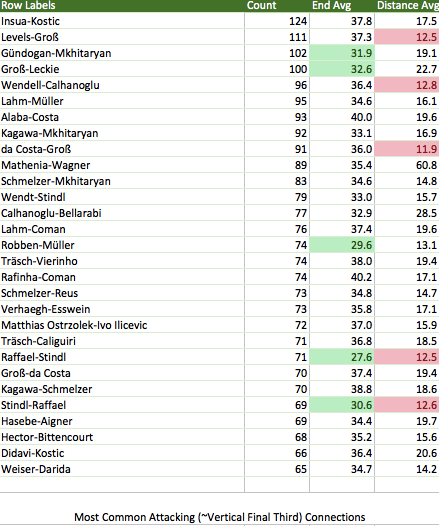 Passing Map
Passing Map 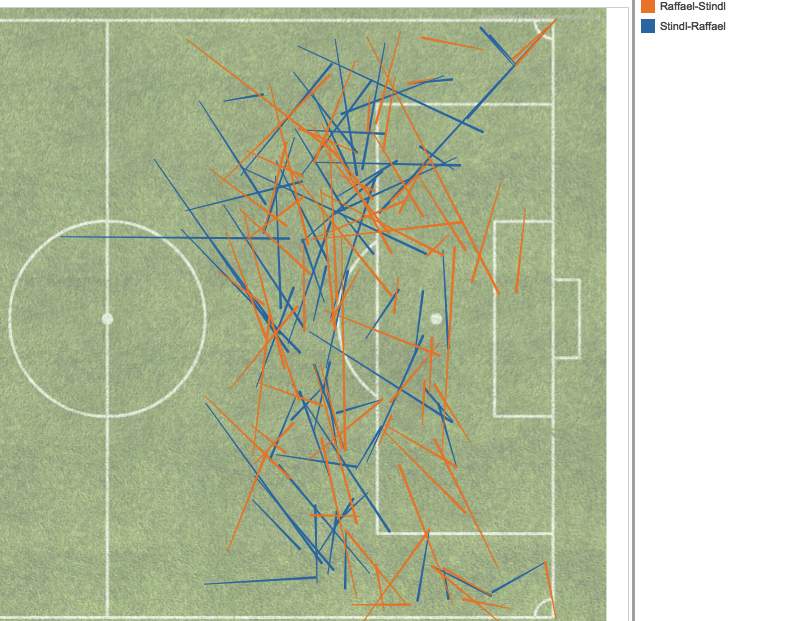 The interchangeability and unselfishness of the two led to some great results. Stindl generally played a bit behind Raffael, but would then move ahead of him after giving him the ball, leading to Raffael finding Stindl inside the box a good bit more. Christoph Kramer: Replacing Granit Xhaka in the buildup will be Gladbach's biggest problem with the ball this season. Xhaka averaged 80 and 89 passes per game the last two seasons, way ahead of any other non-Bayern or Dortmund player. Xhaka was an extremely deep-lying player, basically functioning in between a ball-playing center back and a midfielder. His average pass started 61 yards from goal, the only other midfielder so deep-lying was Serey Die from Stuttgart (who I think was a fantastic deal for Basel and am surprised a larger team didn't move for him). This clear separation in midfield roles was apparent in his connection with Dahoud, 64% of completions from Xhaka to Dahoud were forward passes. Compare this to Weigl-Gündogan (44% forward), Kramer-Kampl (33%), and Alonso-Vidal (50%). Not sure such a staggered midfield is necessarily a bad thing but I'd expect Kramer to be further forward than Xhaka was in the buildup and for Dahoud/fullbacks to pick up some of the build-up slack instead of a 85 pass per game season from Kramer. Also I'd expect fewer suspensions. Going to leave the actual number of times Xhaka was suspended as an exercise to the reader but it felt like a good 12-15 times I'd watch Gladbach and within 5 minutes of kickoff you'd hear "Granit Xhaka out due to suspension". Tony Jantschke: Last year was a disaster for him, as he struggled in the opening games and then went down with an injury. He is back now and looks to be an important part of what could be a back three for Gladbach. Xhaka leaving was the biggest story, but Håvard Nordveit will be a big loss also for his ability to kickstart an attack from the back. Jantschke and Nico Elvedi have both shown the passing ability that more classical defender Andreas Christensen and new signing Jannik Vestergaard might not have. Alvaro Dominguez's long-term, career-threatening back injury sadly looks like it will open up more minutes at CB, and especially if they go with 3, Jantschke might find himself back in the lineup as one of the wider CB's. He did in the first leg of the Champions League and he and Elvedi were the outlets and important (probably too important) in the buildup. Christensen-Janstche-Kramer was the main way to get the ball into midfield while Elvedi-Traoré advanced quickly down the right side.
The interchangeability and unselfishness of the two led to some great results. Stindl generally played a bit behind Raffael, but would then move ahead of him after giving him the ball, leading to Raffael finding Stindl inside the box a good bit more. Christoph Kramer: Replacing Granit Xhaka in the buildup will be Gladbach's biggest problem with the ball this season. Xhaka averaged 80 and 89 passes per game the last two seasons, way ahead of any other non-Bayern or Dortmund player. Xhaka was an extremely deep-lying player, basically functioning in between a ball-playing center back and a midfielder. His average pass started 61 yards from goal, the only other midfielder so deep-lying was Serey Die from Stuttgart (who I think was a fantastic deal for Basel and am surprised a larger team didn't move for him). This clear separation in midfield roles was apparent in his connection with Dahoud, 64% of completions from Xhaka to Dahoud were forward passes. Compare this to Weigl-Gündogan (44% forward), Kramer-Kampl (33%), and Alonso-Vidal (50%). Not sure such a staggered midfield is necessarily a bad thing but I'd expect Kramer to be further forward than Xhaka was in the buildup and for Dahoud/fullbacks to pick up some of the build-up slack instead of a 85 pass per game season from Kramer. Also I'd expect fewer suspensions. Going to leave the actual number of times Xhaka was suspended as an exercise to the reader but it felt like a good 12-15 times I'd watch Gladbach and within 5 minutes of kickoff you'd hear "Granit Xhaka out due to suspension". Tony Jantschke: Last year was a disaster for him, as he struggled in the opening games and then went down with an injury. He is back now and looks to be an important part of what could be a back three for Gladbach. Xhaka leaving was the biggest story, but Håvard Nordveit will be a big loss also for his ability to kickstart an attack from the back. Jantschke and Nico Elvedi have both shown the passing ability that more classical defender Andreas Christensen and new signing Jannik Vestergaard might not have. Alvaro Dominguez's long-term, career-threatening back injury sadly looks like it will open up more minutes at CB, and especially if they go with 3, Jantschke might find himself back in the lineup as one of the wider CB's. He did in the first leg of the Champions League and he and Elvedi were the outlets and important (probably too important) in the buildup. Christensen-Janstche-Kramer was the main way to get the ball into midfield while Elvedi-Traoré advanced quickly down the right side. 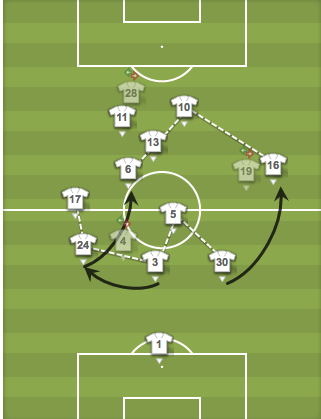 Ibrahima Traoré-As seen above he's kind of been retrained as a wingback. I think he should have played more as a right-winger last year, will be interesting to see if he can handle right wing-back and make it his own. Andre Hahn-Last year Gladbach spent big on Josip Drmic, a forward with awful on-the-ball skills, and it was a total disaster. Drmic was eventually loaned out and now it's hard to see him ever making a big impact. I say all that to say I sort of see Hahn as a similar player, with some important differences. Similar in that he's a pure shot-taker that doesn't interact at all with other attackers. Important differences are he actually gets shots (2.7 per 90 in-box shots compared with Drmic's career high of 2.1) and he's actually even worse than Drmic trying to pass. He's arguably the worst passer in the Bundesliga, his career 60% completion rate is paltry on a team that usually is well above 70% in the areas he is passing from. It's a risk to play him as he's so reliant on everyone else and can kill your attack when he has to help against good teams. Ideally would be used as a chasing a goal sub on a team like this because there are certainly shots there for taking if he's alongside Stindl-Raffael. His awful passing can be seen here using passer rating, a stat that adjusts completion % for starting and ending position.
Ibrahima Traoré-As seen above he's kind of been retrained as a wingback. I think he should have played more as a right-winger last year, will be interesting to see if he can handle right wing-back and make it his own. Andre Hahn-Last year Gladbach spent big on Josip Drmic, a forward with awful on-the-ball skills, and it was a total disaster. Drmic was eventually loaned out and now it's hard to see him ever making a big impact. I say all that to say I sort of see Hahn as a similar player, with some important differences. Similar in that he's a pure shot-taker that doesn't interact at all with other attackers. Important differences are he actually gets shots (2.7 per 90 in-box shots compared with Drmic's career high of 2.1) and he's actually even worse than Drmic trying to pass. He's arguably the worst passer in the Bundesliga, his career 60% completion rate is paltry on a team that usually is well above 70% in the areas he is passing from. It's a risk to play him as he's so reliant on everyone else and can kill your attack when he has to help against good teams. Ideally would be used as a chasing a goal sub on a team like this because there are certainly shots there for taking if he's alongside Stindl-Raffael. His awful passing can be seen here using passer rating, a stat that adjusts completion % for starting and ending position. 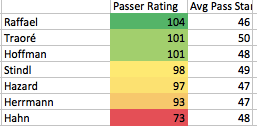 Good Season: Shot and deep completion count swings a little toward their side, high press is more disruptive and the Stindl-Raffael axis continues to tear apart opposition blocks as Gladbach hangs with Leverkusen and Dortmund for most of the season while finishing comfortably ahead of Schalke and Wolfsburg in the top 4. Bad Season: The higher press is only sporadically effective, Xhaka and Nordveit's loss leave the team wobbly in build-up and midfield defense and expected goals finally wins out in year 5 as Gladbach sink to mid-table.
Good Season: Shot and deep completion count swings a little toward their side, high press is more disruptive and the Stindl-Raffael axis continues to tear apart opposition blocks as Gladbach hangs with Leverkusen and Dortmund for most of the season while finishing comfortably ahead of Schalke and Wolfsburg in the top 4. Bad Season: The higher press is only sporadically effective, Xhaka and Nordveit's loss leave the team wobbly in build-up and midfield defense and expected goals finally wins out in year 5 as Gladbach sink to mid-table.
The Favorites: Bayern Munich
 Carlo Ancelotti is in for Pep and it might remind some of when Pep came in for Jupp Heynckes 3 years ago. Bayern were coming off a triple when Pep came in to some mutters about how could he improve anything? Well, he improved basically every aspect of Bayern's play each season and last year it was nearly overwhelming soccer at times. Everything you could imagine Bayern dominated at. They faced full boxes all season and still had the 3rd-lowest shot blocked rate in the league and somehow were able to shoot against a league average number of defenders in the box. They pushed players forward in possession more than anyone in Europe, yet were nearly impossible to counter against. They were able to get plenty of defenders back and pressure shooters, which was their rivals Dortmund big weakness. High press, crossing skill, completing dangerous passes, on and on and on they were the best in the league. It was getting to be a little too much really, for probably 12-15 opponents in the league there was almost no point in watching because you knew how the script would play out. That's what I'm personally most looking forward to with Ancelotti. I don't see how he can take Bayern to a higher level, but for neutrals at least it promises different plot lines. You can only watch The Godfather so many times before Michael saying Tessio was always smarter no longer has emotional resonance, you know what I mean? A good example of the changing plot comes in comparing Pep's last competitive game vs Ancelotti's first, both against Dortmund. Pep went out with 70% possession in the Cup final while Dortmund wound up with 56% in the Super Cup, which I imagine would be a high against Pep. I think this change in managers gives us a real chance at Bayern dropping enough points for real drama throughout the season. Shot Map
Carlo Ancelotti is in for Pep and it might remind some of when Pep came in for Jupp Heynckes 3 years ago. Bayern were coming off a triple when Pep came in to some mutters about how could he improve anything? Well, he improved basically every aspect of Bayern's play each season and last year it was nearly overwhelming soccer at times. Everything you could imagine Bayern dominated at. They faced full boxes all season and still had the 3rd-lowest shot blocked rate in the league and somehow were able to shoot against a league average number of defenders in the box. They pushed players forward in possession more than anyone in Europe, yet were nearly impossible to counter against. They were able to get plenty of defenders back and pressure shooters, which was their rivals Dortmund big weakness. High press, crossing skill, completing dangerous passes, on and on and on they were the best in the league. It was getting to be a little too much really, for probably 12-15 opponents in the league there was almost no point in watching because you knew how the script would play out. That's what I'm personally most looking forward to with Ancelotti. I don't see how he can take Bayern to a higher level, but for neutrals at least it promises different plot lines. You can only watch The Godfather so many times before Michael saying Tessio was always smarter no longer has emotional resonance, you know what I mean? A good example of the changing plot comes in comparing Pep's last competitive game vs Ancelotti's first, both against Dortmund. Pep went out with 70% possession in the Cup final while Dortmund wound up with 56% in the Super Cup, which I imagine would be a high against Pep. I think this change in managers gives us a real chance at Bayern dropping enough points for real drama throughout the season. Shot Map 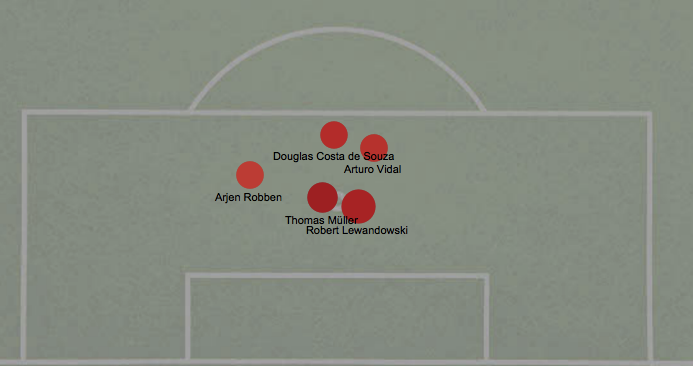 Defensive Map
Defensive Map 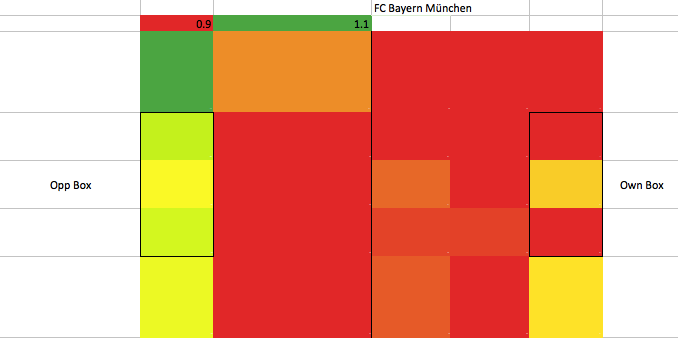 Key Pass Leaders
Key Pass Leaders 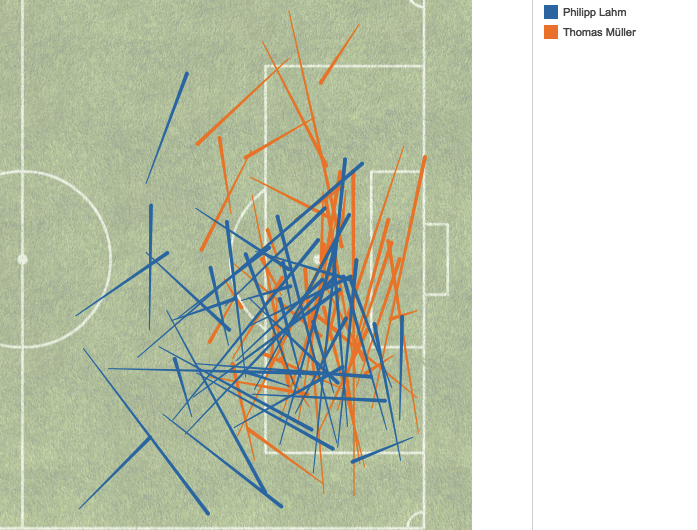 In: Mats Hummels 38m (Dortmund), Renato Sanches 35m (Benfica) Out: Mario Gotze, Pierre-Emile Höjbjerg, Sebastian Rode, Mehdi Benatia One Big Strength: They close in on you in numbers to play the final ball at close range, where passes are much more accurate. Their average vertical passing distance in the final 30 yards was 9.1 yards, no other team had lower than 11.5. This helped them lead the league in deep completion rate at 44.6%. The fact they have so many players forward allows for unpredictability in where the ball comes from. No player was in the top 8 in Key Passes but Thomas Müller was 9th and Costa/Lahm/Vidal were 15-17th.
In: Mats Hummels 38m (Dortmund), Renato Sanches 35m (Benfica) Out: Mario Gotze, Pierre-Emile Höjbjerg, Sebastian Rode, Mehdi Benatia One Big Strength: They close in on you in numbers to play the final ball at close range, where passes are much more accurate. Their average vertical passing distance in the final 30 yards was 9.1 yards, no other team had lower than 11.5. This helped them lead the league in deep completion rate at 44.6%. The fact they have so many players forward allows for unpredictability in where the ball comes from. No player was in the top 8 in Key Passes but Thomas Müller was 9th and Costa/Lahm/Vidal were 15-17th. 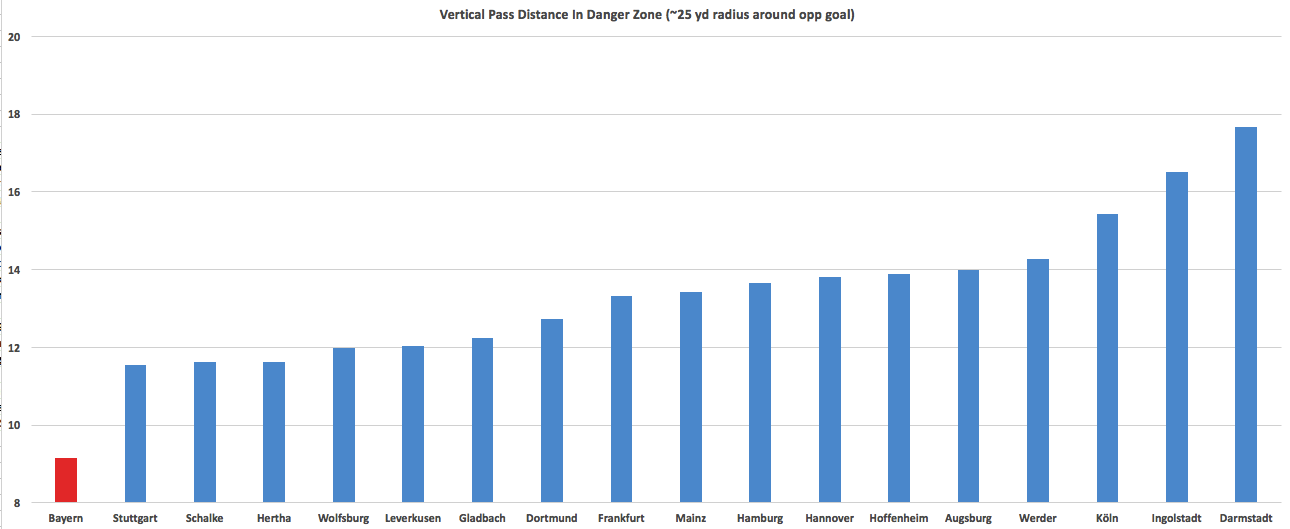 One Weakness: It's basically impossible to find a statistical weakness for them last season. Their shots were of just slightly above average quality so we'll go with that. More minutes for Robbery should solve that, though as always that remains something you can't count on. Key Passing Combos Robben-Müller
One Weakness: It's basically impossible to find a statistical weakness for them last season. Their shots were of just slightly above average quality so we'll go with that. More minutes for Robbery should solve that, though as always that remains something you can't count on. Key Passing Combos Robben-Müller 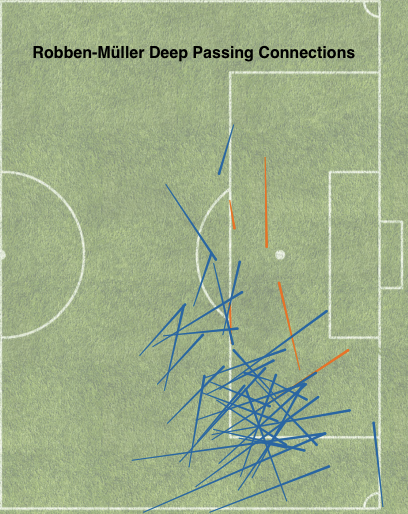 Thiago-Ribéry (86 connections in 512 minutes) Lahm-Müller Müller-Lewandowski Alaba-Thiago Wing Play When Bayern got a bit bogged down and looked ordinary under Pep it was always when Robben and Ribéry were out. 2 years ago they looked just like a good Bundesliga team without those two, last year was a bit better as they bought two good replacements in Costa and Coman. This year we've all heard about Ribéry being happier with Ancelloti but we've also seen a Robben injury. Let's take a closer look at the 4 main wing options that are so crucial to Bayern's dominance. Arjen Robben-The Robben to Müller connection mentioned above was devastating even though the two only played ~900 minutes together on the season. Basically you could count on Robben finding Müller over 4 times per game in the final 30 yards, just an insane number. A look at how they worked together in 2 games, I always find it nice to have a mental image of a statistical truth even if you discount some of this because it was against Stuttgart. Robben was 2nd in the league in shots + KPs per 90 as well. I suspect his early baldness has made people about 25% more likely to assume he's no longer elite. If he gets underestimated on superficial things, at least he's got a conversation starter with Larry David next time he's in LA. Franck Ribéry-He led the league in key passes per 90. Both these guys sometimes slip from the radar (for good reason when it comes to injuries) but when they are on the field, they are still two of the best players in the world. A bigger chunk of minutes from Robbery would be the best argument for Bayern to just continue on rolling without Pep. Combines being one of the most aggressive forward passers in the league with a completion percentage above 80%. Douglas Costa-I think if he was on Wolfsburg or Werder Bremen he would be criticized constantly for being selfish, trying 1-on-1 moves too much, and playing the low-percentage cross instead of circulating the ball. Even at Bayern he gets criticized sometimes for this, but it's a good example of players not being static ratings. At Bayern he has more space, more passing options, and a coach who encouraged attacking dribbles and his team pouncing on unsuccessful crosses. He was a bit wasteful with the ball but would still terrorize opponent defenses several times a game. I'd put him easily 4th on the Bayern wide players list but still scares opponents. Kingsley Coman-He's not near the Robbery level yet but shows signs at just 20 of being a player in that mold. His passing is excellent and he was clearly trusted by Pep to break down a defense (his 8.2 dribbles per 90 only trailed Ribéry's insane 10.7). The shots and KP's were nowhere near Robbery levels and he's not as forward looking as the other 3 wide men (passes go 1.6 yards closer to goal, Ribéry 4 yards closer for example) but he does have an eye for shot quality (17.5 yards on average, a bit closer than both Robben and Ribéry and much closer than Costa's 24.5).
Thiago-Ribéry (86 connections in 512 minutes) Lahm-Müller Müller-Lewandowski Alaba-Thiago Wing Play When Bayern got a bit bogged down and looked ordinary under Pep it was always when Robben and Ribéry were out. 2 years ago they looked just like a good Bundesliga team without those two, last year was a bit better as they bought two good replacements in Costa and Coman. This year we've all heard about Ribéry being happier with Ancelloti but we've also seen a Robben injury. Let's take a closer look at the 4 main wing options that are so crucial to Bayern's dominance. Arjen Robben-The Robben to Müller connection mentioned above was devastating even though the two only played ~900 minutes together on the season. Basically you could count on Robben finding Müller over 4 times per game in the final 30 yards, just an insane number. A look at how they worked together in 2 games, I always find it nice to have a mental image of a statistical truth even if you discount some of this because it was against Stuttgart. Robben was 2nd in the league in shots + KPs per 90 as well. I suspect his early baldness has made people about 25% more likely to assume he's no longer elite. If he gets underestimated on superficial things, at least he's got a conversation starter with Larry David next time he's in LA. Franck Ribéry-He led the league in key passes per 90. Both these guys sometimes slip from the radar (for good reason when it comes to injuries) but when they are on the field, they are still two of the best players in the world. A bigger chunk of minutes from Robbery would be the best argument for Bayern to just continue on rolling without Pep. Combines being one of the most aggressive forward passers in the league with a completion percentage above 80%. Douglas Costa-I think if he was on Wolfsburg or Werder Bremen he would be criticized constantly for being selfish, trying 1-on-1 moves too much, and playing the low-percentage cross instead of circulating the ball. Even at Bayern he gets criticized sometimes for this, but it's a good example of players not being static ratings. At Bayern he has more space, more passing options, and a coach who encouraged attacking dribbles and his team pouncing on unsuccessful crosses. He was a bit wasteful with the ball but would still terrorize opponent defenses several times a game. I'd put him easily 4th on the Bayern wide players list but still scares opponents. Kingsley Coman-He's not near the Robbery level yet but shows signs at just 20 of being a player in that mold. His passing is excellent and he was clearly trusted by Pep to break down a defense (his 8.2 dribbles per 90 only trailed Ribéry's insane 10.7). The shots and KP's were nowhere near Robbery levels and he's not as forward looking as the other 3 wide men (passes go 1.6 yards closer to goal, Ribéry 4 yards closer for example) but he does have an eye for shot quality (17.5 yards on average, a bit closer than both Robben and Ribéry and much closer than Costa's 24.5). 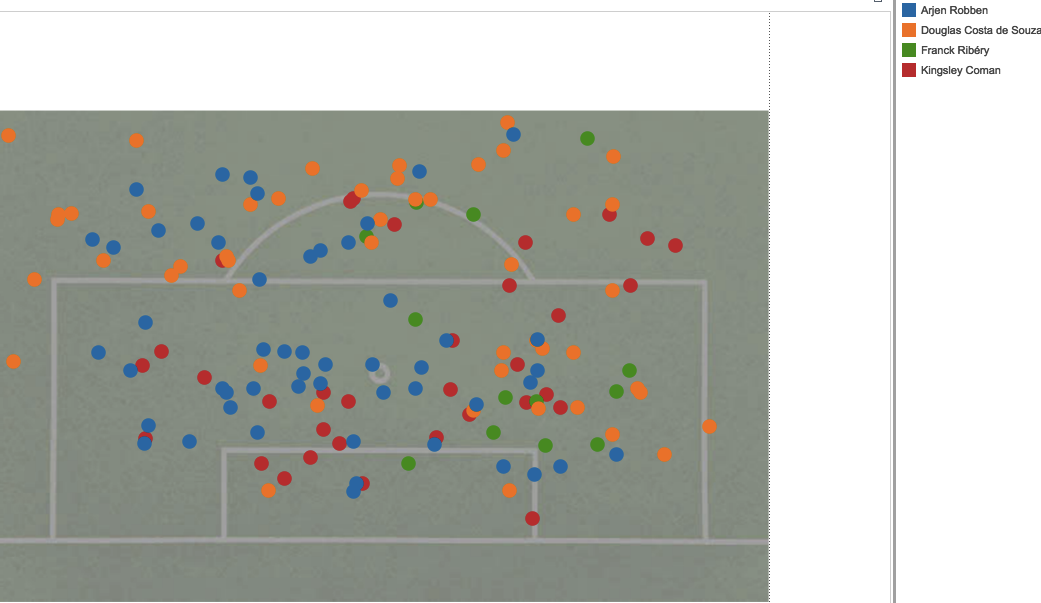 Coman also has an ability to get involved that Costa doesn't seem to have. Ribéry, Robben and Coman all received 27+ passes per 90 in the final third while Costa was down around 20 in the Müller range. Midfield Questions A big question will be if there is room for both Vidal and Thiago in the Bayern midfield this season. Both were in the top 10 for most tackles per 90 last season, and would be right near the top if possession-adjusted. If you put any stock into tackle success rates, Thiago was behind only Lars Bender as he won 77% of his tackles. Both are strong at winning the ball back and both are great passers but there are slight differences here. Both occupied similar spots to play their passes but Vidal was more conservative as their maps show:
Coman also has an ability to get involved that Costa doesn't seem to have. Ribéry, Robben and Coman all received 27+ passes per 90 in the final third while Costa was down around 20 in the Müller range. Midfield Questions A big question will be if there is room for both Vidal and Thiago in the Bayern midfield this season. Both were in the top 10 for most tackles per 90 last season, and would be right near the top if possession-adjusted. If you put any stock into tackle success rates, Thiago was behind only Lars Bender as he won 77% of his tackles. Both are strong at winning the ball back and both are great passers but there are slight differences here. Both occupied similar spots to play their passes but Vidal was more conservative as their maps show: 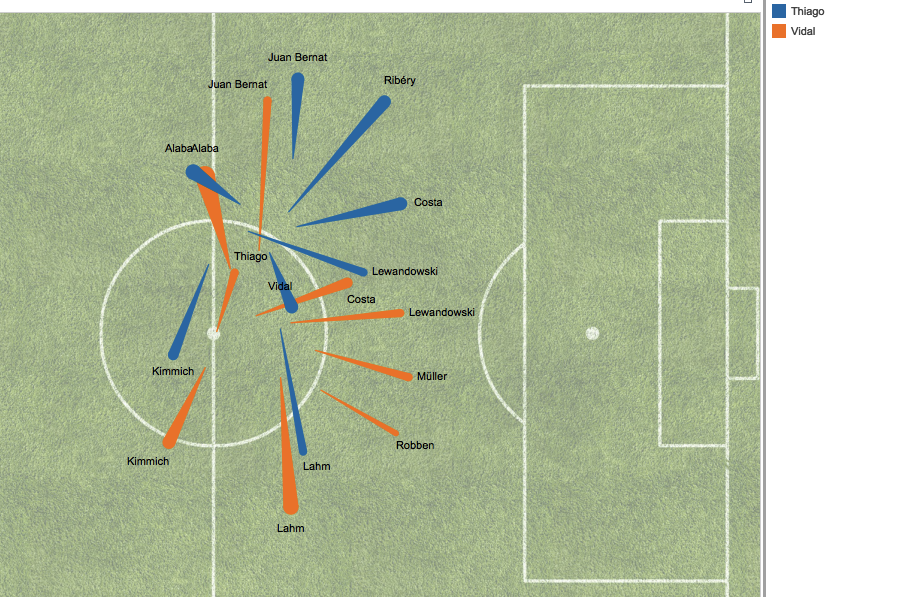 Thiago finds attackers a good bit more than Vidal does (thickness of arrow represents share of total passes). The Thiago-Ribéry connection looks to be one that should be played together as much as possible. In 512 minutes, Thiago completed 86 passes to Ribéry, including a ridiculous 30 against Werder Bremen in March. Flipping through the clips it seemed pretty clear Thiago's first instinct when he got the ball was to look for Ribéry and the two worked excellently together. Vidal doesn't show signs of developing any forward connection like that so if there's only room for one, I'd go with Thiago. Ideally they learn to play together with Vidal a bit more withdrawn so Alonso's aging legs don't become a worry in big games. Xabi Alonso is still going strong at 34 and Renato Sanches at age 19 offer other options. An attack that could fit Lewandowski, Thiago, Robben, Müller, and Ribéry with Lahm/Alaba/Vidal also on the pitch feels like the only lineup in the world that can match up with Barcelona. Making the Trench Run Down Bayern's Left David Alaba was pretty bad in the Euros. It sort of felt like your cool friend who usually plays with the older kids coming back and deciding he can do whatever he wants, like play attacking midfield. Turns out he's not suited for attacking midfield quite yet. Subbed off with 30 minutes to play against Portugal was a bad way to remember his summer. Now he's back and should quickly erase those memories with high level performances. Should we worry at all that he was 50th (out of 52) in interceptions and 52th in tackles among center backs? Probably not, Boateng was 50th in tackles and 38th in interceptions. There's just not many chances for the Bayern backline to rack up defensive counting stats. If there is one thing he should worry about it's how teams seemed to target the left side last year when on the attack.
Thiago finds attackers a good bit more than Vidal does (thickness of arrow represents share of total passes). The Thiago-Ribéry connection looks to be one that should be played together as much as possible. In 512 minutes, Thiago completed 86 passes to Ribéry, including a ridiculous 30 against Werder Bremen in March. Flipping through the clips it seemed pretty clear Thiago's first instinct when he got the ball was to look for Ribéry and the two worked excellently together. Vidal doesn't show signs of developing any forward connection like that so if there's only room for one, I'd go with Thiago. Ideally they learn to play together with Vidal a bit more withdrawn so Alonso's aging legs don't become a worry in big games. Xabi Alonso is still going strong at 34 and Renato Sanches at age 19 offer other options. An attack that could fit Lewandowski, Thiago, Robben, Müller, and Ribéry with Lahm/Alaba/Vidal also on the pitch feels like the only lineup in the world that can match up with Barcelona. Making the Trench Run Down Bayern's Left David Alaba was pretty bad in the Euros. It sort of felt like your cool friend who usually plays with the older kids coming back and deciding he can do whatever he wants, like play attacking midfield. Turns out he's not suited for attacking midfield quite yet. Subbed off with 30 minutes to play against Portugal was a bad way to remember his summer. Now he's back and should quickly erase those memories with high level performances. Should we worry at all that he was 50th (out of 52) in interceptions and 52th in tackles among center backs? Probably not, Boateng was 50th in tackles and 38th in interceptions. There's just not many chances for the Bayern backline to rack up defensive counting stats. If there is one thing he should worry about it's how teams seemed to target the left side last year when on the attack. 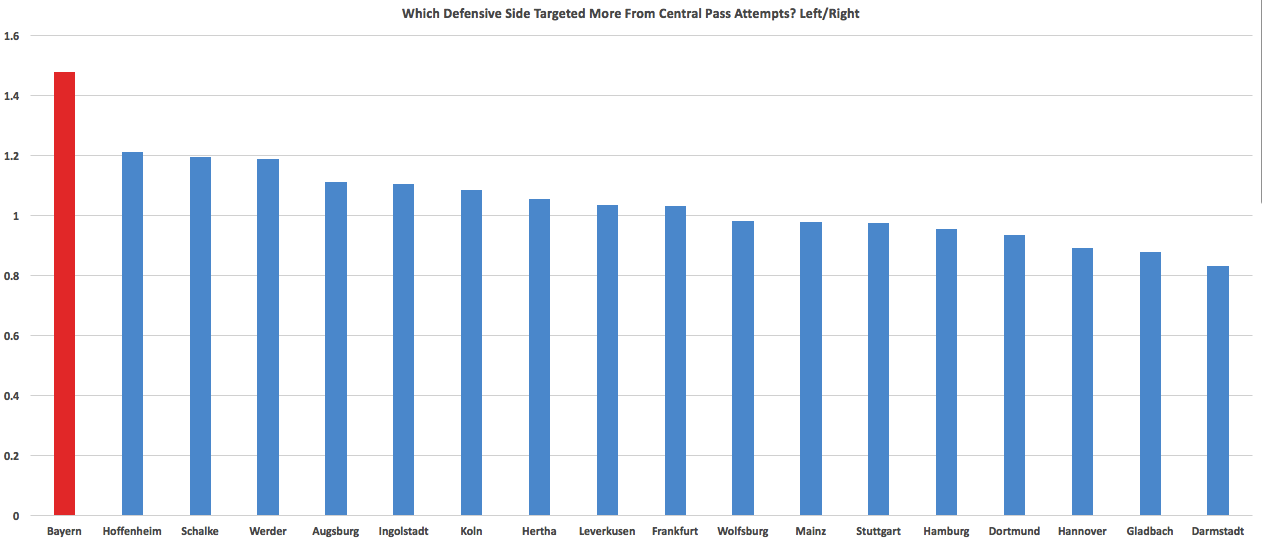 It was rare for opponents to get the ball in the middle of the Bayern side of the pitch but when they did it was 50% more likely for the ball to be played to Bayern's left side. No team had a greater share of key passes allowed come from their left (20 more than right). Again these are still small numbers in total, but always know your weaknesses. Alaba presumably will be out there more this season and should be aware this is where opponents tried the trench run last year. Good (for Bayern) Season: A little less possession doesn't hurt anyone and Bayern cruise to a title, blooding in Coman, Hummels, and Sanches and set the league scarily toward the PSG route. Good (for neutrals) Season: Less possession means more goals allowed, more variance, and more upsets. We find out Mats Hummels can be beaten on the break, even at Bayern, and Robbery get injured again. They don't win title and sit in 3rd place for at least a while.
It was rare for opponents to get the ball in the middle of the Bayern side of the pitch but when they did it was 50% more likely for the ball to be played to Bayern's left side. No team had a greater share of key passes allowed come from their left (20 more than right). Again these are still small numbers in total, but always know your weaknesses. Alaba presumably will be out there more this season and should be aware this is where opponents tried the trench run last year. Good (for Bayern) Season: A little less possession doesn't hurt anyone and Bayern cruise to a title, blooding in Coman, Hummels, and Sanches and set the league scarily toward the PSG route. Good (for neutrals) Season: Less possession means more goals allowed, more variance, and more upsets. We find out Mats Hummels can be beaten on the break, even at Bayern, and Robbery get injured again. They don't win title and sit in 3rd place for at least a while.
The Bundesliga's Upwardly Mobile Middle Class? Mainz, Hamburg and Hoffenheim
Mainz 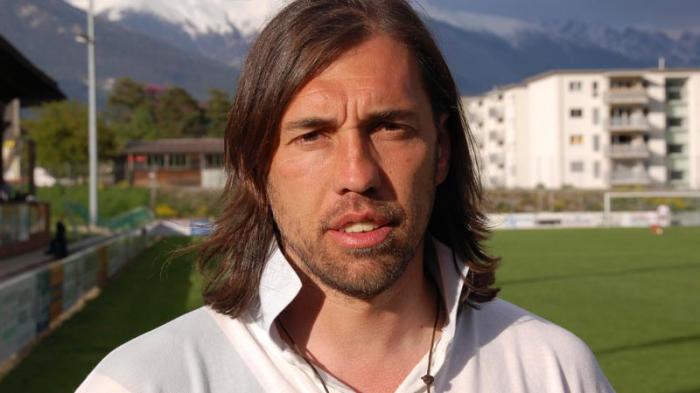
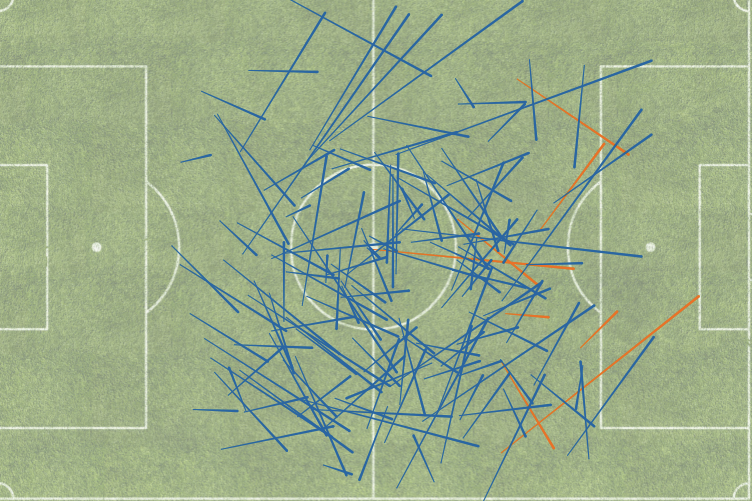 Mainz quietly leapt from 11th to 6th and the Europa League last season, how did they do it? They had 10% fewer attacks than they year before and 13% fewer shots while seeing shots allowed and attacks allowed creep up a bit but the location improved massively. Mainz average shot for of 17.5 yards was only topped by Dortmund and represented an enormous leap from last years ~league average 19.3 yard shot. They are listed alongside RB Leipzig as a cut above the rest of the mid table clubs by the bookies which indicates the esteemed men behind the counter at the gambling halls expect Mainz's attack improvement to last this season. One Big Strength The previously mentioned shot quality. Jhon Cordoba-13 yards, Yoshinori Muto 13.7 yards, Pablo de Blasis 16.3 yards. Mainz got ~3 shots per game from these secondary options but they were from way in close and scored 12 goals at a high conversion rate.
Mainz quietly leapt from 11th to 6th and the Europa League last season, how did they do it? They had 10% fewer attacks than they year before and 13% fewer shots while seeing shots allowed and attacks allowed creep up a bit but the location improved massively. Mainz average shot for of 17.5 yards was only topped by Dortmund and represented an enormous leap from last years ~league average 19.3 yard shot. They are listed alongside RB Leipzig as a cut above the rest of the mid table clubs by the bookies which indicates the esteemed men behind the counter at the gambling halls expect Mainz's attack improvement to last this season. One Big Strength The previously mentioned shot quality. Jhon Cordoba-13 yards, Yoshinori Muto 13.7 yards, Pablo de Blasis 16.3 yards. Mainz got ~3 shots per game from these secondary options but they were from way in close and scored 12 goals at a high conversion rate. 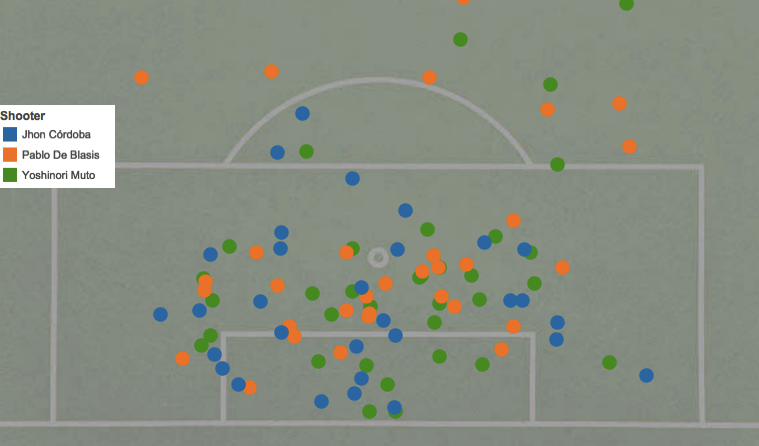 Yunus Malli was at 17.6 yards per shot and Jairo Samperio at 17.7 leaving only Christian Clemens as a somewhat long range bomber (just over 20 yards) among their varied attack. All 6 players mentioned took between 1.5 and 2.3 shots per 90. The shots were varied and so were the key passes, 6 players were between 1 and 1.6 with no one above that. This spread was so varied partially because of their reliance on the counter and the fact they had the 3rd fewest completions in attacking areas in the league. Their abandonment of midfield and quality deep in the opponent half is apparent on their passing map (green=over-performing "expected completions", red the opposite).
Yunus Malli was at 17.6 yards per shot and Jairo Samperio at 17.7 leaving only Christian Clemens as a somewhat long range bomber (just over 20 yards) among their varied attack. All 6 players mentioned took between 1.5 and 2.3 shots per 90. The shots were varied and so were the key passes, 6 players were between 1 and 1.6 with no one above that. This spread was so varied partially because of their reliance on the counter and the fact they had the 3rd fewest completions in attacking areas in the league. Their abandonment of midfield and quality deep in the opponent half is apparent on their passing map (green=over-performing "expected completions", red the opposite). 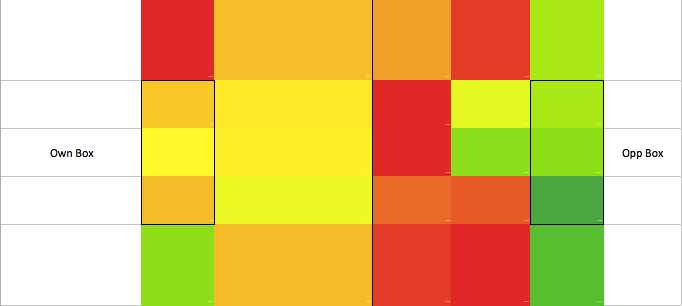 That's a very distinctive looking map that I rarely see. Mainz seemed to know they were bad at controlling the ball through the attacking midfield area (all the red blocks) and skipped the area completely: only Hertha had a lower proportion of their completions in the 2nd and 3rd from the right vertical blocks. And unlike Hertha, Mainz were able to get the ball deep without heavily using the attacking midfield.
That's a very distinctive looking map that I rarely see. Mainz seemed to know they were bad at controlling the ball through the attacking midfield area (all the red blocks) and skipped the area completely: only Hertha had a lower proportion of their completions in the 2nd and 3rd from the right vertical blocks. And unlike Hertha, Mainz were able to get the ball deep without heavily using the attacking midfield. 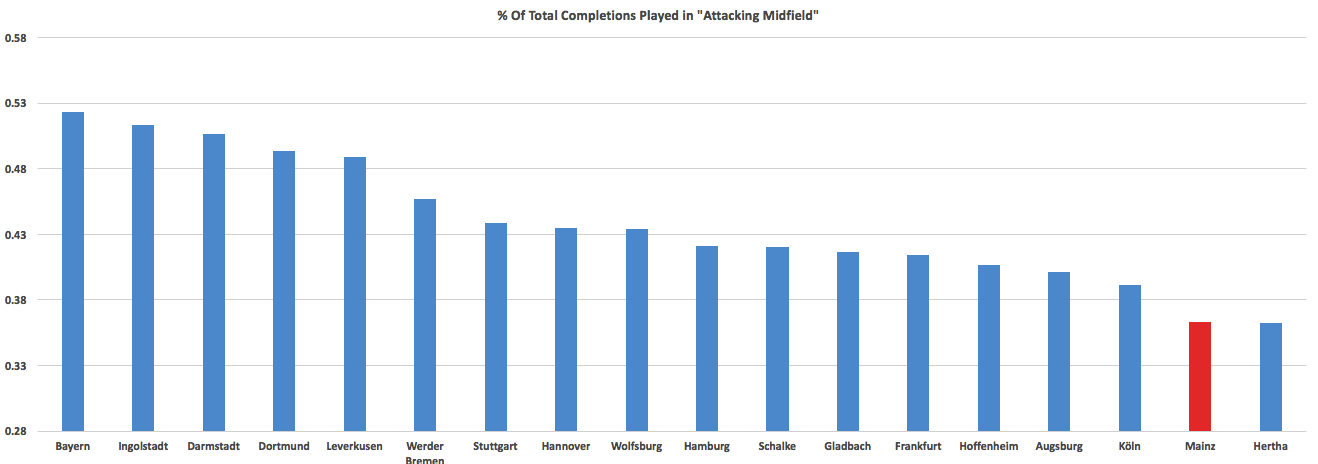 One reason to think this shot distance improvement wasn't a one-year fluke were the pressure numbers. In a 9-game sampling, Mainz shooters had less pressure on them than any other team in the league. Lower pressure=more chance of shot going on target which gives them a good shot at keeping up their good, not amazing SOT% into next year. Defensively the entire plan is set up to force teams wide. No teams opponents played more horizontal balls in their own half and only Hoffenheim forced opponents wide more often when on the attack. I'm always suspicious of a countering team, but Mainz seem like a very smart countering team. With such a mess beyond the top 6, that's probably enough for me to pencil them in at 7th. Good Season: The varied counter attacks continue to let Mainz leap into the danger zone and find one of a number of different players without being overly reliant on one or two men. Mainz handle Europa League with aplomb and separate from the dross below them with another strong 6th-8th finish. I can mentally picture the features on Martin Schmidt, his mechanic past, and whether *that* performance at Wembley will ever be topped after Mainz move into 5th in December. Bad Season: Turns out it wasn't a long-term system but more a confluence of luck that happens to countering teams every once in a while. Mainz fall back toward the 12th range. Hamburg
One reason to think this shot distance improvement wasn't a one-year fluke were the pressure numbers. In a 9-game sampling, Mainz shooters had less pressure on them than any other team in the league. Lower pressure=more chance of shot going on target which gives them a good shot at keeping up their good, not amazing SOT% into next year. Defensively the entire plan is set up to force teams wide. No teams opponents played more horizontal balls in their own half and only Hoffenheim forced opponents wide more often when on the attack. I'm always suspicious of a countering team, but Mainz seem like a very smart countering team. With such a mess beyond the top 6, that's probably enough for me to pencil them in at 7th. Good Season: The varied counter attacks continue to let Mainz leap into the danger zone and find one of a number of different players without being overly reliant on one or two men. Mainz handle Europa League with aplomb and separate from the dross below them with another strong 6th-8th finish. I can mentally picture the features on Martin Schmidt, his mechanic past, and whether *that* performance at Wembley will ever be topped after Mainz move into 5th in December. Bad Season: Turns out it wasn't a long-term system but more a confluence of luck that happens to countering teams every once in a while. Mainz fall back toward the 12th range. Hamburg 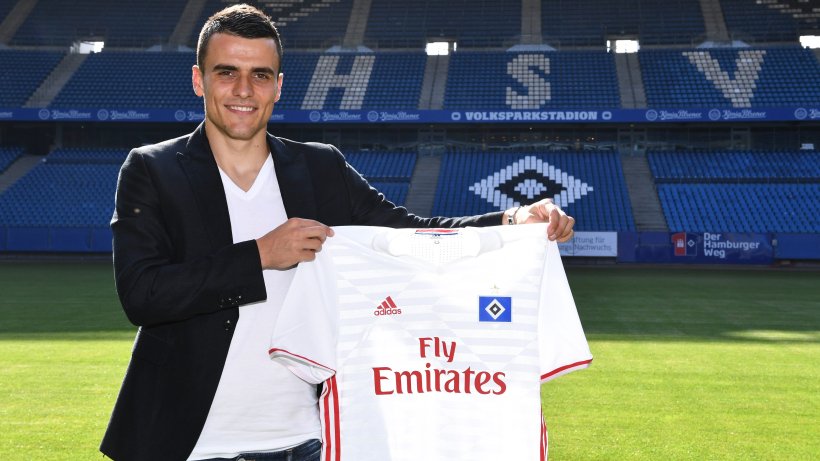 In: Filip Kostic 14m (Stuttgart), Alen Halilovic 5m (Barcelona), Bobby Wood 3.5m (Union Berlin), Luca Waldschmidt 1.3m (Frankfurt), Christian Mathenia 800K (Darmstadt) Out: Kerem Demirbay, Ivo Ilicevic Key Passing Combos: Holtby-Ilicevic Holtby-Lasogga Ostrzolek-Ilicevic The money is flowing this summer in Hamburg. A billionaire supporter has renamed the stadium, pumped in cash through a "loan" and helped give Hamburg the financial muscle to make a trio of exciting summer moves that have given much-needed fresh air to the struggling club. 3 years ago they allowed 75 goals, 2 years ago they scored just 25 and both times they survived a relegation playoff in dramatic fashion. Last years safe mediocrity was a step forward but expectations will and should be much higher than that going forward. One Big Weakness You can see it from the key passing combos list, it was attacking talent. A triangle involving Holtby, Ostrzolek and Ilicevic was by far the most heavily trafficked route to get the ball forward. Holtby was fine enough but Ostrzolek is no attacking fullback and Ilicevic was not a guy who should be playing 1000+ minutes in the Bundesliga, let alone being the focal point of an attack. He was receiving the ball far from goal also (52 yards on average compared to most wingers being around 48), so a player lacking creativity is put further behind the 8-ball by where the ball got to him. Ilicevic has been released and is still a free agent at age 29. The worst thing is he was a better option than other Hamburg attackers like Michael Gregoritsch (can't hold onto the ball, long shot specialist) and Nicolai Müller (minimal production in shots/KPs). The only returning attacker who has a right to demand minutes is Aaron Hunt. Hunt led the team in KP's, got the ball further forward and was head and shoulders above his other attackers in completing his passes. One Big Strength All the new attacking talent has been brought in to fix that. Kostic was out of control last season, every time he got the ball a long pass forward was on the cards. His average pass traveled almost 10 yards forward, basically double that of every other attacking player. He completed 54% of his non-corner passes (still an average of nearly 9 yards forward taking out the corners) which simply won't cut it if you are bringing him in to be a focal point of your attack. He does have raw talent, a corner-inflated 2.7 key passes per game catches the eye, but I don't think this was a wise use of 15 million. I'd rather have him than any of their non-Hunt guys from last year but I can see frustrating times for Hamburg fans watching him.
In: Filip Kostic 14m (Stuttgart), Alen Halilovic 5m (Barcelona), Bobby Wood 3.5m (Union Berlin), Luca Waldschmidt 1.3m (Frankfurt), Christian Mathenia 800K (Darmstadt) Out: Kerem Demirbay, Ivo Ilicevic Key Passing Combos: Holtby-Ilicevic Holtby-Lasogga Ostrzolek-Ilicevic The money is flowing this summer in Hamburg. A billionaire supporter has renamed the stadium, pumped in cash through a "loan" and helped give Hamburg the financial muscle to make a trio of exciting summer moves that have given much-needed fresh air to the struggling club. 3 years ago they allowed 75 goals, 2 years ago they scored just 25 and both times they survived a relegation playoff in dramatic fashion. Last years safe mediocrity was a step forward but expectations will and should be much higher than that going forward. One Big Weakness You can see it from the key passing combos list, it was attacking talent. A triangle involving Holtby, Ostrzolek and Ilicevic was by far the most heavily trafficked route to get the ball forward. Holtby was fine enough but Ostrzolek is no attacking fullback and Ilicevic was not a guy who should be playing 1000+ minutes in the Bundesliga, let alone being the focal point of an attack. He was receiving the ball far from goal also (52 yards on average compared to most wingers being around 48), so a player lacking creativity is put further behind the 8-ball by where the ball got to him. Ilicevic has been released and is still a free agent at age 29. The worst thing is he was a better option than other Hamburg attackers like Michael Gregoritsch (can't hold onto the ball, long shot specialist) and Nicolai Müller (minimal production in shots/KPs). The only returning attacker who has a right to demand minutes is Aaron Hunt. Hunt led the team in KP's, got the ball further forward and was head and shoulders above his other attackers in completing his passes. One Big Strength All the new attacking talent has been brought in to fix that. Kostic was out of control last season, every time he got the ball a long pass forward was on the cards. His average pass traveled almost 10 yards forward, basically double that of every other attacking player. He completed 54% of his non-corner passes (still an average of nearly 9 yards forward taking out the corners) which simply won't cut it if you are bringing him in to be a focal point of your attack. He does have raw talent, a corner-inflated 2.7 key passes per game catches the eye, but I don't think this was a wise use of 15 million. I'd rather have him than any of their non-Hunt guys from last year but I can see frustrating times for Hamburg fans watching him. 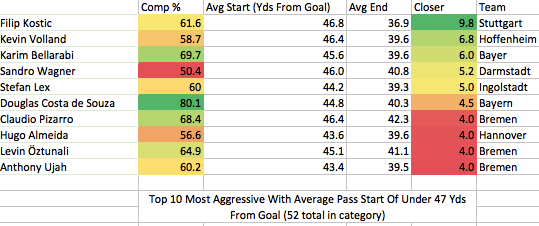 The signing that should have Hamburg fans salivating is Alen Halilovic. Last year at Sporting Gijon he led his team in shots/90 (41% inside the box) and completed 76% of his passes in an advanced role for a team that generally completed about 10% lower than that overall. He didn't light up the key pass leaderboards and was playing out wide right but looks like exactly the kind of player you want to buy and help realize his upside. Good Season: Hamburg becomes a real threat with the ball as Holtby-Halilovic-Hunt combine very well and actually deserve the cheesy Triple H nickname. Maybe Gregoritsch fits in nicely in a side with more attacking talent as a high-volume shooter with the chances they provide. A solid 8th place finish gives hope for the future.
The signing that should have Hamburg fans salivating is Alen Halilovic. Last year at Sporting Gijon he led his team in shots/90 (41% inside the box) and completed 76% of his passes in an advanced role for a team that generally completed about 10% lower than that overall. He didn't light up the key pass leaderboards and was playing out wide right but looks like exactly the kind of player you want to buy and help realize his upside. Good Season: Hamburg becomes a real threat with the ball as Holtby-Halilovic-Hunt combine very well and actually deserve the cheesy Triple H nickname. Maybe Gregoritsch fits in nicely in a side with more attacking talent as a high-volume shooter with the chances they provide. A solid 8th place finish gives hope for the future.  Bad Season: Kostic crossing toward an isolated Lasogga is their main route of attack as Halilovic can't quite physically cope as a #10. All the money doesn't buy love as they muddle their way to a 14th place finish. Hoffenheim
Bad Season: Kostic crossing toward an isolated Lasogga is their main route of attack as Halilovic can't quite physically cope as a #10. All the money doesn't buy love as they muddle their way to a 14th place finish. Hoffenheim 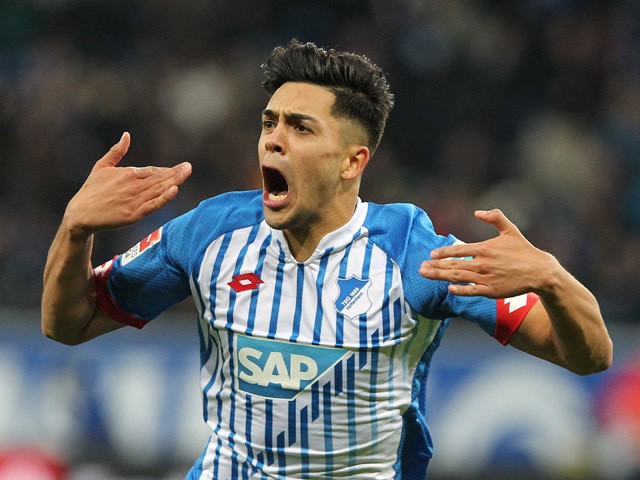
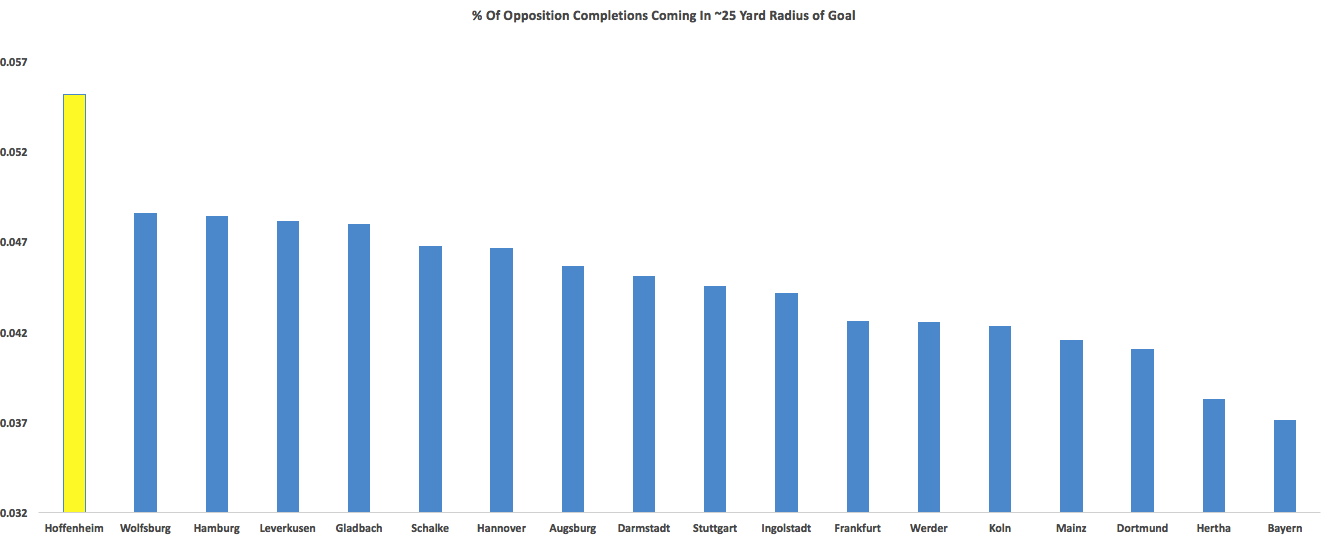 They improved slightly under Nagelsmann (though shots on target allowed actually went up 30% to nearly 7 a game) but it remains a flashing red light screaming danger coming into this season. Hoffenheim's uptick came in attack at the end of the year as post-Nagelsmann they had the 6th most shots on target at 5.3 per game after they were dead last at 3 per game before he took over. This happened by taking their SOT% from last in the league to 3rd despite still taking shots from distance (though from just 9 iron distance as opposed to fairway metal pre-Christmas). The fundamentals suggest another fierce relegation battle and I say we wait and see if Nagelsmann can get this team firing as a mid-table squad then he can get his card to get onto the waiting list for the next Cult of the Manager. Right now, the sample size is just too small. Good Season: Never having to seriously sweat relegation Bad Season: Can't slow anyone down at all, relegated. One to Watch: Sebastian Rudy is probably the best Hoffenheim player right now but might not have it for long if Nadiem Amiri keeps developing. Probably the biggest personnel change Nagelsmann made was giving the 19-year old big run and he looked like Hoffenheim's best player down the stretch. He was -2nd in shots/90 -led the team in key passes/90 -led the team in passes per 90 for attacking players -and led the team incompletion % for attacking players. The most common receiver of his passes was Kevin Volland and you can see from his passing map, that's a pass moving you into dangerous positions (though really it was more sprayed toward both wings than the average indicates). For that to be the most common connection for a 19-year old who is also leading you in activity and completion% is a very promising sign. He's a guy the big boys should be keeping a close watch on.
They improved slightly under Nagelsmann (though shots on target allowed actually went up 30% to nearly 7 a game) but it remains a flashing red light screaming danger coming into this season. Hoffenheim's uptick came in attack at the end of the year as post-Nagelsmann they had the 6th most shots on target at 5.3 per game after they were dead last at 3 per game before he took over. This happened by taking their SOT% from last in the league to 3rd despite still taking shots from distance (though from just 9 iron distance as opposed to fairway metal pre-Christmas). The fundamentals suggest another fierce relegation battle and I say we wait and see if Nagelsmann can get this team firing as a mid-table squad then he can get his card to get onto the waiting list for the next Cult of the Manager. Right now, the sample size is just too small. Good Season: Never having to seriously sweat relegation Bad Season: Can't slow anyone down at all, relegated. One to Watch: Sebastian Rudy is probably the best Hoffenheim player right now but might not have it for long if Nadiem Amiri keeps developing. Probably the biggest personnel change Nagelsmann made was giving the 19-year old big run and he looked like Hoffenheim's best player down the stretch. He was -2nd in shots/90 -led the team in key passes/90 -led the team in passes per 90 for attacking players -and led the team incompletion % for attacking players. The most common receiver of his passes was Kevin Volland and you can see from his passing map, that's a pass moving you into dangerous positions (though really it was more sprayed toward both wings than the average indicates). For that to be the most common connection for a 19-year old who is also leading you in activity and completion% is a very promising sign. He's a guy the big boys should be keeping a close watch on. 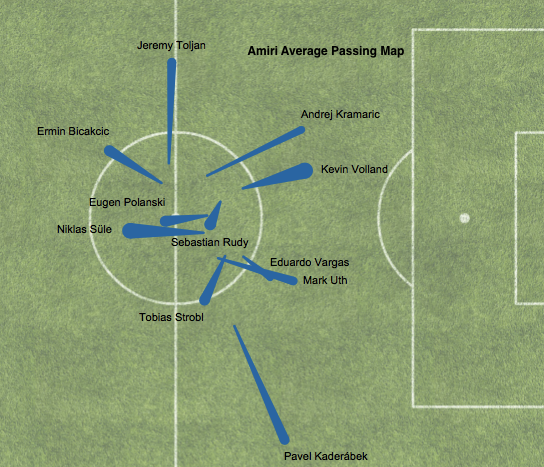
Can Schalke Take Another Step Forward?
The team with the best shorts in the league took a step forward last season after a disastrous 2014-15 campaign where they were outshot by 119. Climbing back to basically par shots and territory wise last year was a stabilizing step good enough for Europa in a league where so much of the positive side of the ledger goes to the top 2. Now they've traded one young big-money prospect in Leroy Sané for another in Breel Embolo and have brought in a new coach to try and push their young team to make the next step.
In: Breel Embolo 22.5m (Basel), Coke 4m (Sevilla), Abdul Rahman Baba 1 year loan (Chelsea), Naldo Free (Wolfsburg)
Out: Leroy Sané, Joel Matip, Roman Neustädter, Pierre-Emile Højbjerg
Shot Map
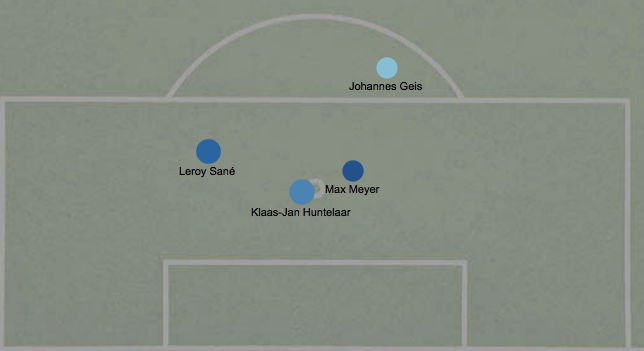
Key Passing Combos
Sané-Meyer
Meyer-Sané
Kolasinac-Choupo-Moting
Long Distance
Johannes Geis might have been a truck driver in another life. Distance is no problem for him and heck a long-haul gives you more time to enjoy the view right? That's how he plays all over the pitch. No one took shots from further out than Geis, who had over half of his shots come from set-pieces:
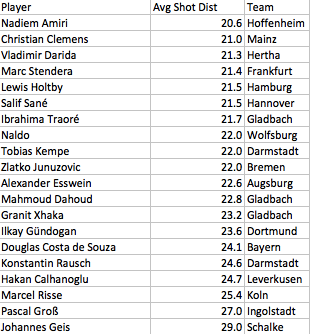
No non-CB or GK played further passes than Geis
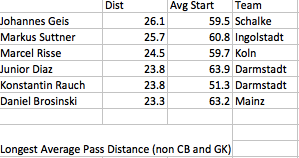
and for good measure he adds being the league leader in share of passes played to the wings, alongside several other Schalke players:

I admit I was fooled a bit last year when I talked about the Geis transfer in glowing terms for Schalke. He's a guy that at first glance has solid raw attacking numbers as a high-volume passer but the deeper you look the more holes you can find. His shots are basically completely useless and the length with which he sweeps balls to the sidelines is not the ideal way to build an attack.
His defense was apparently not elite either. Maybe the most worrying metric is the Schalke team defense map in the center of their half. The green represents the pass rating (basically a rough tool to adjust completion % to account for where a pass starts and ends) and the Excel heat maps are always greener in the Schalke midfield.
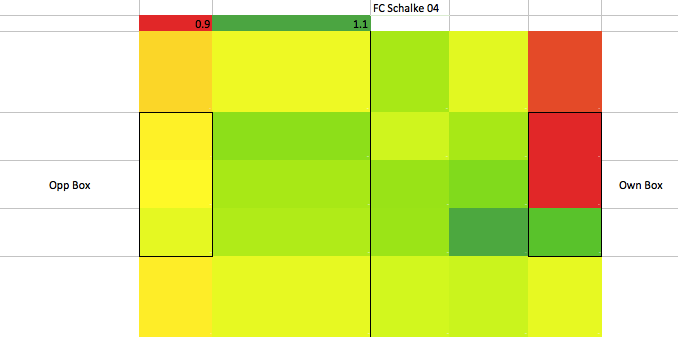
I can't put that all on Geis, but clearly he's not a defensive difference-maker on his own. Geis still is a useful player but would really benefit from a coach showing him these charts and trying to cut back on at least the long sweeping balls to the flanks. Don't have to cut cold turkey, but you don't want to head into your mid-20s as that guy, he's 22 now and it's time to start building better habits.
Max Meyer is another guy where the raw numbers might paint a bit too rosy of a picture. He had a fantastic passing percentage at 85.2% but was much further from goal to start with on average than most attackers and was one of only 9 players whose average pass was played backwards. His key passes also ended with their recipients further from goal than anyone else's.
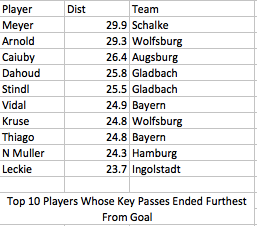
We saw Meyer on the chart above as a guy who loves to spray it to the edges and we also see Leon Goretzka on that list. The entire passing system of those three put together doesn't progress toward goal in many significant directions especially when you consider Sané is gone.
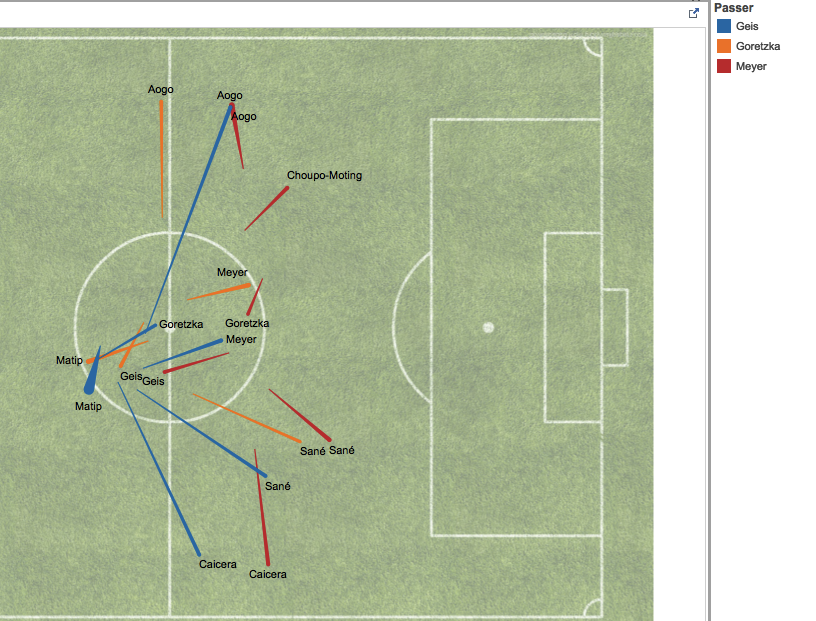
This helps explain why Schalke don't have any reliable attacking combos they could go to around opponents goal to create a shot. In the Gladbach preview we talked about the Stindl-Raffael combo being a reliable, high volume combo in the attacking third that helped the Foals set up shop. Schalke have no such connection, their most common attacking combo is only the leagues 37th most common (Kolasinac-Choupo-Moting). Part of this is explained by fullbacks splitting time. The only other combo in the top 100 was Sané-Meyer and the reverse. With Sané gone Schalke have a pretty big task ahead trying to build an attacking framework. Goretzka improved last year but will need to get the ball further forward this season if Choupo-Moting, Huntelaar and Embolo are going to be able to reliably get the ball in good attacking positions.
A strange thing is how rarely Goretzka and Geis played the ball to each other, each way only about 4 times per game. Both just quickly look wide instead of progressing the ball between themselves.
One Big Strength: The largest video-cube in Europe.
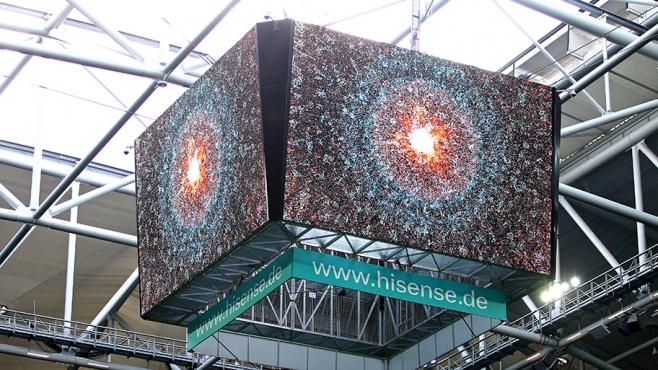
Great sign for the sport teams across Europe begin to catch up to lower-tier SEC football teams in size of video boards. My tip: stop paying transfer fees and player salaries and you can afford bigger video boards and join the big boys.
A real strength is they were pretty devastating when actually reaching the opponents danger zone. The 3rd-shortest danger pass distance went hand-in-hand with the league's 3rd best danger zone completion%.
One Weinzierl Tic to Watch
Markus Weinzierl is Schalke's new manager, hired from Augsburg this summer. He has long been praised by close Bundesliga watchers. Nothing in the stats ever stood out to me, but I concede it's possible he was helping Augsburg (from the "nether regions of the Bundesliga" according to the announcer in Liverpool game) play above a really low talent level. It's also probably more possible that even if he's just an average manager he could be an improvement over Schalke's last few years. The one distinctive tic Augsburg showed last year was how often his fullbacks stayed wide in their lane:

That's something to watch this season. Coke and Abdul Rahman Baba were presumably the two starters this season but with Coke's injury, the right side will need to be patched up for a while. Better right than left as Sascha Riether was Schalke's best fullback last year, even at his ripe old age of 33. Junior Caicara started in the Cup, but I still think he's well behind Trusty Old Sascha.
Eric-Maxim Choupo-Moting, Man With a Plan
He's one of the more prepared players in the league and the way he prepares can be a template for analysts thinking about what information to provide players. He studies a ton of tape on opposition fullbacks to determine which foot they go into tackles with, whether they lay off or approach high up the pitch, how far they will go outside their zones, and if they like to leave the ground to try and win balls or not. For an analyst working with Schalke, he seems like a dream player to work with as you should be able to give him tons of reports/clips that you already know he appreciates. Schalke really need to work out their midfield just to reward Choupo-Moting with more dangerous touches, last year the left side was even tougher to work from than Sané as Choupo-Moting had a couple extra yards to work through when he received the ball. He's a guy to root for for all of us who spend way too much time analyzing this game.
Good Season: Shots, territory, shots on target are no longer flirting with par all season and push well above 0. Stay closer to 3rd than 5th/6th.
Bad Season: Play still stifled far out on the wings too often, they don't develop attacking combos and the lack of speed from Meyer and Geis keep them from going the full-Leicester and becoming a great counter team. Another muddled, mediocre 6th-7th place finish.
A Player-by-Player Breakdown for Dortmund
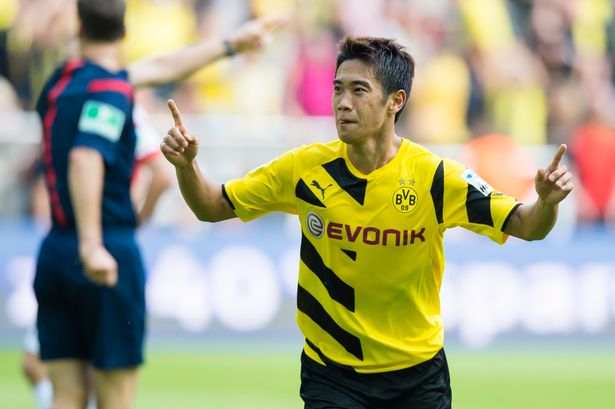 Thomas Tuchel’s first season was an enormous success, he launched the team back into the elite of Europe with style after a disastrous final season under Klopp. With the ball Dortmund were absolutely devastating and very much the equal of Bayern. The one weakness of allowing too many low-pressure, lightly-guarded box shots seemed like something that could be improved upon and a challenge made to Bayern as Pep moved on. Then this summer happened. The Big 3 of Hummels, Mkhitaryan, and Gündogan all left after it was realistic at some point last year to think all three would return. Now Tuchel will be really tested to see if he can rebuild a new team on the fly and keep the team rolling after losing probably their three most influential players who all brought unique skill sets. Shot Map
Thomas Tuchel’s first season was an enormous success, he launched the team back into the elite of Europe with style after a disastrous final season under Klopp. With the ball Dortmund were absolutely devastating and very much the equal of Bayern. The one weakness of allowing too many low-pressure, lightly-guarded box shots seemed like something that could be improved upon and a challenge made to Bayern as Pep moved on. Then this summer happened. The Big 3 of Hummels, Mkhitaryan, and Gündogan all left after it was realistic at some point last year to think all three would return. Now Tuchel will be really tested to see if he can rebuild a new team on the fly and keep the team rolling after losing probably their three most influential players who all brought unique skill sets. Shot Map 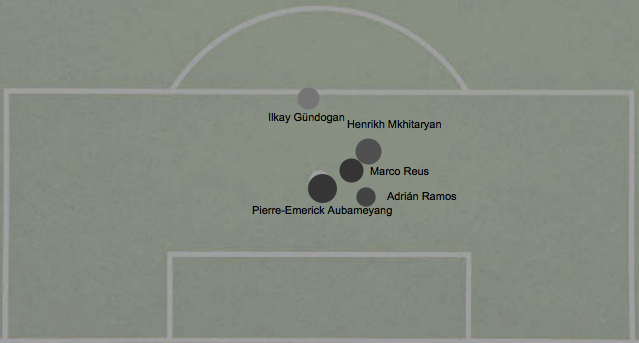 Passing Map
Passing Map 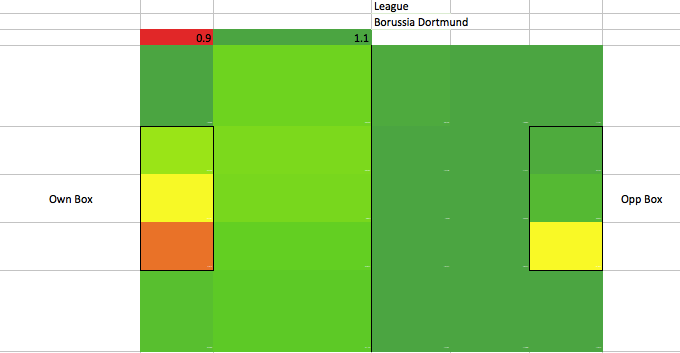 Defense Map
Defense Map 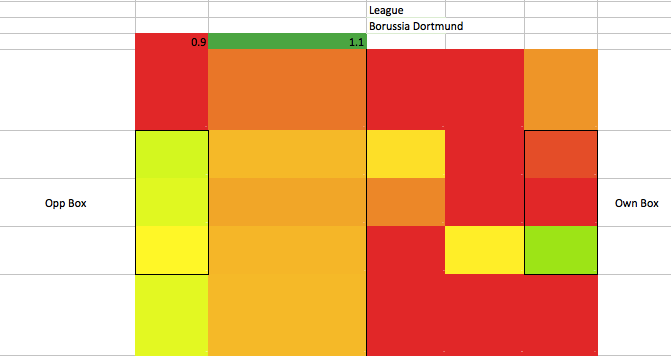 One Big Strength: Generating good shots. Dortmund was not relying on lucky long shots to rack up their league-leading 82 goals, they didn’t have an outside the box goal until well after the winter break. No team took an average shot from closer than Dortmund and only Bayern took more shots total (though they did take nearly 3 more shots per game). Just look at their strikers shot chart (Auba=orange, Ramos=blue) to see how shocking it was to see them range outside the box to launch.
One Big Strength: Generating good shots. Dortmund was not relying on lucky long shots to rack up their league-leading 82 goals, they didn’t have an outside the box goal until well after the winter break. No team took an average shot from closer than Dortmund and only Bayern took more shots total (though they did take nearly 3 more shots per game). Just look at their strikers shot chart (Auba=orange, Ramos=blue) to see how shocking it was to see them range outside the box to launch. 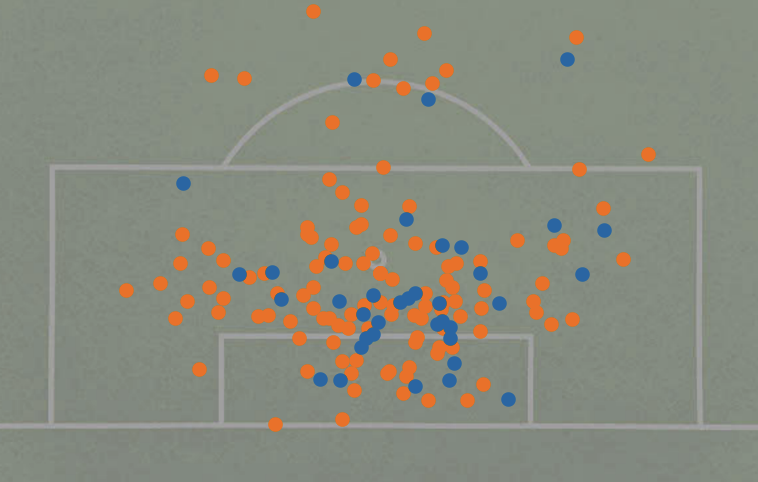 One Big Weakness: Opponents rarely got the ball deep vs Dortmund but when they did it was painful. It took opponents a league-high 30 completions on average to get a shot off against Dortmund but they allowed a shot closer than the league average. More worrying, in a 9-game sampling of shots last season, they had fewer defenders in the box for opponents shots than any other team. This makes sense season-long visually as well. Only Frankfurt applied less pressure on opposition shooters. This helps to explain how Dortmund could be the best team in Germany in Michael Caley’s xG model but really were not as close to reaching Bayern as the pure shot location data indicated. When they gave up a shot it was not pressured adequately, which led to over 40% of shots going on target, down with the worst defenses in the league like Stuttgart and Hannover. Mats Hummels was great, but it’s not a huge stretch to imagine replacing him might help this aspect of the defense.
One Big Weakness: Opponents rarely got the ball deep vs Dortmund but when they did it was painful. It took opponents a league-high 30 completions on average to get a shot off against Dortmund but they allowed a shot closer than the league average. More worrying, in a 9-game sampling of shots last season, they had fewer defenders in the box for opponents shots than any other team. This makes sense season-long visually as well. Only Frankfurt applied less pressure on opposition shooters. This helps to explain how Dortmund could be the best team in Germany in Michael Caley’s xG model but really were not as close to reaching Bayern as the pure shot location data indicated. When they gave up a shot it was not pressured adequately, which led to over 40% of shots going on target, down with the worst defenses in the league like Stuttgart and Hannover. Mats Hummels was great, but it’s not a huge stretch to imagine replacing him might help this aspect of the defense. 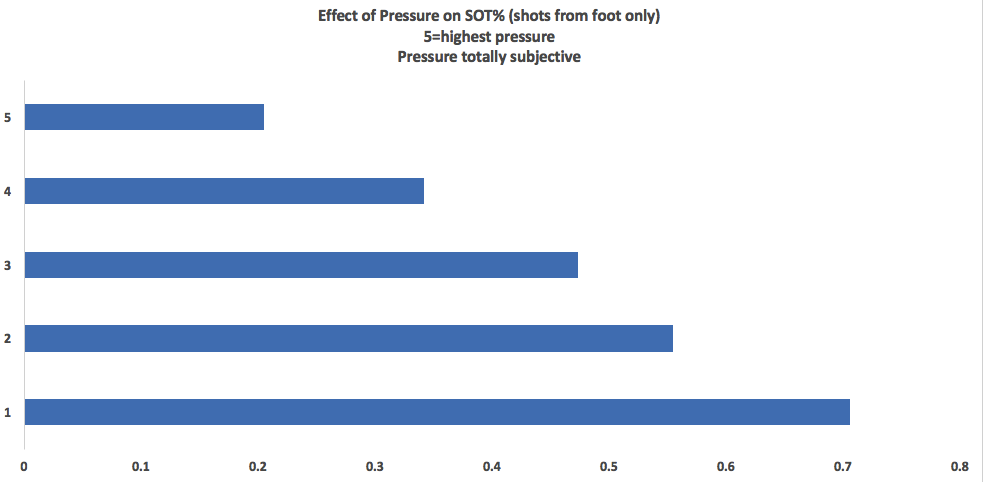 Transfers In: André Schürrle 30m (Wolfsburg), Mario Götze 26m (Bayern), Ousmane Dembelé 15m (Rennes), Sebastian Rode 12m (Bayern), Raphaël Guerreiro 12m (Lorient), Marc Bartra 8m (Barcelona), Emre Mor 7m (Nordsjaelland), Mikel Moreno 3.75m (Osasuna) Out: Henrikh Mkhitaryan, Mats Hummels, Ilkay Gündogan Easier Than Expected To Replace Mkhi? I don't quite understand why but Mkhitaryan does not rate well in my passing metric but he never stood out. It doesn't make sense to my eyes that watched him play but no other Dortmund player bar Pulisic in a similar advanced position had as low of a rating (it just factors in starting and ending position). Breaking down Mkhitaryan vs Reus on similar passes, Reus actually had a pretty significant edge.
Transfers In: André Schürrle 30m (Wolfsburg), Mario Götze 26m (Bayern), Ousmane Dembelé 15m (Rennes), Sebastian Rode 12m (Bayern), Raphaël Guerreiro 12m (Lorient), Marc Bartra 8m (Barcelona), Emre Mor 7m (Nordsjaelland), Mikel Moreno 3.75m (Osasuna) Out: Henrikh Mkhitaryan, Mats Hummels, Ilkay Gündogan Easier Than Expected To Replace Mkhi? I don't quite understand why but Mkhitaryan does not rate well in my passing metric but he never stood out. It doesn't make sense to my eyes that watched him play but no other Dortmund player bar Pulisic in a similar advanced position had as low of a rating (it just factors in starting and ending position). Breaking down Mkhitaryan vs Reus on similar passes, Reus actually had a pretty significant edge. 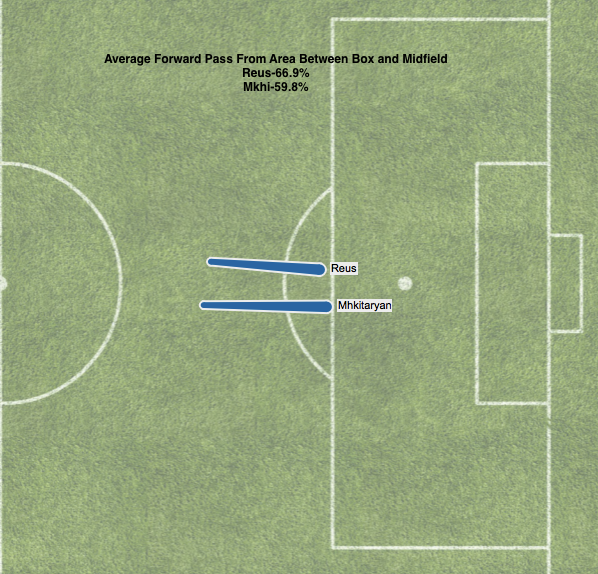 I think Mkhi (if you caught the misspelling before now you get a congrats) is still a big loss but the more I look into his passing breakdown, the less I think it will be a devastating blow. I expect his loss will hurt less than most think, Gündogan's more and Hummels, as always, it's very hard to tell. Players, In Vague Order Of Importance Pierre-Emerick Aubameyang-About as pure of a finisher of open-play moves as you find this side of Lewandowski. He plays under 20 passes per 90 but still gets 4.3 shots per 90 with nearly all coming inside the box. When Mkhitaryan, Castro or Reus found him in open play, the odds were pretty good it was going to end in a chance. 27% of the time any of those three completed a pass to Auba, he got a shot (47 total). No other passing combo that was primarily through open play came close to that number. Map of all 3 passers to Auba below:
I think Mkhi (if you caught the misspelling before now you get a congrats) is still a big loss but the more I look into his passing breakdown, the less I think it will be a devastating blow. I expect his loss will hurt less than most think, Gündogan's more and Hummels, as always, it's very hard to tell. Players, In Vague Order Of Importance Pierre-Emerick Aubameyang-About as pure of a finisher of open-play moves as you find this side of Lewandowski. He plays under 20 passes per 90 but still gets 4.3 shots per 90 with nearly all coming inside the box. When Mkhitaryan, Castro or Reus found him in open play, the odds were pretty good it was going to end in a chance. 27% of the time any of those three completed a pass to Auba, he got a shot (47 total). No other passing combo that was primarily through open play came close to that number. Map of all 3 passers to Auba below: 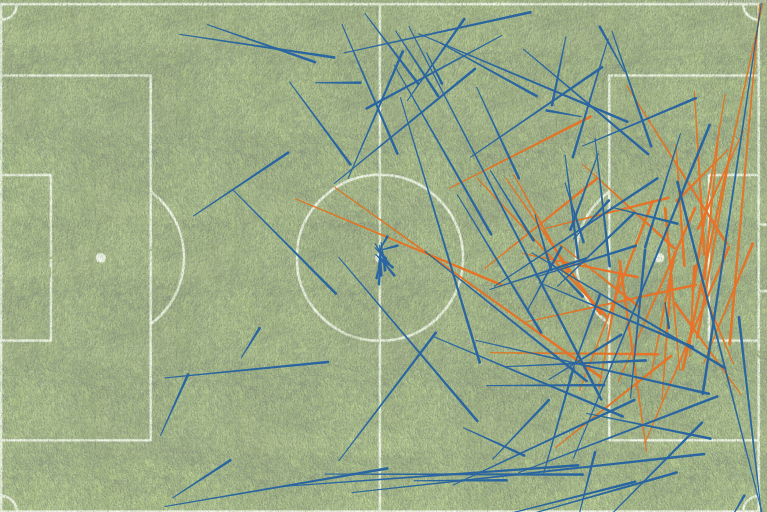 Have someone else take kickoffs and the rate jumps even higher. Marco Reus-His counting stats have been trending down for two years now (shots from 4.5 to 2.9 KP’s from 3.6 to 2.1) and at times he looked a little bit out of place in the more controlled Tuchel system instead of the free-flowing Klopp attack but Reus still has the ability to be a difference maker. It will be interesting to he picks up some of the Mkhitaryan slack or Götze just slides into that role when all are healthy. Julian Weigl-The league leader in passes played doesn’t do too many different things yet but at 20 years old there’s very few who can sit in the middle of the pitch and recycle the ball like he does. In fact no player in the league played more of their passes from the center of the pitch than Weigl did.
Have someone else take kickoffs and the rate jumps even higher. Marco Reus-His counting stats have been trending down for two years now (shots from 4.5 to 2.9 KP’s from 3.6 to 2.1) and at times he looked a little bit out of place in the more controlled Tuchel system instead of the free-flowing Klopp attack but Reus still has the ability to be a difference maker. It will be interesting to he picks up some of the Mkhitaryan slack or Götze just slides into that role when all are healthy. Julian Weigl-The league leader in passes played doesn’t do too many different things yet but at 20 years old there’s very few who can sit in the middle of the pitch and recycle the ball like he does. In fact no player in the league played more of their passes from the center of the pitch than Weigl did.  Shinji Kagawa-Kagawa’s passing percentage spiked toward his Manchester United/Japan numbers in Tuchel’s system after last years near career-low of 81.8%. His sheer volume spiked as well, playing 35% more passes per 90 year-on-year. He loved Klopp but I think Tuchel’s system fits Kagawa better. With all the exciting new talent flowing in this season it can be easy to overlook Kagawa, but he remains a fantastic talent with the ball in the middle of the pitch. Mario Götze-Before last season I had zero doubts about Götze being one of the best players in the world and an absolute luxury for Bayern to be able to put on the bench. Last year gave me some doubts. He had a career low in KP’s, his fewest shots in 5 years, his passing ticked down, he didn’t crack 1000 league minutes and most worryingly looked pudgy and slow way too often. It’s always tempting to put more stock in a statistical rise or dip when there’s a convincing story behind it and Götze pounding pretzels is pretty convincing to me. The ceiling here is still enormous (as in slide into Mkhitaryan’s role and be an improvement) but it’s not clear to me anymore he’s automatically deserving over Kagawa or Castro in an advanced role. Every move he makes will be scrutinized heavily until the old Götze breaks through and it's likely the #1 question that determines whether Dortmund will have a significant step back.
Shinji Kagawa-Kagawa’s passing percentage spiked toward his Manchester United/Japan numbers in Tuchel’s system after last years near career-low of 81.8%. His sheer volume spiked as well, playing 35% more passes per 90 year-on-year. He loved Klopp but I think Tuchel’s system fits Kagawa better. With all the exciting new talent flowing in this season it can be easy to overlook Kagawa, but he remains a fantastic talent with the ball in the middle of the pitch. Mario Götze-Before last season I had zero doubts about Götze being one of the best players in the world and an absolute luxury for Bayern to be able to put on the bench. Last year gave me some doubts. He had a career low in KP’s, his fewest shots in 5 years, his passing ticked down, he didn’t crack 1000 league minutes and most worryingly looked pudgy and slow way too often. It’s always tempting to put more stock in a statistical rise or dip when there’s a convincing story behind it and Götze pounding pretzels is pretty convincing to me. The ceiling here is still enormous (as in slide into Mkhitaryan’s role and be an improvement) but it’s not clear to me anymore he’s automatically deserving over Kagawa or Castro in an advanced role. Every move he makes will be scrutinized heavily until the old Götze breaks through and it's likely the #1 question that determines whether Dortmund will have a significant step back. 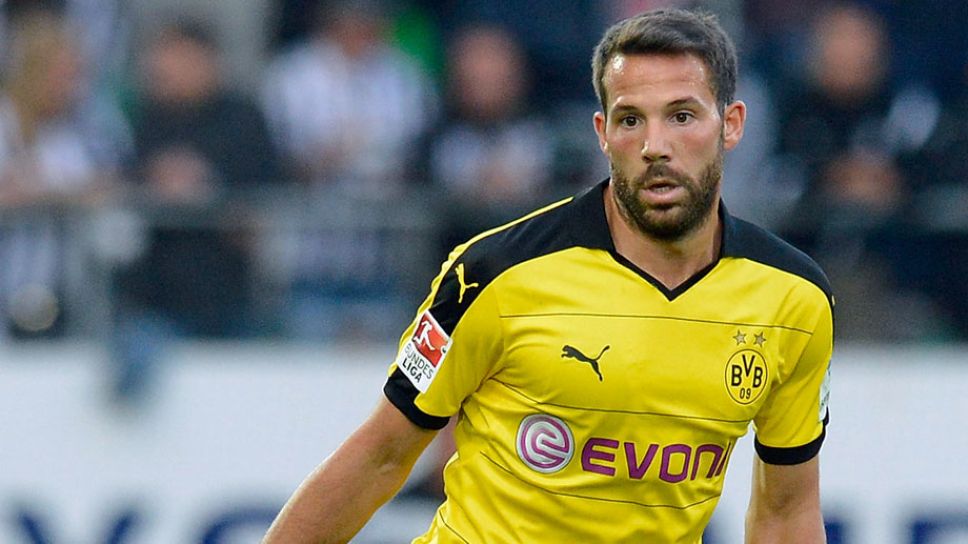 Gonzalo Castro-A similar player to Kagawa positionally and with regards to where they move the ball to and while he might be a tick behind Shinji with the ball, he offers a bit more oomph without it. Leverkusen really miss him. André Schürrle-Don’t understand this buy at all. He’s basically a striker who loves to run but there’s already a better one up top for Dortmund. He’s not a great passer and never sets anyone else up. He does get great shot volume repeatedly (over 3 per 90 every year since 2011) in good positions but that doesn’t match the price tag for me. Really one of the strangest moves of the summer, I still trust Tuchel but his plans for Schürrle are not that easy to discern as playing him almost seems like they would be moving toward a 2-striker system, as that is how he functions.
Gonzalo Castro-A similar player to Kagawa positionally and with regards to where they move the ball to and while he might be a tick behind Shinji with the ball, he offers a bit more oomph without it. Leverkusen really miss him. André Schürrle-Don’t understand this buy at all. He’s basically a striker who loves to run but there’s already a better one up top for Dortmund. He’s not a great passer and never sets anyone else up. He does get great shot volume repeatedly (over 3 per 90 every year since 2011) in good positions but that doesn’t match the price tag for me. Really one of the strangest moves of the summer, I still trust Tuchel but his plans for Schürrle are not that easy to discern as playing him almost seems like they would be moving toward a 2-striker system, as that is how he functions. 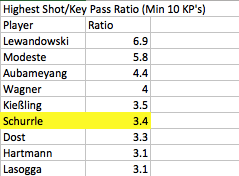 Nuri Sahin-With the emergence of Weigl it’s hard to see a significant spot for Sahin. He’s probably not dynamic enough to play alongside Weigl like Gündogan was and he’s not good enough to force Weigl to the bench. Still seems a good player but a move downwards might be the best thing for his career if he wants a starting spot. He does look healthier this season than last however. Adrian Ramos-Nothing looked easy or clean when Ramos was on the pitch, in fact at times he didn’t look up to Dortmund’s standards. His passing was really poor and he looked uncomfortable a lot. Which in no way at all squares up with his 3.2 shots in box per 90 along with 9 goals and 4 assists in 930 minutes. Astounding productivity but one that is not indicative of suddenly emerging as an elite European striker at age 30. If you haven’t made it by 30, you probably never will. A hopeful message for all those reading this with that truly human deep feeling of dissatisfaction with their lives. Sebastian Rode-In limited minutes last season he was extremely conservative at Bayern, passing the ball backwards more than anyone else that wasn't a striker. Maybe this was some sort of tactical related instruction, but this alongside his passing numbers lagging his Bayern teammates make me think he's not the best option alongside Weigl in the midfield. However if you rule out Rode for being too conservative and rule out Sahin for being too similar, Castro or Kagawa being moved a bit back seems the only man left. Why I said Gündogan will be an even bigger loss than expected.
Nuri Sahin-With the emergence of Weigl it’s hard to see a significant spot for Sahin. He’s probably not dynamic enough to play alongside Weigl like Gündogan was and he’s not good enough to force Weigl to the bench. Still seems a good player but a move downwards might be the best thing for his career if he wants a starting spot. He does look healthier this season than last however. Adrian Ramos-Nothing looked easy or clean when Ramos was on the pitch, in fact at times he didn’t look up to Dortmund’s standards. His passing was really poor and he looked uncomfortable a lot. Which in no way at all squares up with his 3.2 shots in box per 90 along with 9 goals and 4 assists in 930 minutes. Astounding productivity but one that is not indicative of suddenly emerging as an elite European striker at age 30. If you haven’t made it by 30, you probably never will. A hopeful message for all those reading this with that truly human deep feeling of dissatisfaction with their lives. Sebastian Rode-In limited minutes last season he was extremely conservative at Bayern, passing the ball backwards more than anyone else that wasn't a striker. Maybe this was some sort of tactical related instruction, but this alongside his passing numbers lagging his Bayern teammates make me think he's not the best option alongside Weigl in the midfield. However if you rule out Rode for being too conservative and rule out Sahin for being too similar, Castro or Kagawa being moved a bit back seems the only man left. Why I said Gündogan will be an even bigger loss than expected. 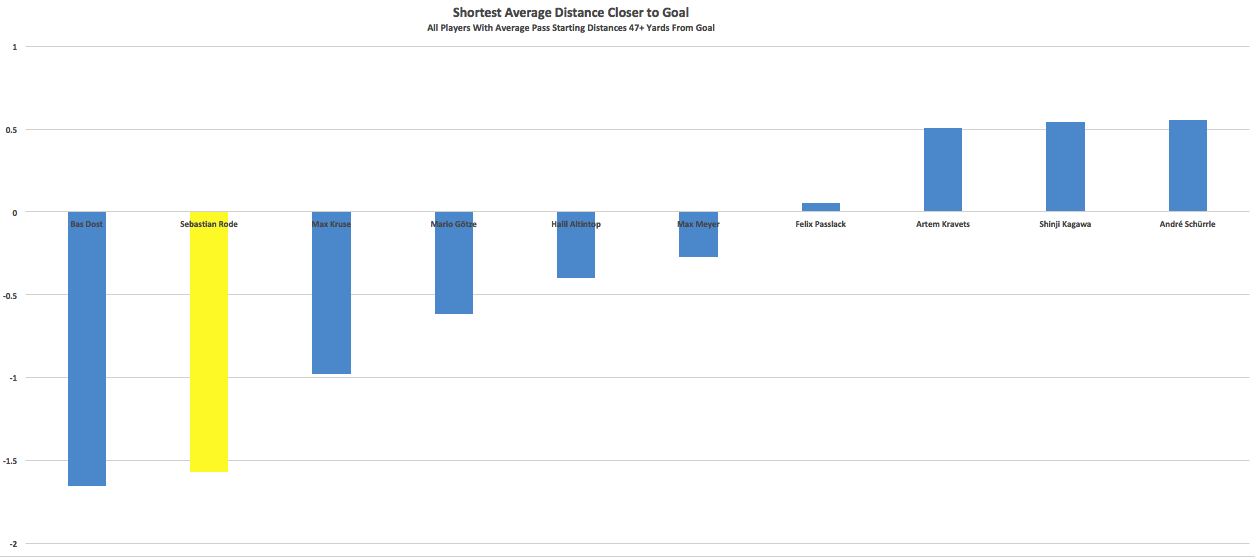 Fullback Talk
Fullback Talk 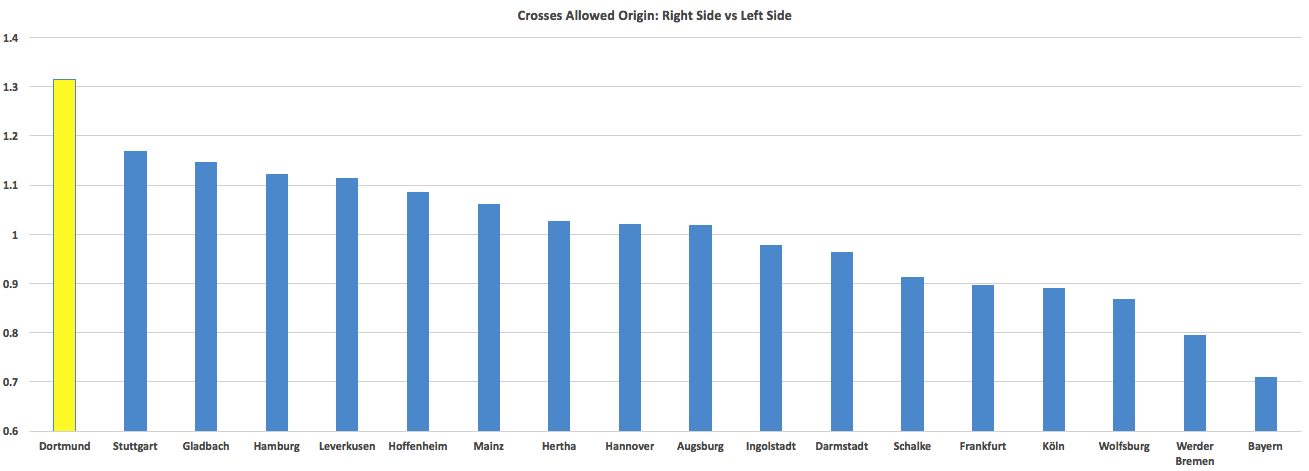 Erik Durm is battling an injury but is the returnee most likely to not see much playing time, even if healthy. Piszczek and Ginter were almost impossible to tell apart on the right side, which was the weaker side defensively as can be seen by where crosses came from. Piszczek’s effort in the summer for Poland was quite inconsistent, he can’t afford that in the fall or Felix Passlack might slide right in. Passlack might soon pass Christian Pulisic as the kid to get most excited about (non-American edition) if he keeps playing like he did in spurts last year and in the Super Cup. As for Pulisic, he's not quite ready to be a big-minute guy for Dortmund, but will anyone really care as long as he terrorizes Panama in the Hex? On the left Schmelzer was great last season but Guerreiro brings a new look. In my Ligue 1 preview last season he was the best FB going forward and he had another strong season, getting forward for a crazy-high 1.4 shots per 90. It remains to be seen if he’s a left-back in name only or if he can actually combine shooting a lot without leaving an empty space in behind. When trying to prevent low-pressure breakaway shots, Guerreiro at left back is a risk I don't expect Tuchel to take early on. Bartra is presumably in to try and recreate Hummels magic with the ball. How the backline looks without Hummels will be fascinating. I can never get a good read on how good he really was and wavered from one of the best in the world to maybe just an above-average Bundesliga CB depending on the phase of the moon. Good Season: Neck-and-neck for the title, lead for chunks of the year. Average Season: Comfortable 2nd that signify losing the big 3 will not be a huge blow. Bad Season: Rely on Schurrle to run behind defenses a lot, Gotze isn't back to form, can't keep teams from getting low-pressure shots, finish behind Leverkusen.
Erik Durm is battling an injury but is the returnee most likely to not see much playing time, even if healthy. Piszczek and Ginter were almost impossible to tell apart on the right side, which was the weaker side defensively as can be seen by where crosses came from. Piszczek’s effort in the summer for Poland was quite inconsistent, he can’t afford that in the fall or Felix Passlack might slide right in. Passlack might soon pass Christian Pulisic as the kid to get most excited about (non-American edition) if he keeps playing like he did in spurts last year and in the Super Cup. As for Pulisic, he's not quite ready to be a big-minute guy for Dortmund, but will anyone really care as long as he terrorizes Panama in the Hex? On the left Schmelzer was great last season but Guerreiro brings a new look. In my Ligue 1 preview last season he was the best FB going forward and he had another strong season, getting forward for a crazy-high 1.4 shots per 90. It remains to be seen if he’s a left-back in name only or if he can actually combine shooting a lot without leaving an empty space in behind. When trying to prevent low-pressure breakaway shots, Guerreiro at left back is a risk I don't expect Tuchel to take early on. Bartra is presumably in to try and recreate Hummels magic with the ball. How the backline looks without Hummels will be fascinating. I can never get a good read on how good he really was and wavered from one of the best in the world to maybe just an above-average Bundesliga CB depending on the phase of the moon. Good Season: Neck-and-neck for the title, lead for chunks of the year. Average Season: Comfortable 2nd that signify losing the big 3 will not be a huge blow. Bad Season: Rely on Schurrle to run behind defenses a lot, Gotze isn't back to form, can't keep teams from getting low-pressure shots, finish behind Leverkusen.
Tortoise and the Hare: Hertha and Werder Bremen
Hertha Berlin 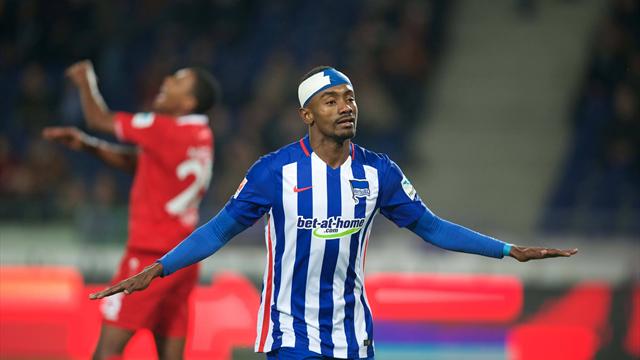 In: Ondrej Duda 4.2m (Legia Warsaw) Out: Tolga Cigerci Key Passing Combos Plattenhardt-Kalou and Ibisevic Weiser-Darida One Weakness: Playmaking from midfield. Hertha were the one of the most dull teams to watch in the Bundesliga if you like either high scoring or high tempo soccer. They were very interesting on paper thanks to a very unique style which resulted in safety but not any excitement on the pitch to most neutrals. However, if everyone tried to play like Leverkusen it would no longer be interesting and Hertha provide a nice change of pace keeping the Bundesliga from becoming too frazzled. Variety is the spice of life, and Hertha are the vanilla needed to make the others of the Bundesliga pop out. With the ball they functioned essentially completed without a playmaking attacker, supplying their forward pair of Kalou and Ibisevic mostly through long balls and from the wings. Kalou received the most passes by far from left back Marvin Plattenhardt while Ibisevic received his most passes from the goalie Rune Jarstein and then Plattenhardt. The one player most looked like a central playmaker would be Genki Haraguchi, but just look at his pass map toward the two forwards to see how that doesn't explain his game:
In: Ondrej Duda 4.2m (Legia Warsaw) Out: Tolga Cigerci Key Passing Combos Plattenhardt-Kalou and Ibisevic Weiser-Darida One Weakness: Playmaking from midfield. Hertha were the one of the most dull teams to watch in the Bundesliga if you like either high scoring or high tempo soccer. They were very interesting on paper thanks to a very unique style which resulted in safety but not any excitement on the pitch to most neutrals. However, if everyone tried to play like Leverkusen it would no longer be interesting and Hertha provide a nice change of pace keeping the Bundesliga from becoming too frazzled. Variety is the spice of life, and Hertha are the vanilla needed to make the others of the Bundesliga pop out. With the ball they functioned essentially completed without a playmaking attacker, supplying their forward pair of Kalou and Ibisevic mostly through long balls and from the wings. Kalou received the most passes by far from left back Marvin Plattenhardt while Ibisevic received his most passes from the goalie Rune Jarstein and then Plattenhardt. The one player most looked like a central playmaker would be Genki Haraguchi, but just look at his pass map toward the two forwards to see how that doesn't explain his game: 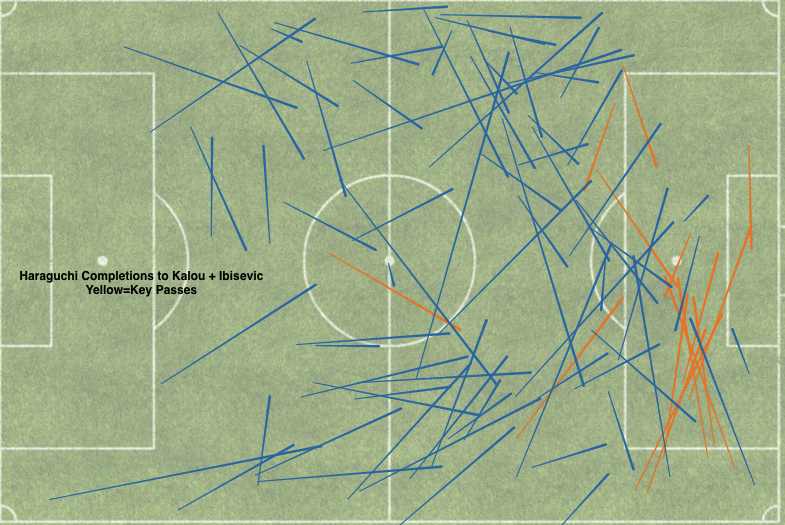 When all three players were over 2000 minutes that's quite a thin looking map for your "playmaker" to two shooting options. The thing is, Haraguchi was the leading provider of key passes to those two with his 15 (just 1 per 90 total for Haraguchi). However they found their two forwards, it worked well enough for both to be in the top 20 players for shortest average shot at 12.6 yards for Ibisevic and 14.8 for Kalou. Hertha weren't a sit and counter team, they had 50% possession it's just where that possession was that leads to their interesting One Big Strength
When all three players were over 2000 minutes that's quite a thin looking map for your "playmaker" to two shooting options. The thing is, Haraguchi was the leading provider of key passes to those two with his 15 (just 1 per 90 total for Haraguchi). However they found their two forwards, it worked well enough for both to be in the top 20 players for shortest average shot at 12.6 yards for Ibisevic and 14.8 for Kalou. Hertha weren't a sit and counter team, they had 50% possession it's just where that possession was that leads to their interesting One Big Strength 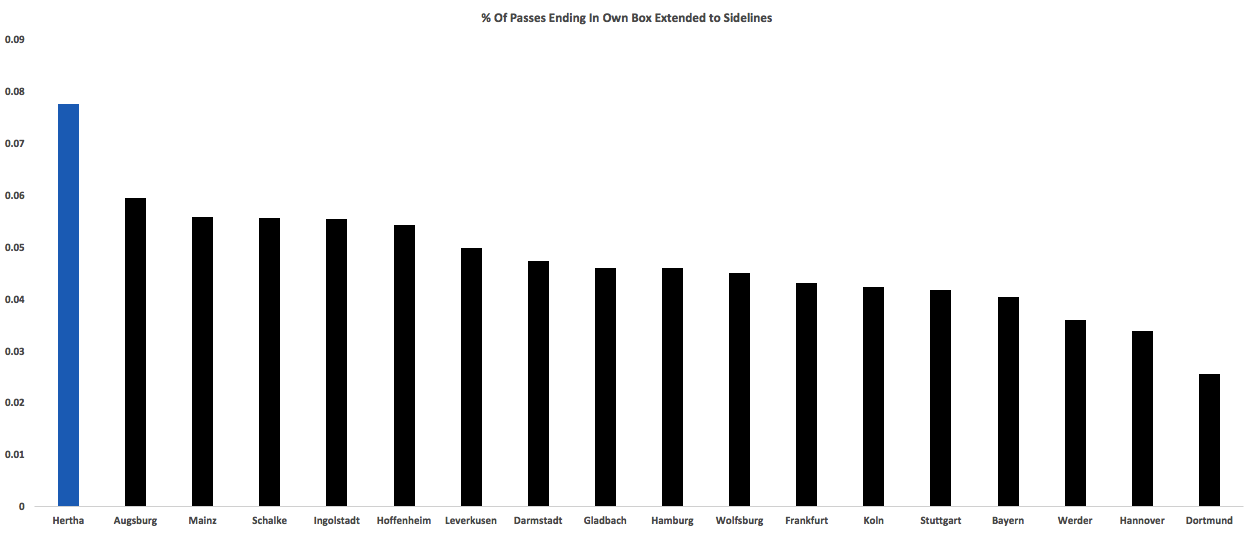 Hertha having the highest ratio of passes to shots is a feature, not a bug, as young coach Pál Dárdai has his center backs play extremely conservatively, with three in the top five at passing the ball backwards.
Hertha having the highest ratio of passes to shots is a feature, not a bug, as young coach Pál Dárdai has his center backs play extremely conservatively, with three in the top five at passing the ball backwards. 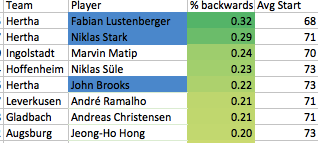 Slowing the game down to Pirlo in MLS speed through defensive possession kept opponents from having huge chunks of the ball. Couple that with a defensive block that forced opponents wide and you get a respectable, low-goals allowed showing. Hertha were challenging for Champions League for much of the season, but a team with the 2nd-fewest dangerous completions and fewest shots will never perform at a Champions League level. Dárdai has his team playing quality defensive possession which is probably enough to avoid a relegation scrap this season. To emphasize these points, a scene from Hertha v Mainz set to music to show all the traits mentioned. Snails pace, no central playmakers, center backs split wide, constant passing back to the keeper, and a dreariness that seemingly seeps into the legs of every player on the pitch. Hertha unsurprisingly had the lowest proportion of completions coming inside the opposition extended box area. How you know the defensive possession worked? Their opponents were last in the same category. So if you really want to see a game where neither team gets the ball close to the opposition goal, this is your team. Best at both ends. Good Season: Add even more possession, and get the shots number into reasonable territory. Sniffing Europa League places would be an accomplishment. Bad Season: The dullness continues but the shots don't go in and they get fewer early leads. Not a team built to come from behind at all, Hertha flail to relegation. Werder Bremen In: Max Kruse 7.5m (Wolfsburg), Florian Kainz 3.5m (Rapid Vienna), Thomas Delaney 2m (Copenhagen), Niklas Moisander 1.8m (Sampdoria), Fallou Diagne 1.5m (Rennes), Lamine Sané Free (Bordeaux), Thanos Petsos Free (Rapid Vienna) Out: Jannik Vestergaard, Anthony Ujah, Papy Djilobodji, Levin Öztunali
Slowing the game down to Pirlo in MLS speed through defensive possession kept opponents from having huge chunks of the ball. Couple that with a defensive block that forced opponents wide and you get a respectable, low-goals allowed showing. Hertha were challenging for Champions League for much of the season, but a team with the 2nd-fewest dangerous completions and fewest shots will never perform at a Champions League level. Dárdai has his team playing quality defensive possession which is probably enough to avoid a relegation scrap this season. To emphasize these points, a scene from Hertha v Mainz set to music to show all the traits mentioned. Snails pace, no central playmakers, center backs split wide, constant passing back to the keeper, and a dreariness that seemingly seeps into the legs of every player on the pitch. Hertha unsurprisingly had the lowest proportion of completions coming inside the opposition extended box area. How you know the defensive possession worked? Their opponents were last in the same category. So if you really want to see a game where neither team gets the ball close to the opposition goal, this is your team. Best at both ends. Good Season: Add even more possession, and get the shots number into reasonable territory. Sniffing Europa League places would be an accomplishment. Bad Season: The dullness continues but the shots don't go in and they get fewer early leads. Not a team built to come from behind at all, Hertha flail to relegation. Werder Bremen In: Max Kruse 7.5m (Wolfsburg), Florian Kainz 3.5m (Rapid Vienna), Thomas Delaney 2m (Copenhagen), Niklas Moisander 1.8m (Sampdoria), Fallou Diagne 1.5m (Rennes), Lamine Sané Free (Bordeaux), Thanos Petsos Free (Rapid Vienna) Out: Jannik Vestergaard, Anthony Ujah, Papy Djilobodji, Levin Öztunali 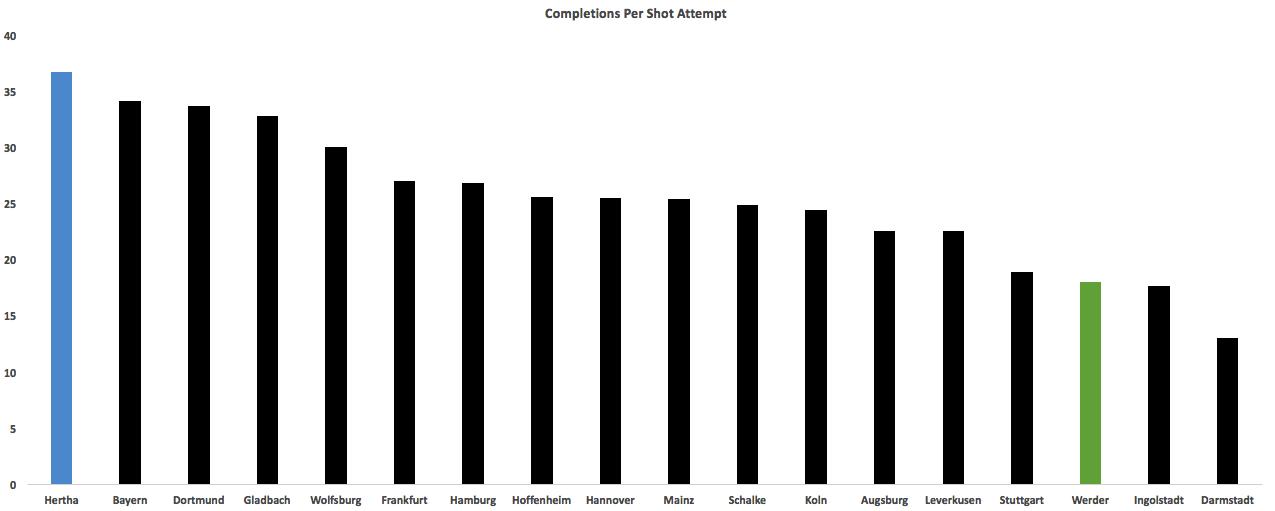 This is where the hare comes in. Werder takes a shot every 18 completions, half the rate of Hertha, and the lowest rate among teams who tried to do anything with the ball other than hoist it forward (with one Groß exception). They escaped relegation late in the year but I think the table belied a performance that deserved much better. Just look at how they fared looking at dangerous territory for/against, one of very few teams to be comfortably in the positives and only behind the Big 3.
This is where the hare comes in. Werder takes a shot every 18 completions, half the rate of Hertha, and the lowest rate among teams who tried to do anything with the ball other than hoist it forward (with one Groß exception). They escaped relegation late in the year but I think the table belied a performance that deserved much better. Just look at how they fared looking at dangerous territory for/against, one of very few teams to be comfortably in the positives and only behind the Big 3.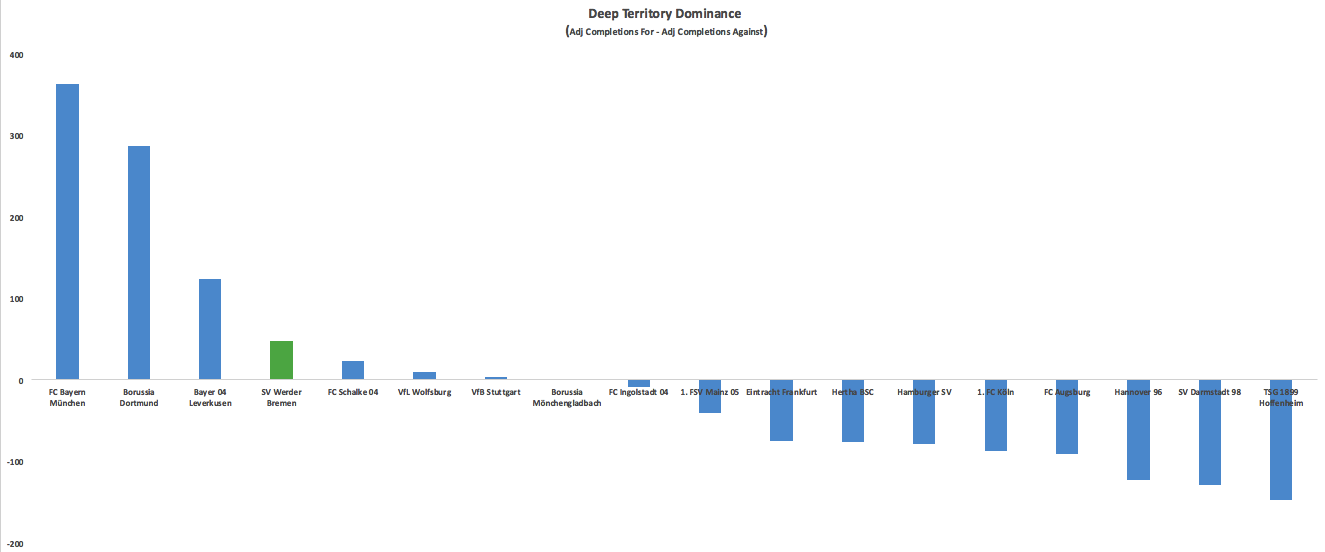 Werder with the ball were basically a swirl of Darmstadt and Leverkusen. They built up chaotically at times but completed a higher rate of dangerous passes than Darmstadt which helped avoid the problem of near-overwhelming pressure on their open-play shooters. They couldn't get as many men into the box as Leverkusen so wound up having a significantly higher % of shots blocked which contributed to the really low shots on target ratio. Putting it all together, their rambunctious attack without established passing connections doesn't really signify a master plan from coach Victor Skripnik but worked well enough to put up 50 goals without crazy conversion rates. It was the defense that conceded 65 goals and had them teetering on edge of relegation and it's the defense that is the big question this season. One Big Weakness? Both starting center backs are gone in Papy Djilobodji and Jannik Vestergaard and while the new guys come with big minutes in France and Italy last year, it is a worry. The reason for the question mark is last years huge goals allowed total looks a lot like awful luck.
Werder with the ball were basically a swirl of Darmstadt and Leverkusen. They built up chaotically at times but completed a higher rate of dangerous passes than Darmstadt which helped avoid the problem of near-overwhelming pressure on their open-play shooters. They couldn't get as many men into the box as Leverkusen so wound up having a significantly higher % of shots blocked which contributed to the really low shots on target ratio. Putting it all together, their rambunctious attack without established passing connections doesn't really signify a master plan from coach Victor Skripnik but worked well enough to put up 50 goals without crazy conversion rates. It was the defense that conceded 65 goals and had them teetering on edge of relegation and it's the defense that is the big question this season. One Big Weakness? Both starting center backs are gone in Papy Djilobodji and Jannik Vestergaard and while the new guys come with big minutes in France and Italy last year, it is a worry. The reason for the question mark is last years huge goals allowed total looks a lot like awful luck. 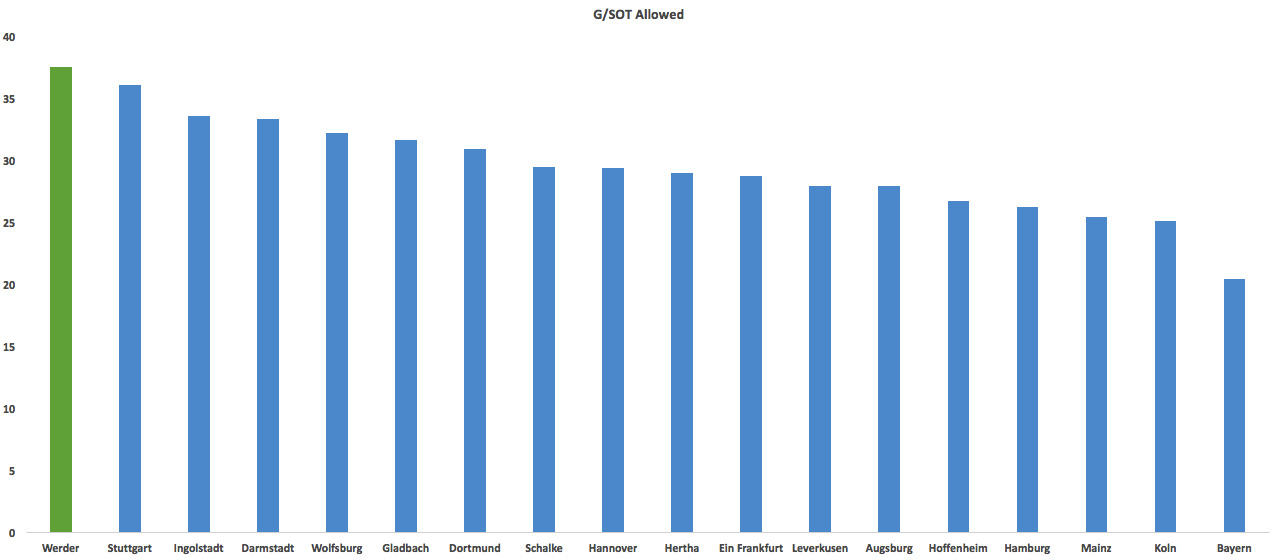 No team allowed more of the shots-on-target to go in than Werder did. And while there is some skill involved in your defensive G/SOT rate, it's mostly luck and there is a lack of convincing narrative as to why Werder's was so high. Stuttgart never blocked shots, had the highest SOT% allowed, and had the worst ratio of defenders to attackers in the league so I can buy they deserved their number. Werder blocked shots at 3rd highest rate in the league, were one of the best at pressuring shooters in a sampling of shots, and had a right around league average SOT% allowed. The simplest solution is Werder were just really unlucky last year and if you ran it back they would have allowed ~50 goals instead of 65. One Big Addition Last year Werder lacked the ability to slow down and control possession around the box before making a move to attempt a shot. You can see this on their passing map, where the redder areas show they complete fewer passes than expected based on start and end position.
No team allowed more of the shots-on-target to go in than Werder did. And while there is some skill involved in your defensive G/SOT rate, it's mostly luck and there is a lack of convincing narrative as to why Werder's was so high. Stuttgart never blocked shots, had the highest SOT% allowed, and had the worst ratio of defenders to attackers in the league so I can buy they deserved their number. Werder blocked shots at 3rd highest rate in the league, were one of the best at pressuring shooters in a sampling of shots, and had a right around league average SOT% allowed. The simplest solution is Werder were just really unlucky last year and if you ran it back they would have allowed ~50 goals instead of 65. One Big Addition Last year Werder lacked the ability to slow down and control possession around the box before making a move to attempt a shot. You can see this on their passing map, where the redder areas show they complete fewer passes than expected based on start and end position.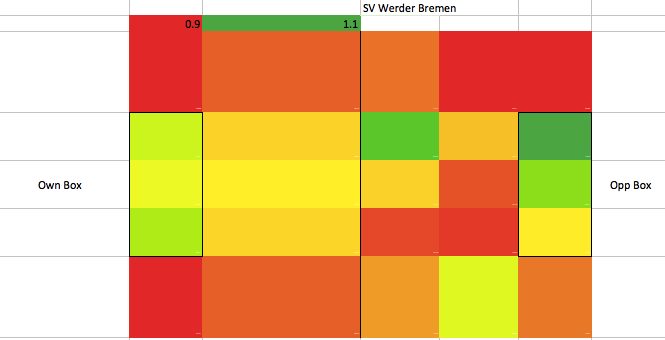 They got one of the best players out there to fix those problems in Max Kruse. He needs to be re-motivated, as he clearly wasn't last year at Wolfsburg, but his time at Gladbach was a massive success. At Gladbach he completed 68% of his 19 attacking area passes per game (start and end in 2 furthest right "blocks" on passing map). Comparing those numbers to Werder's players shows he might be an excellent fit.
They got one of the best players out there to fix those problems in Max Kruse. He needs to be re-motivated, as he clearly wasn't last year at Wolfsburg, but his time at Gladbach was a massive success. At Gladbach he completed 68% of his 19 attacking area passes per game (start and end in 2 furthest right "blocks" on passing map). Comparing those numbers to Werder's players shows he might be an excellent fit. 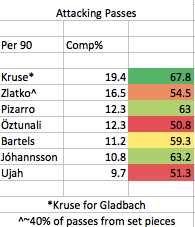 Kruse can give Werder an attacking centerpoint with the ball. Last year they had no one to focus on in the attacking third, and really no one all over the pitch with the only players over 40 passes a game the two center backs. With Kruse slotting in and Johannsson coming back, Werder are immediately a massively more talented team up top. I've loved Johannsson on the national team and thought he made a promising start to his career last season before his serious, long-term hip injury. It's a big question mark if he can come back full speed but if he does, he should help out a lot in attack. With those guys clicking alongside Pizarro up top, there is less pressure on set-piece extraordinaire Zlatko Junuzovic to create. Last year Zlatko was 2nd in the league in key passes, with 54 from set pieces. In a quirk you wouldn't find looking at the goal-scoring list, 4-goal Zlatko actually took more open play shots than 14-goal Pizarro did. Who Else in the midfield? Kruse needs service to set up in the final third so we need to sort out the midfield. For me, Sambou Yatabaré is not under consideration at all based on his abject performance last season. He wasn't playing centrally (mainly on the right) but still had the worst passing rating of any player in his area of the pitch. With no defensive contribution, he's not a guy who should see big minutes. That leaves 3 for 2 spots assuming Junuzovic is in the more attacking central role. Let's run a little statistical experiment, using last years stats to try and stitch together this years primary combo. Let's take a look at the raw numbers
Kruse can give Werder an attacking centerpoint with the ball. Last year they had no one to focus on in the attacking third, and really no one all over the pitch with the only players over 40 passes a game the two center backs. With Kruse slotting in and Johannsson coming back, Werder are immediately a massively more talented team up top. I've loved Johannsson on the national team and thought he made a promising start to his career last season before his serious, long-term hip injury. It's a big question mark if he can come back full speed but if he does, he should help out a lot in attack. With those guys clicking alongside Pizarro up top, there is less pressure on set-piece extraordinaire Zlatko Junuzovic to create. Last year Zlatko was 2nd in the league in key passes, with 54 from set pieces. In a quirk you wouldn't find looking at the goal-scoring list, 4-goal Zlatko actually took more open play shots than 14-goal Pizarro did. Who Else in the midfield? Kruse needs service to set up in the final third so we need to sort out the midfield. For me, Sambou Yatabaré is not under consideration at all based on his abject performance last season. He wasn't playing centrally (mainly on the right) but still had the worst passing rating of any player in his area of the pitch. With no defensive contribution, he's not a guy who should see big minutes. That leaves 3 for 2 spots assuming Junuzovic is in the more attacking central role. Let's run a little statistical experiment, using last years stats to try and stitch together this years primary combo. Let's take a look at the raw numbers  and a look at their forward passing connections (with labels of receivers removed for ease of reading)
and a look at their forward passing connections (with labels of receivers removed for ease of reading) 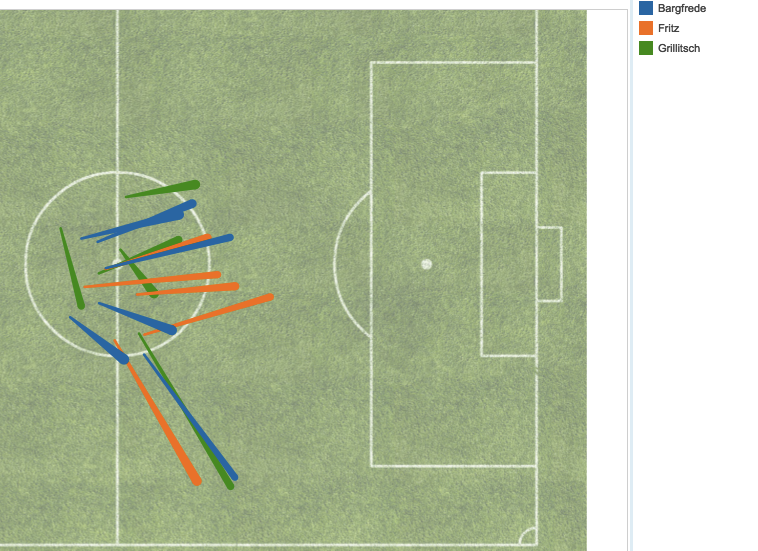 We can learn a lot from this. Bargfrede plays further back, is a tick worse passer and does the most defensive work of everyone. We see Fritz likes to connect further forward with central players and even though Grillitsch passes centrally slightly more, his most common connections are less vertical. With Zlatko and Kruse likely playing centrally ahead of these midfielders you'd like to have Fritz's central passing. Bargfrede doesn't bring much more to the table than Grillitsch and the ceiling is higher for the 20-year old so we stick Grillitsch in alongside Fritz on opening day. I'd like to think Fritz-Kruse is a much more reliable passing connection to bring us into the final third than anything we had last year. Grillitsch is alongside finding Bartels and other wide players with his longer balls while playing a bit deeper for clean-up purposes, add some broth, throw in a potato and baby, we got a stew going. Bargfrede for Fritz looks like the common switch when you are worried about opponents possession in midfield and don't want to worry about the 35-year olds legs as a defensive liability. UPDATE: Werder Bremen played Fritz/Zlatko in midfield and Yatabare in front and got overrun by Sportfreunde to the tune of 22 shots and a loss in the Cup to the third tier team. That possibility didn't cross my mind and should never be used again. If Skripnik keeps that up, I suspect Werder will need a new coach to help them reach their substantial ceiling. And in the tortoise and the hare story, the tortoise finishes above the hare. I'm not predicting that so if you were expecting exact alignment with the fairy tale and my preview, I apologize.
We can learn a lot from this. Bargfrede plays further back, is a tick worse passer and does the most defensive work of everyone. We see Fritz likes to connect further forward with central players and even though Grillitsch passes centrally slightly more, his most common connections are less vertical. With Zlatko and Kruse likely playing centrally ahead of these midfielders you'd like to have Fritz's central passing. Bargfrede doesn't bring much more to the table than Grillitsch and the ceiling is higher for the 20-year old so we stick Grillitsch in alongside Fritz on opening day. I'd like to think Fritz-Kruse is a much more reliable passing connection to bring us into the final third than anything we had last year. Grillitsch is alongside finding Bartels and other wide players with his longer balls while playing a bit deeper for clean-up purposes, add some broth, throw in a potato and baby, we got a stew going. Bargfrede for Fritz looks like the common switch when you are worried about opponents possession in midfield and don't want to worry about the 35-year olds legs as a defensive liability. UPDATE: Werder Bremen played Fritz/Zlatko in midfield and Yatabare in front and got overrun by Sportfreunde to the tune of 22 shots and a loss in the Cup to the third tier team. That possibility didn't cross my mind and should never be used again. If Skripnik keeps that up, I suspect Werder will need a new coach to help them reach their substantial ceiling. And in the tortoise and the hare story, the tortoise finishes above the hare. I'm not predicting that so if you were expecting exact alignment with the fairy tale and my preview, I apologize.
The Big Bundesliga Preview For 2016-17
Welcome back to Bundesliga lovers new and old. Welcome back to those apostates who give the league lip service as "Most Exciting League In the World" but aren't willing to put in the hard yards watching Köln to really earn your cred. Welcome to those wary English fans who deep down remain suspicious of the league and finally welcome to those with no knowledge of the league at all. There should be something here for any of you, from the true blue Augsburg fan to the general soccer fan with a passing interest. How this works is this is the main page with a quick overview article and then links to all the individual pieces. Also at the bottom here is a data dump with lots of stuff about each team that you can refer back to when reading about each team. I don't expect all of you to have a clear picture of how Schalke did last season, so there's numbers for context. This season is the most exciting and probably most momentous season for the Bundesliga in a while. Pep leaving is clearly the biggest story this season. Carlo Ancelotti is a fantastic coach but regression is almost certain. He's already indicated with how they played the Super Cup that the team won't play as possession-heavy of an approach as previous years, adding in a bit of variance for the rest of the league to play with. How big a step back Bayern takes will be one determining factor in the look of the league going forward. The second determining factor will be Dortmund in Year 2 of the Tuchel Era. He's been deemed a genius and his work last season was exceptional but he's got a challenge this season. He's lost arguably his 3 most important players. If he can weather that and have Dortmund put up a similar season as last year he will get his Certified Genius Card and set up years of titanic clashes in a sort of La Liga type environment. Leverkusen should be looking at the two teams ahead of them and expecting both to take a step back. The potential is there for a special season, the ingredients of coach, talent, and system are all there to legitimately be one of the top 10 teams in Europe. After that we have 3 big teams with multiple paths open to them. Gladbach are undergoing a style change and trying to establish themselves as a Champions League team over Wolfsburg, still persisting with Dieter Hecking, and a Schalke team with lots of young talent. One of these teams could challenge Leverkusen and one could finish 9th, it's hard to tell which one goes where right now. RB Leipzig bring a lot of friction to the league (see here and here for how their East German rivals treated them in a fantastic Cup match) but also bring last years Coach of the Year, a fantastic front office, Naby Keita and a bright future. Challenging Bayern within 5 years isn't unrealistic to some backers, this year is step one. After Leipzig and maybe Mainz, it's total chaos. Almost any team from 8th-17th could finish anywhere in there and I wouldn't be surprised. We have a recharged Hamburg, a Werder Bremen team coming off a bizarre statistical season, a high-powered Freiburg, the Precocious-Genius-in-Waiting coaching Hoffenheim, Ingolstadt minus Ralph and plenty more good stories who could threaten Europa League or be relegated. Also Frankfurt, forgettable Frankfurt. It should be a fantastic season starting this Friday and we've got all kinds of content to get you ready. Don't worry if it takes you all week to get through the previews or you skip out on the Hoffenheim one (there will be a public shaming for all who do not join the Cult of Nagelsmann), but hopefully you will leave these pages more informed and excited for the Bundesliga. Any questions, comments, or predictions you want to share let me know in the comments or @SaturdayOnCouch on twitter. The Links The Favorites: Bayern Munich A Player-by-Player Dortmund Breakdown Leverkusen's Big Chance Gladbach: Leaving Protectionism Behind Can Schalke Take Another Step Forward? Way Out Wide With Wolfsburg Tortoise and the Hare: Hertha Berlin and Werder Bremen The Bundesliga's Mobile Middle Class: Mainz, Hamburg, and Hoffenheim Risers and Fallers? Augsburg, Köln, Frankfurt, RB Leipzig, and Freiburg Darmstadt and Ingolstadt Vol. 2: Großer Than Before Predicted Table And Assorted Lists Tip for readers: keep these charts at hand for reference when you move from team to team in case you want to just see pure data. I might repeat some of these numbers in each article but you can learn a lot more and it could provide some context about a team simply looking at these numbers. Offensive Raw Numbers 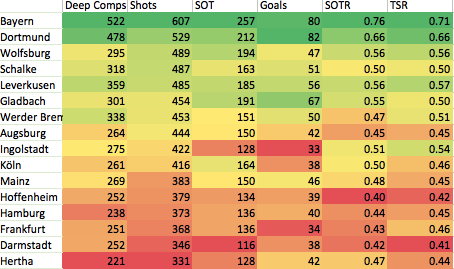 Offensive Stylistic Numbers
Offensive Stylistic Numbers  Defensive Raw Numbers
Defensive Raw Numbers 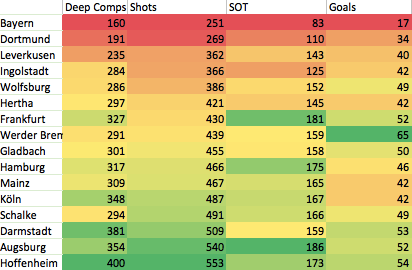 Defensive Stylistic Numbers
Defensive Stylistic Numbers  As always thanks to OPTA for the data.
As always thanks to OPTA for the data. 